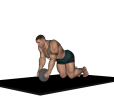 Ab - Roller
Ab - Roller
Benefits: This exercise will give you a well-defined mid-section.
Purpose: This exercise strengthens the abdominal muscles.
Intermediate Abdominals Shoulders Strength Ab Roller Pull Compound Gym
General Info: The abs can be divided into the abdominals themselves and the obliques. The obliques are the outer abs and are used in twisting movements. For the sake of exercising, the abdominals are sometimes divided into upper abs and lower abs (this is not a technical division but something for exercising). Both upper and lower abs are used in straight line ab exercises while the upper abs are also involved in twisting movements.
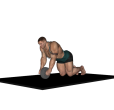 Ab - Roller Alternate
Ab - Roller Alternate
Benefits: This exercise will give you a well-defined mid-section, especially for the obliques.
Purpose: This exercise strengthens the abdominal muscles.
Abdominals Obliques Shoulders Strength Ab Roller Pull Compound Gym
General Info: The abs can be divided into the abdominals themselves and the obliques. The obliques are the outer abs and are used in twisting movements. For the sake of exercising, the abdominals are sometimes divided into upper abs and lower abs (this is not a technical division but something for exercising). Both upper and lower abs are used in straight line ab exercises while the upper abs are also involved in twisting movements.
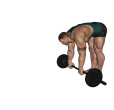 Ab Roller - Barbell
Ab Roller - Barbell
Benefits: This exercise will give you a well-defined mid-section.
Purpose: This exercise strengthens the abdominal muscles.
Intermediate Abdominals Shoulders Strength Barbell Pull Compound Gym
General Info: The abs can be divided into the abdominals themselves and the obliques. The obliques are the outer abs and are used in twisting movements. For the sake of exercising, the abdominals are sometimes divided into upper abs and lower abs (this is not a technical division but something for exercising). Both upper and lower abs are used in straight line ab exercises while the upper abs are also involved in twisting movements.
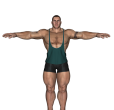 Arm Circles - Fundamental
Arm Circles - Fundamental
Benefits: This exercise tones and tightens your upper arms and shoulders.
Purpose: This exercise focuses on working the entire shoulder joint and makes an excellent warm-up before any resistance or weight training involving the shoulders.
Beginner Shoulders Traps Stretching Body Only Gym Home
General Info: Air Circles require little time, yet can give good benefits when done regularly. They can be done almost anywhere, without special equipment. The three heads of the deltoid muscles require regular movement to ensure their flexibility and mobility.
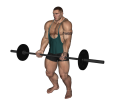 Barbell Curl - Basic
Barbell Curl - Basic
Benefits: This exercise works both heads of the biceps with a heavier weight than can typically be done with dumbbells. Moving the elbows out at the top of the movement ensures that the long head of the biceps (which crosses the shoulder joint) is also worked well.
Purpose: This exercise is used to target the biceps muscle to develop size, definition, strength, endurance and power.
Beginner Biceps Forearms Shoulders Strength Barbell Pull Gym
General Info: The biceps is a straight muscle with two heads. The long head of the biceps crosses both the elbow and the shoulder joint. It bends the elbow and raises the arm forward at the shoulder. The short head crosses the elbow joint and, in conjunction with the brachioradialis, supinates the hand.
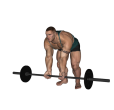 Barbell Curl - Bent Over
Barbell Curl - Bent Over
Benefits: This exercise is similar in effect to the Spider curl and does a good job of placing maximum tension on the biceps in the fully contracted position.
Purpose: This exercise works the biceps muscles but focuses also on the brachioradialis (a muscle that crosses the elbow joint and assists in rotating the forearm).
Beginner Biceps Forearms Shoulders Strength Barbell Pull Gym
General Info: The biceps is a straight muscle that has two heads. The long head crosses both the elbow and the shoulder joints. It bends the arm at the elbow and raises the arm forward at the shoulder. The short head crosses the elbow joint and, in conjunction with the brachioradialis, supinates the hand.
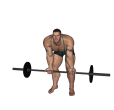 Barbell Curl - Bent Over Close Grip
Barbell Curl - Bent Over Close Grip
Benefits: This exercise is similar in effect to the Spider curl and does a good job of placing maximum tension on the biceps in the fully contracted position.
Purpose: This exercise works the biceps muscles but focuses also on the brachioradialis (a muscle that crosses the elbow joint and assists in rotating the forearm).
Beginner Biceps Forearms Shoulders Strength Barbell Pull Gym
General Info: The biceps is a straight muscle that has two heads. The long head crosses both the elbow and the shoulder joints. It bends the arm at the elbow and raises the arm forward at the shoulder. The short head crosses the elbow joint and, in conjunction with the brachioradialis, supinates the hand.
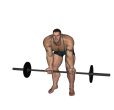 Barbell Curl - Bent Over Medium Grip
Barbell Curl - Bent Over Medium Grip
Benefits: This exercise is similar in effect to the Spider curl and does a good job of placing maximum tension on the biceps in the fully contracted position.
Purpose: This exercise works the biceps muscles but focuses also on the brachioradialis (a muscle that crosses the elbow joint and assists in rotating the forearm).
Beginner Biceps Forearms Shoulders Strength Barbell Pull Gym
General Info: The biceps is a straight muscle which has two heads. The long head crosses both the elbow and the shoulder joints. It bends the arm at the elbow and raises the arm forward at the shoulder. The short head crosses the elbow joint and, in conjunction with the brachioradialis, supinates the hand.
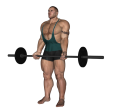 Barbell Curl - Drag
Barbell Curl - Drag
Benefits: This exercise works both heads of the biceps with a heavier weight than can typically be done with dumbbells. This exercise will go a long way toward eliminating anterior deltoid involvement as you curl, helping you isolate the working muscle in a way that the standard barbell may not.
Purpose: This exercise is used to target the biceps muscle to develop size, definition, strength, endurance and power.
Intermediate Biceps Forearms Shoulders Strength Barbell Pull Compound Gym
General Info: The biceps is a straight muscle with two heads. The long head of the biceps crosses both the elbow and the shoulder joint. It bends the elbow and raises the arm forward at the shoulder. The short head crosses the elbow joint and, in conjunction with the brachioradialis, supinates the hand.
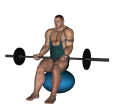 Barbell Curl - Fitness Ball
Barbell Curl - Fitness Ball
Benefits: This exercise isolates the biceps so that momentum does not come into play.
Purpose: This exercise strengthens the biceps.
Beginner Biceps Forearms Shoulders Traps Strength Barbell Fitness Ball Pull Gym
General Info: The biceps muscle is a straight muscle with 2 heads. The long head crosses both the elbow and shoulder joints and bends the elbow and raises the arm forward at the shoulder. The short head of the biceps crosses the elbow joint and, in conjunction with the brachioradialis, supinates the hand..
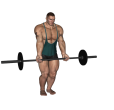 Barbell Curl - Narrow Stance
Barbell Curl - Narrow Stance
Benefits: This exercise works both heads of the biceps with a heavier weight than can typically be done with dumbbells. The narrow stance forces the stabilizing muscles to work harder in keeping the body upright.
Purpose: This exercise is used to target the biceps muscle to develop size, definition, strength, endurance and power.
Beginner Biceps Forearms Shoulders Strength Barbell Pull Gym
General Info: The biceps is a straight muscle with two heads. The long head of the biceps crosses both the elbow and the shoulder joint. It bends the elbow and raises the arm forward at the shoulder. The short head crosses the elbow joint and, in conjunction with the brachioradialis, supinates the hand.
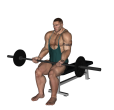 Barbell Curl - Seated
Barbell Curl - Seated
Benefits: This exercise isolates the biceps so that momentum does not come into play.
Purpose: This exercise strengthens the biceps.
Beginner Biceps Forearms Shoulders Traps Strength Barbell Flat Bench Pull Gym
General Info: The biceps muscle is a straight muscle with 2 heads. The long head crosses both the elbow and shoulder joints and bends the elbow and raises the arm forward at the shoulder. The short head of the biceps crosses the elbow joint and, in conjunction with the brachioradialis, supinates the hand..
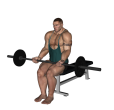 Barbell Curl - Seated Narrow Stance
Barbell Curl - Seated Narrow Stance
Benefits: This exercise isolates the biceps so that momentum does not come into play. the narrow stance forces the stabilizer muscles to assist in keeping the body upright.
Purpose: This exercise strengthens the biceps.
Beginner Biceps Forearms Shoulders Traps Strength Barbell Flat Bench Pull Gym
General Info: The biceps muscle is a straight muscle with 2 heads. The long head crosses both the elbow and shoulder joints and bends the elbow and raises the arm forward at the shoulder. The short head of the biceps crosses the elbow joint and, in conjunction with the brachioradialis, supinates the hand..
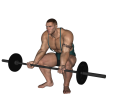 Barbell Curl - Squat
Barbell Curl - Squat
Benefits: This exercise isolates the biceps so that momentum does not come into play.
Purpose: This exercise strengthens the biceps.
Intermediate Biceps Forearms Shoulders Traps Strength Barbell Pull Gym
General Info: The biceps muscle is a straight muscle with 2 heads. The long head crosses both the elbow and shoulder joints and bends the elbow and raises the arm forward at the shoulder. The short head of the biceps crosses the elbow joint and, in conjunction with the brachioradialis, supinates the hand..
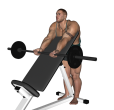 Barbell Curl - Standing Incline
Barbell Curl - Standing Incline
Benefits: This exercise works both heads of the biceps with a heavier weight than can typically be done with dumbbells. Placing the triceps on the incline bench makes the exercise similar to a preacher curl, which isolated the biceps.
Purpose: This exercise is used to target the biceps muscle to develop size, definition, strength, endurance and power.
Beginner Biceps Forearms Shoulders Strength Barbell Incline Bench Pull Gym
General Info: The biceps is a straight muscle with two heads. The long head of the biceps crosses both the elbow and the shoulder joint. It bends the elbow and raises the arm forward at the shoulder. The short head crosses the elbow joint and, in conjunction with the brachioradialis, supinates the hand.
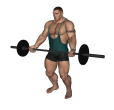 Barbell Curl - Wide Grip Standing
Barbell Curl - Wide Grip Standing
Benefits: This exercise works both heads of the biceps with a heavier weight than can typically be done with dumbbells. The wide grip gives you a different angle and feel to the exercise.
Purpose: This exercise is used to target the biceps muscle to develop size, definition, strength, endurance and power.
Beginner Biceps Forearms Shoulders Strength Barbell Pull Gym
General Info: The biceps is a straight muscle with two heads. The long head of the biceps crosses both the elbow and the shoulder joint. It bends the elbow and raises the arm forward at the shoulder. The short head crosses the elbow joint and, in conjunction with the brachioradialis, supinates the hand.
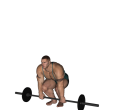 Barbell Press - Clean
Barbell Press - Clean
Benefits: This exercise also works the shoulders very well.
Purpose: To develop core strength of the lower and upper body.
Quads Glutes Hamstrings Calves Shoulders Strength Barbell Push Compound Gym
General Info: The quads are a set of four muscles in the upper front thigh. All four muscles work to straighten the knee. One of the four (rectus femoris) also helps to bend the hip. Squats are considered a vital exercise for increasing the strength and size of the legs and butt.
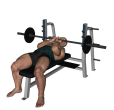 Barbell Press - Close Grip
Barbell Press - Close Grip
Benefits: This exercise works both heads of the triceps with a heavier weight than can typically be done with dumbbells. Note that the wider apart that you position your hands, the more the exercise works the chest and less the triceps.
Purpose: This exercise is used to target the triceps muscle to develop size, definition, strength, endurance and power.
Beginner Triceps Chest Shoulders Strength Barbell Flat Bench Push Compound Gym
General Info: The triceps is a straight muscle with three heads. The long head straightens the elbow, adducts the shoulder (brings it from a side position to the body) and extends the shoulder (brings the arm from a front position down to the body). The lateral head (outer head) straightens the elbow. The medial head also straightens the elbow.
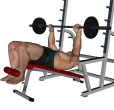 Barbell Press - Decline
Barbell Press - Decline
Benefits: This exercise works the chest muscles with a focus on your lower pecs.
Purpose: This exercise is used to target the lower pecs muscle to develop size, definition, strength, endurance and power.
Beginner Chest Triceps Shoulders Strength Barbell Decline Bench Push Compound Gym
General Info: The chest is composed of the Pectoralis Major and the Pectoralis Minor. The Pec Major attaches to the upper arm and pulls the upper arm across the chest. The Pec Minor lies mostly underneath the Pec Major and draws the shoulder blade down and forward.
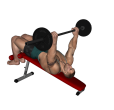 Barbell Press - Decline Guillotine
Barbell Press - Decline Guillotine
Benefits: This exercise works the chest muscles with a focus on your lower pecs.
Purpose: This exercise is used to target the lower pecs muscle to develop size, definition, strength, endurance and power.
Beginner Chest Triceps Shoulders Strength Barbell Decline Bench Push Compound Gym
General Info: The chest is composed of the Pectoralis Major and the Pectoralis Minor. The Pec Major attaches to the upper arm and pulls the upper arm across the chest. The Pec Minor lies mostly underneath the Pec Major and draws the shoulder blade down and forward.
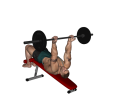 Barbell Press - Decline Reverse
Barbell Press - Decline Reverse
Benefits: This exercise works the chest muscles with a focus on your lower pecs.
Purpose: This exercise is used to target the lower pecs muscle to develop size, definition, strength, endurance and power.
Beginner Chest Triceps Shoulders Strength Barbell Decline Bench Push Compound Gym
General Info: The chest is composed of the Pectoralis Major and the Pectoralis Minor. The Pec Major attaches to the upper arm and pulls the upper arm across the chest. The Pec Minor lies mostly underneath the Pec Major and draws the shoulder blade down and forward.
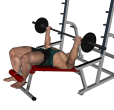 Barbell Press - Decline Reverse Wide Grip
Barbell Press - Decline Reverse Wide Grip
Benefits: This exercise works the chest muscles with a focus on your lower pecs.
Purpose: This exercise is used to target the lower pecs muscle to develop size, definition, strength, endurance and power.
Beginner Chest Triceps Shoulders Strength Barbell Decline Bench Push Compound Gym
General Info: The chest is composed of the Pectoralis Major and the Pectoralis Minor. The Pec Major attaches to the upper arm and pulls the upper arm across the chest. The Pec Minor lies mostly underneath the Pec Major and draws the shoulder blade down and forward.
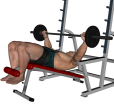 Barbell Press - Decline Wide Grip
Barbell Press - Decline Wide Grip
Benefits: This exercise works the chest muscles with a focus on your lower pecs.
Purpose: This exercise is used to target the lower pecs muscle to develop size, definition, strength, endurance and power.
Beginner Chest Triceps Shoulders Strength Barbell Decline Bench Push Compound Gym
General Info: The chest is composed of the Pectoralis Major and the Pectoralis Minor. The Pec Major attaches to the upper arm and pulls the upper arm across the chest. The Pec Minor lies mostly underneath the Pec Major and draws the shoulder blade down and forward.
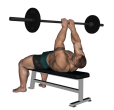 Barbell Press - Flat Bench Close Grip
Barbell Press - Flat Bench Close Grip
Benefits: This exercise works both heads of the triceps with a heavier weight than can typically be done with dumbbells. The closer you position your hands the more the exercise works the triceps.
Purpose: This exercise is used to target the triceps muscle to develop size, definition, strength, endurance and power.
Beginner Triceps Chest Shoulders Strength Barbell Flat Bench Push Compound Gym
General Info: The triceps is a straight muscle with three heads. The long head straightens the elbow, adducts the shoulder (brings it from a side position to the body) and extends the shoulder (brings the arm from a front position down to the body). The lateral head (outer head) straightens the elbow. The medial head also straightens the elbow.
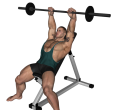 Barbell Press - Incline
Barbell Press - Incline
Benefits: This exercise works the chest muscles with a focus on your upper pecs. You can usually set the incline bench to different angles from the horizontal. The more of an angle you use, the more you are working the upper pecs.
Purpose: This exercise is used to target the upper pecs muscle to develop size, definition, strength, endurance and power.
Beginner Chest Triceps Shoulders Strength Barbell Incline Bench Push Compound Gym
General Info: The chest is composed of the Pectoralis Major and the Pectoralis Minor. The Pec Major attaches to the upper arm and pulls the upper arm across the chest. The Pec Minor lies mostly underneath the Pec Major and draws the shoulder blade down and forward.
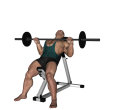 Barbell Press - Incline Medium Grip
Barbell Press - Incline Medium Grip
Benefits: This exercise works the chest muscles with a focus on your upper pecs.
Purpose: This exercise is used to target the upper pecs muscle to develop size, definition, strength, endurance and power.
Beginner Chest Triceps Shoulders Strength Barbell Incline Bench Push Compound Gym
General Info: The chest is composed of the Pectoralis Major and the Pectoralis Minor. The Pec Major attaches to the upper arm and pulls the upper arm across the chest. The Pec Minor lies mostly underneath the Pec Major and draws the shoulder blade down and forward.
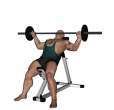 Barbell Press - Incline Wide Grip
Barbell Press - Incline Wide Grip
Benefits: This exercise works the chest muscles with a focus on your upper pecs.
Purpose: This exercise is used to target the upper pecs muscle to develop size, definition, strength, endurance and power.
Beginner Chest Triceps Shoulders Strength Barbell Incline Bench Push Compound Gym
General Info: The chest is composed of the Pectoralis Major and the Pectoralis Minor. The Pec Major attaches to the upper arm and pulls the upper arm across the chest. The Pec Minor lies mostly underneath the Pec Major and draws the shoulder blade down and forward.
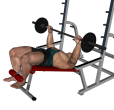 Barbell Press - Wide Grip Decline
Barbell Press - Wide Grip Decline
Benefits: This exercise works the chest muscles with a focus on your lower pecs.
Purpose: This exercise is used to target the lower pecs muscle to develop size, definition, strength, endurance and power.
Beginner Chest Triceps Shoulders Strength Barbell Decline Bench Push Compound Gym
General Info: The chest is composed of the Pectoralis Major and the Pectoralis Minor. The Pec Major attaches to the upper arm and pulls the upper arm across the chest. The Pec Minor lies mostly underneath the Pec Major and draws the shoulder blade down and forward.
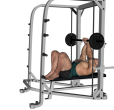 Bench Press - Close Grip Smith Machine Feet Up
Bench Press - Close Grip Smith Machine Feet Up
Benefits: This exercise works both heads of the triceps with a heavier weight than can typically be done with dumbbells.
Purpose: This exercise is used to target the triceps muscle to develop size, definition, strength, endurance and power.
Beginner Triceps Chest Shoulders Strength Smith Machine Flat Bench Push Compound Gym
General Info: The triceps is a straight muscle with three heads. The long head straightens the elbow, adducts the shoulder (brings it from a side position to the body) and extends the shoulder (brings the arm from a front position down to the body). The lateral head (outer head) straightens the elbow. The medial head also straightens the elbow.
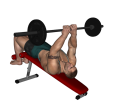 Bench Press - Decline Skull Crusher
Bench Press - Decline Skull Crusher
Benefits: This exercise works both heads of the triceps with a heavier weight than can typically be done with dumbbells.
Purpose: This exercise is used to target the triceps muscle to develop size, definition, strength, endurance and power.
Beginner Triceps Chest Shoulders Strength Barbell Decline Bench Push Compound Gym
General Info: The triceps is a straight muscle with three heads. The long head straightens the elbow, adducts the shoulder (brings it from a side position to the body) and extends the shoulder (brings the arm from a front position down to the body). The lateral head (outer head) straightens the elbow. The medial head also straightens the elbow.
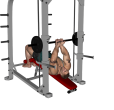 Bench Press - Smith Decline Reverse Close
Bench Press - Smith Decline Reverse Close
Benefits: This exercise works both heads of the triceps with a heavier weight than can typically be done with dumbbells. It also works the lower spec. The reverse grip makes the exercise more difficult.
Purpose: This exercise is used to target the triceps muscle to develop size, definition, strength, endurance and power.
Beginner Triceps Chest Shoulders Strength Smith Machine Decline Bench Push Compound Gym
General Info: The triceps is a straight muscle with three heads. The long head straightens the elbow, adducts the shoulder (brings it from a side position to the body) and extends the shoulder (brings the arm from a front position down to the body). The lateral head (outer head) straightens the elbow. The medial head also straightens the elbow.
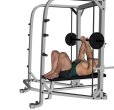 Bench Press - Smith Feet Up Close Grip Reverse
Bench Press - Smith Feet Up Close Grip Reverse
Benefits: This exercise works both heads of the triceps with a heavier weight than can typically be done with dumbbells.
Purpose: This exercise is used to target the triceps muscle to develop size, definition, strength, endurance and power.
Beginner Triceps Chest Shoulders Strength Smith Machine Flat Bench Push Compound Gym
General Info: The triceps is a straight muscle with three heads. The long head straightens the elbow, adducts the shoulder (brings it from a side position to the body) and extends the shoulder (brings the arm from a front position down to the body). The lateral head (outer head) straightens the elbow. The medial head also straightens the elbow.
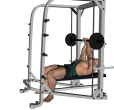 Bench Press - Smith Machine Close Grip
Bench Press - Smith Machine Close Grip
Benefits: This exercise works both heads of the triceps with a heavier weight than can typically be done with dumbbells.
Purpose: This exercise is used to target the triceps muscle to develop size, definition, strength, endurance and power.
Beginner Triceps Chest Shoulders Strength Smith Machine Flat Bench Push Compound Gym
General Info: The triceps is a straight muscle with three heads. The long head straightens the elbow, adducts the shoulder (brings it from a side position to the body) and extends the shoulder (brings the arm from a front position down to the body). The lateral head (outer head) straightens the elbow. The medial head also straightens the elbow.
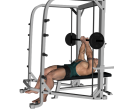 Bench Press - Smith Machine Close Grip Reverse
Bench Press - Smith Machine Close Grip Reverse
Benefits: This exercise works both heads of the triceps with a heavier weight than can typically be done with dumbbells. The reverse grip makes this exercise more difficult.
Purpose: This exercise is used to target the triceps muscle to develop size, definition, strength, endurance and power.
Beginner Triceps Chest Shoulders Strength Smith Machine Push Compound Gym
General Info: The triceps is a straight muscle with three heads. The long head straightens the elbow, adducts the shoulder (brings it from a side position to the body) and extends the shoulder (brings the arm from a front position down to the body). The lateral head (outer head) straightens the elbow. The medial head also straightens the elbow.
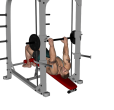 Bench Press - Smith Machine Decline
Bench Press - Smith Machine Decline
Benefits: This exercise works the chest muscles with a focus on your lower pecs.
Purpose: This exercise is used to target the lower pecs muscle to develop size, definition, strength, endurance and power.
Beginner Chest Triceps Shoulders Strength Smith Machine Decline Bench Push Compound Gym
General Info: The chest is composed of the Pectoralis Major and the Pectoralis Minor. The Pec Major attaches to the upper arm and pulls the upper arm across the chest. The Pec Minor lies mostly underneath the Pec Major and draws the shoulder blade down and forward.
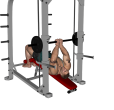 Bench Press - Smith Machine Decline Close
Bench Press - Smith Machine Decline Close
Benefits: The exercise eliminates isolates the triceps.
Purpose: This exercise works primarily the triceps.
Beginner Chest Triceps Shoulders Strength Smith Machine Decline Bench Push Compound Gym
General Info: The triceps is a straight muscle with three heads. The long head straightens the elbow, adducts the shoulder (brings it from a side position to the body) and extends the shoulder (brings the arm from a front position down to the body). The lateral head (outer head) straightens the elbow. The medial head also straightens the elbow.
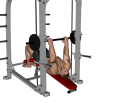 Bench Press - Smith Machine Decline Reverse
Bench Press - Smith Machine Decline Reverse
Benefits: This exercise works the chest muscles with a focus on your lower pecs.
Purpose: This exercise is used to target the lower pecs muscle to develop size, definition, strength, endurance and power.
Beginner Chest Triceps Shoulders Strength Smith Machine Decline Bench Push Compound Gym
General Info: The chest is composed of the Pectoralis Major and the Pectoralis Minor. The Pec Major attaches to the upper arm and pulls the upper arm across the chest. The Pec Minor lies mostly underneath the Pec Major and draws the shoulder blade down and forward.
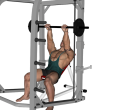 Bench Press - Smith Machine Incline
Bench Press - Smith Machine Incline
Benefits: This exercise works the chest muscles with a focus on your upper pecs.
Purpose: This exercise is used to target the upper pecs muscle to develop size, definition, strength, endurance and power.
Beginner Chest Triceps Shoulders Strength Smith Machine Incline Bench Push Compound Gym
General Info: The chest is composed of the Pectoralis Major and the Pectoralis Minor. The Pec Major attaches to the upper arm and pulls the upper arm across the chest. The Pec Minor lies mostly underneath the Pec Major and draws the shoulder blade down and forward.
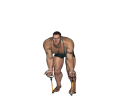 Biceps Curl - Bent Over Resistance Tube
Biceps Curl - Bent Over Resistance Tube
Benefits: This exercise is similar in effect to the Spider curl and does a good job of placing maximum tension on the biceps in the fully contracted position.
Purpose: This exercise works the biceps muscles but focuses also on the brachioradialis (a muscle that crosses the elbow joint and assists in rotating the forearm).
Beginner Biceps Forearms Shoulders Strength Resistance Tube Pull Gym Home
General Info: The biceps is a straight muscle which has two heads. The long head crosses both the elbow and the shoulder joints. It bends the arm at the elbow and raises the arm forward at the shoulder. The short head crosses the elbow joint and, in conjunction with the brachioradialis, supinates the hand.
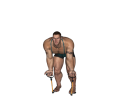 Biceps Curl - Bent Over Resistance Tube Alternate
Biceps Curl - Bent Over Resistance Tube Alternate
Benefits: This exercise is similar in effect to the Spider curl and does a good job of placing maximum tension on the biceps in the fully contracted position.
Purpose: This exercise works the biceps muscles but focuses also on the brachioradialis (a muscle that crosses the elbow joint and assists in rotating the forearm).
Beginner Biceps Forearms Shoulders Strength Resistance Tube Pull Gym Home
General Info: The biceps is a straight muscle which has two heads. The long head crosses both the elbow and the shoulder joints. It bends the arm at the elbow and raises the arm forward at the shoulder. The short head crosses the elbow joint and, in conjunction with the brachioradialis, supinates the hand.
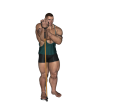 Biceps Curl - Resistance Tube Single
Biceps Curl - Resistance Tube Single
Benefits: This exercise works both heads of the biceps with a heavier weight than can typically be done with dumbbells.
Purpose: This exercise is used to target the biceps muscle to develop size, definition, strength, endurance and power.
Beginner Biceps Forearms Shoulders Strength Resistance Tube Pull Gym Home
General Info: The biceps is a straight muscle with two heads. The long head of the biceps crosses both the elbow and the shoulder joint. It bends the elbow and raises the arm forward at the shoulder. The short head crosses the elbow joint and, in conjunction with the brachioradialis, supinates the hand.
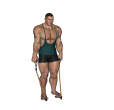 Biceps Curl - Resistance Tube Standing
Biceps Curl - Resistance Tube Standing
Benefits: This exercise works both heads of the biceps with a heavier weight than can typically be done with dumbbells.
Purpose: This exercise is used to target the biceps muscle to develop size, definition, strength, endurance and power.
Beginner Biceps Forearms Shoulders Strength Resistance Tube Pull Gym
General Info: The biceps is a straight muscle with two heads. The long head of the biceps crosses both the elbow and the shoulder joint. It bends the elbow and raises the arm forward at the shoulder. The short head crosses the elbow joint and, in conjunction with the brachioradialis, supinates the hand.
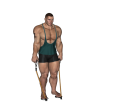 Biceps Curl - Resistance Tube Standing Alternate
Biceps Curl - Resistance Tube Standing Alternate
Benefits: This exercise works both heads of the biceps with a heavier weight than can typically be done with dumbbells.
Purpose: This exercise is used to target the biceps muscle to develop size, definition, strength, endurance and power.
Beginner Biceps Forearms Shoulders Strength Resistance Tube Pull Gym Home
General Info: The biceps is a straight muscle with two heads. The long head of the biceps crosses both the elbow and the shoulder joint. It bends the elbow and raises the arm forward at the shoulder. The short head crosses the elbow joint and, in conjunction with the brachioradialis, supinates the hand.
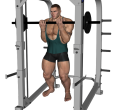 Biceps Curl - Smith Machine
Biceps Curl - Smith Machine
Benefits: This exercise works both heads of the biceps with a heavier weight than can typically be done with dumbbells.
Purpose: This exercise is used to target the biceps muscle to develop size, definition, strength, endurance and power.
Beginner Biceps Forearms Shoulders Strength Smith Machine Pull Gym
General Info: The biceps is a straight muscle with two heads. The long head of the biceps crosses both the elbow and the shoulder joint. It bends the elbow and raises the arm forward at the shoulder. The short head crosses the elbow joint and, in conjunction with the brachioradialis, supinates the hand.
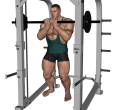 Biceps Curl - Smith Machine Close Grip
Biceps Curl - Smith Machine Close Grip
Benefits: This exercise works both heads of the biceps with a heavier weight than can typically be done with dumbbells.
Purpose: This exercise is used to target the biceps muscle to develop size, definition, strength, endurance and power.
Beginner Biceps Forearms Shoulders Strength Smith Machine Pull Gym
General Info: The biceps is a straight muscle with two heads. The long head of the biceps crosses both the elbow and the shoulder joint. It bends the elbow and raises the arm forward at the shoulder. The short head crosses the elbow joint and, in conjunction with the brachioradialis, supinates the hand.
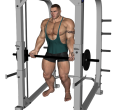 Biceps Curl - Smith Machine Wide Grip
Biceps Curl - Smith Machine Wide Grip
Benefits: This exercise works both heads of the biceps with a heavier weight than can typically be done with dumbbells.
Purpose: This exercise is used to target the biceps muscle to develop size, definition, strength, endurance and power.
Beginner Biceps Forearms Shoulders Strength Smith Machine Pull Gym
General Info: The biceps is a straight muscle with two heads. The long head of the biceps crosses both the elbow and the shoulder joint. It bends the elbow and raises the arm forward at the shoulder. The short head crosses the elbow joint and, in conjunction with the brachioradialis, supinates the hand.
 Biceps Curl - Squat Water Bottle
Biceps Curl - Squat Water Bottle
Benefits: This exercise isolates the biceps so that momentum does not come into play.
Purpose: This exercise strengthens the biceps.
Intermediate Biceps Forearms Shoulders Traps Strength Water Bottle Pull Home
General Info: The biceps muscle is a straight muscle with 2 heads. The long head crosses both the elbow and shoulder joints and bends the elbow and raises the arm forward at the shoulder. The short head of the biceps crosses the elbow joint and, in conjunction with the brachioradialis, supinates the hand..
 Biceps Curl - Squat Water Bottle Alternate
Biceps Curl - Squat Water Bottle Alternate
Benefits: This exercise isolates the biceps so that momentum does not come into play.
Purpose: This exercise strengthens the biceps.
Intermediate Biceps Forearms Shoulders Traps Strength Water Bottle Pull Home
General Info: The biceps muscle is a straight muscle with 2 heads. The long head crosses both the elbow and shoulder joints and bends the elbow and raises the arm forward at the shoulder. The short head of the biceps crosses the elbow joint and, in conjunction with the brachioradialis, supinates the hand..
 Biceps Curl - Squat Water Bottle Single
Biceps Curl - Squat Water Bottle Single
Benefits: This exercise isolates the biceps so that momentum does not come into play.
Purpose: This exercise strengthens the biceps.
Intermediate Biceps Forearms Shoulders Traps Strength Water Bottle Pull Home
General Info: The biceps muscle is a straight muscle with 2 heads. The long head crosses both the elbow and shoulder joints and bends the elbow and raises the arm forward at the shoulder. The short head of the biceps crosses the elbow joint and, in conjunction with the brachioradialis, supinates the hand..
 Biceps Curl - Squat Water Bottle Single Reverse
Biceps Curl - Squat Water Bottle Single Reverse
Benefits: This exercise isolates the biceps so that momentum does not come into play.
Purpose: This exercise strengthens the biceps.
Intermediate Biceps Forearms Shoulders Traps Strength Water Bottle Pull Home
General Info: The biceps muscle is a straight muscle with 2 heads. The long head crosses both the elbow and shoulder joints and bends the elbow and raises the arm forward at the shoulder. The short head of the biceps crosses the elbow joint and, in conjunction with the brachioradialis, supinates the hand..
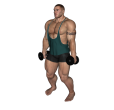 Biceps Curl - Standing Inner
Biceps Curl - Standing Inner
Benefits: This exercise works both heads of the biceps.
Purpose: This exercise is used to target the biceps muscle to develop size, definition, strength, endurance and power.
Beginner Biceps Forearms Shoulders Strength Dumbbell Pull Gym
General Info: The biceps is a straight muscle with two heads. The long head of the biceps crosses both the elbow and the shoulder joint. It bends the elbow and raises the arm forward at the shoulder. The short head crosses the elbow joint and, in conjunction with the brachioradialis, supinates the hand.
 Biceps Curl - Standing Water Bottle
Biceps Curl - Standing Water Bottle
Benefits: This exercise works both heads of the biceps with a heavier weight than can typically be done with dumbbells.
Purpose: This exercise is used to target the biceps muscle to develop size, definition, strength, endurance and power.
Beginner Biceps Forearms Shoulders Strength Water Bottle Pull Home
General Info: The biceps is a straight muscle with two heads. The long head of the biceps crosses both the elbow and the shoulder joint. It bends the elbow and raises the arm forward at the shoulder. The short head crosses the elbow joint and, in conjunction with the brachioradialis, supinates the hand.
 Biceps Curl - Standing Water Bottle Reverse Alternate
Biceps Curl - Standing Water Bottle Reverse Alternate
Benefits: This exercise works both heads of the biceps with a heavier weight than can typically be done with dumbbells.
Purpose: This exercise is used to target the biceps muscle to develop size, definition, strength, endurance and power.
Beginner Biceps Forearms Shoulders Strength Water Bottle Pull Home
General Info: The biceps is a straight muscle with two heads. The long head of the biceps crosses both the elbow and the shoulder joint. It bends the elbow and raises the arm forward at the shoulder. The short head crosses the elbow joint and, in conjunction with the brachioradialis, supinates the hand.
 Biceps Curl - Standing Water Bottle Single
Biceps Curl - Standing Water Bottle Single
Benefits: This exercise works both heads of the biceps with a heavier weight than can typically be done with dumbbells.
Purpose: This exercise is used to target the biceps muscle to develop size, definition, strength, endurance and power.
Beginner Biceps Forearms Shoulders Strength Water Bottle Pull Home
General Info: The biceps is a straight muscle with two heads. The long head of the biceps crosses both the elbow and the shoulder joint. It bends the elbow and raises the arm forward at the shoulder. The short head crosses the elbow joint and, in conjunction with the brachioradialis, supinates the hand.
 Biceps Curl - Suspended Chains
Biceps Curl - Suspended Chains
Benefits: This exercise is done with the addition of chains. The primary function of chains is to accommodate resistance. Chains are also a great means of weight loading (adding more weight to an exercise). Chains are also a great way for working the stabilizers.
Purpose: Benefits This exercise works both heads of the biceps and is great for working the stabilizers.
Beginner Biceps Forearms Shoulders Strength Chains Pull Gym
General Info: The biceps is a straight muscle with two heads. The long head of the biceps crosses both the elbow and the shoulder joint. It bends the elbow and raises the arm forward at the shoulder. The short head crosses the elbow joint and, in conjunction with the brachioradialis, supinates the hand.
 Biceps Curl - Water Bottle Alternate
Biceps Curl - Water Bottle Alternate
Benefits: This exercise works both heads of the biceps with a heavier weight than can typically be done with dumbbells.
Purpose: This exercise is used to target the biceps muscle to develop size, definition, strength, endurance and power.
Beginner Biceps Forearms Shoulders Strength Water Bottle Pull Home
General Info: The biceps is a straight muscle with two heads. The long head of the biceps crosses both the elbow and the shoulder joint. It bends the elbow and raises the arm forward at the shoulder. The short head crosses the elbow joint and, in conjunction with the brachioradialis, supinates the hand.
 Biceps Curl - Water Bottle Basic
Biceps Curl - Water Bottle Basic
Benefits: This exercise works both heads of the biceps.
Purpose: This exercise is used to target the biceps muscle to develop size, definition, strength, endurance and power.
Beginner Biceps Forearms Shoulders Strength Water Bottle Pull Home
General Info: The biceps is a straight muscle with two heads. The long head of the biceps crosses both the elbow and the shoulder joint. It bends the elbow and raises the arm forward at the shoulder. The short head crosses the elbow joint and, in conjunction with the brachioradialis, supinates the hand.
 Biceps Curl - Water Bottle Bent Over
Biceps Curl - Water Bottle Bent Over
Benefits: This exercise is similar in effect to the Spider curl and does a good job of placing maximum tension on the biceps in the fully contracted position.
Purpose: This exercise works the biceps muscles but focuses also on the brachioradialis (a muscle that crosses the elbow joint and assists in rotating the forearm).
Beginner Biceps Forearms Shoulders Strength Water Bottle Pull Home
General Info: The biceps is a straight muscle which has two heads. The long head crosses both the elbow and the shoulder joints. It bends the arm at the elbow and raises the arm forward at the shoulder. The short head crosses the elbow joint and, in conjunction with the brachioradialis, supinates the hand.
 Biceps Curl - Water Bottle Bent Over Alternate
Biceps Curl - Water Bottle Bent Over Alternate
Benefits: This exercise works both heads of the biceps with a heavier weight than can typically be done with dumbbells.
Purpose: This exercise is used to target the biceps muscle to develop size, definition, strength, endurance and power.
Beginner Biceps Forearms Shoulders Strength Water Bottle Pull Home
General Info: The biceps is a straight muscle with two heads. The long head of the biceps crosses both the elbow and the shoulder joint. It bends the elbow and raises the arm forward at the shoulder. The short head crosses the elbow joint and, in conjunction with the brachioradialis, supinates the hand.
 Biceps Curl - Water Bottle Bent Over Narrow
Biceps Curl - Water Bottle Bent Over Narrow
Benefits: This exercise is similar in effect to the Spider curl and does a good job of placing maximum tension on the biceps in the fully contracted position.
Purpose: This exercise works the biceps muscles but focuses also on the brachioradialis (a muscle that crosses the elbow joint and assists in rotating the forearm).
Beginner Biceps Forearms Shoulders Strength Water Bottle Pull Home
General Info: The biceps is a straight muscle which has two heads. The long head crosses both the elbow and the shoulder joints. It bends the arm at the elbow and raises the arm forward at the shoulder. The short head crosses the elbow joint and, in conjunction with the brachioradialis, supinates the hand.
 Biceps Curl - Water Bottle Seated Alternate
Biceps Curl - Water Bottle Seated Alternate
Benefits: This exercise isolates the biceps so that momentum does not come into play.
Purpose: This exercise strengthens the biceps.
Beginner Biceps Forearms Shoulders Traps Strength Water Bottle Chair Pull Home
General Info: The biceps muscle is a straight muscle with 2 heads. The long head crosses both the elbow and shoulder joints and bends the elbow and raises the arm forward at the shoulder. The short head of the biceps crosses the elbow joint and, in conjunction with the brachioradialis, supinates the hand..
 Biceps Curl - Water Bottle Seated Inner Alternate
Biceps Curl - Water Bottle Seated Inner Alternate
Benefits: This exercise isolates the biceps so that momentum does not come into play.
Purpose: This exercise strengthens the biceps.
Beginner Biceps Forearms Shoulders Traps Strength Water Bottle Chair Pull Home
General Info: The biceps muscle is a straight muscle with 2 heads. The long head crosses both the elbow and shoulder joints and bends the elbow and raises the arm forward at the shoulder. The short head of the biceps crosses the elbow joint and, in conjunction with the brachioradialis, supinates the hand..
 Biceps Curl - Water Bottle Seated Narrow Stance
Biceps Curl - Water Bottle Seated Narrow Stance
Benefits: This exercise isolates the biceps so that momentum does not come into play.
Purpose: This exercise strengthens the biceps.
Beginner Biceps Forearms Shoulders Traps Strength Water Bottle Chair Pull Home
General Info: The biceps muscle is a straight muscle with 2 heads. The long head crosses both the elbow and shoulder joints and bends the elbow and raises the arm forward at the shoulder. The short head of the biceps crosses the elbow joint and, in conjunction with the brachioradialis, supinates the hand..
 Biceps Curl - Water Bottle Seated Reverse Alternate
Biceps Curl - Water Bottle Seated Reverse Alternate
Benefits: This exercise isolates the biceps so that momentum does not come into play.
Purpose: This exercise strengthens the biceps.
Beginner Biceps Forearms Shoulders Traps Strength Water Bottle Chair Pull Home
General Info: The biceps muscle is a straight muscle with 2 heads. The long head crosses both the elbow and shoulder joints and bends the elbow and raises the arm forward at the shoulder. The short head of the biceps crosses the elbow joint and, in conjunction with the brachioradialis, supinates the hand..
 Biceps Curl - Water Bottle Seated Single
Biceps Curl - Water Bottle Seated Single
Benefits: This exercise isolates the biceps so that momentum does not come into play.
Purpose: This exercise strengthens the biceps.
Beginner Biceps Forearms Shoulders Traps Strength Water Bottle Chair Pull Home
General Info: The biceps muscle is a straight muscle with 2 heads. The long head crosses both the elbow and shoulder joints and bends the elbow and raises the arm forward at the shoulder. The short head of the biceps crosses the elbow joint and, in conjunction with the brachioradialis, supinates the hand..
 Biceps Curl - Water Bottle Seated Single Narrow
Biceps Curl - Water Bottle Seated Single Narrow
Benefits: This exercise isolates the biceps so that momentum does not come into play.
Purpose: This exercise strengthens the biceps.
Beginner Biceps Forearms Shoulders Traps Strength Water Bottle Chair Pull Home
General Info: The biceps muscle is a straight muscle with 2 heads. The long head crosses both the elbow and shoulder joints and bends the elbow and raises the arm forward at the shoulder. The short head of the biceps crosses the elbow joint and, in conjunction with the brachioradialis, supinates the hand..
 Biceps Curl - Water Bottle Seated Straight
Biceps Curl - Water Bottle Seated Straight
Benefits: This exercise isolates the biceps so that momentum does not come into play.
Purpose: This exercise strengthens the biceps.
Beginner Biceps Forearms Shoulders Traps Strength Water Bottle Chair Pull Home
General Info: The biceps muscle is a straight muscle with 2 heads. The long head crosses both the elbow and shoulder joints and bends the elbow and raises the arm forward at the shoulder. The short head of the biceps crosses the elbow joint and, in conjunction with the brachioradialis, supinates the hand..
 Biceps Curl - Water Bottle Seated Straight Alternate
Biceps Curl - Water Bottle Seated Straight Alternate
Benefits: This exercise isolates the biceps so that momentum does not come into play.
Purpose: This exercise strengthens the biceps.
Beginner Biceps Forearms Shoulders Traps Strength Water Bottle Chair Pull Home
General Info: The biceps muscle is a straight muscle with 2 heads. The long head crosses both the elbow and shoulder joints and bends the elbow and raises the arm forward at the shoulder. The short head of the biceps crosses the elbow joint and, in conjunction with the brachioradialis, supinates the hand.
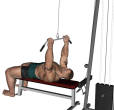 Cable Curl - High Pulley
Cable Curl - High Pulley
Benefits: This exercise isolates the biceps so that momentum does not come into play.
Purpose: This exercise strengthens the biceps.
Beginner Biceps Forearms Shoulders Traps Strength High Low Cable Machine Pull Gym
General Info: The biceps muscle is a straight muscle with 2 heads. The long head crosses both the elbow and shoulder joints and bends the elbow and raises the arm forward at the shoulder. The short head of the biceps crosses the elbow joint and, in conjunction with the brachioradialis, supinates the hand.
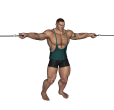 Cable Curl - Overhead
Cable Curl - Overhead
Benefits: This exercise works both heads of the biceps.
Purpose: This exercise is used to target the biceps muscle to develop size, definition, strength, endurance and power.
Intermediate Biceps Forearms Shoulders Strength High Low Cable Machine Pull Gym
General Info: The biceps is a straight muscle with two heads. The long head of the biceps crosses both the elbow and the shoulder joint. It bends the elbow and raises the arm forward at the shoulder. The short head crosses the elbow joint and, in conjunction with the brachioradialis, supinates the hand.
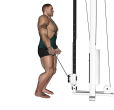 Cable Curl - Standing
Cable Curl - Standing
Benefits: This exercise works both heads of the biceps with a constant tension from the cable.
Purpose: This exercise is used to target the biceps muscle to develop size, definition, strength, endurance and power.
Beginner Biceps Forearms Shoulders Strength Cable Machine Pull Gym
General Info: The biceps is a straight muscle with two heads. The long head of the biceps crosses both the elbow and the shoulder joint. It bends the elbow and raises the arm forward at the shoulder. The short head crosses the elbow joint and, in conjunction with the brachioradialis, supinates the hand.
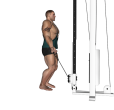 Cable Curl - Standing Single
Cable Curl - Standing Single
Benefits: This exercise works both heads of the biceps with a heavier weight than can typically be done with dumbbells.
Purpose: This exercise is used to target the biceps muscle to develop size, definition, strength, endurance and power.
Beginner Biceps Forearms Shoulders Strength Cable Machine Pull Gym
General Info: The biceps is a straight muscle with two heads. The long head of the biceps crosses both the elbow and the shoulder joint. It bends the elbow and raises the arm forward at the shoulder. The short head crosses the elbow joint and, in conjunction with the brachioradialis, supinates the hand.
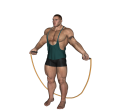 Cardio - Rope Jumping
Cardio - Rope Jumping
Benefits: Jumping rope can avoid the knee damage which may occur during running, since the impact of each jump or step is absorbed by both legs.
Purpose: This exercise improves cardio fitness.
Intermediate Quads Arms Shoulders Hamstrings Cardio Jump Rope Gym Home
General Info: Research has shown that people who spend long periods of time jogging, on treadmills, jumping rope, or stationary bikes, at a relative constant rate of speed, actually lose heart size and fitness. In addition, the body stores more fat to ensure that it can meet the demands of this marathon. But those who do short bursts (1-5 minutes) of intensive exercising and then cool down for another 2-5 minutes have better heart fitness and the muscles of their heart are stronger. Short bursts of intensive exercising have another benefit. The body actually burns more fat and continues to do it for 2-4 hours after the exercise has been completed. This means that your metabolic rate is higher and you will lose fat and be slimmer.
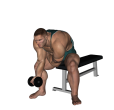 Concentration Curl - Dumbbell
Concentration Curl - Dumbbell
Benefits: This exercise isolates the biceps so that momentum does not come into play.
Purpose: This exercise strengthens the biceps.
Beginner Biceps Forearms Shoulders Traps Strength Dumbbell Flat Bench Pull Gym
General Info: The biceps muscle is a straight muscle with 2 heads. The long head crosses both the elbow and shoulder joints and bends the elbow and raises the arm forward at the shoulder. The short head of the biceps crosses the elbow joint and, in conjunction with the brachioradialis, supinates the hand..
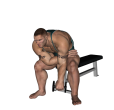 Concentration Curl - Reverse
Concentration Curl - Reverse
Benefits: This exercise isolates the biceps so that momentum does not come into play.
Purpose: This exercise strengthens the biceps.
Beginner Biceps Forearms Shoulders Traps Strength Dumbbell Flat Bench Pull Gym
General Info: The biceps muscle is a straight muscle with 2 heads. The long head crosses both the elbow and shoulder joints and bends the elbow and raises the arm forward at the shoulder. The short head of the biceps crosses the elbow joint and, in conjunction with the brachioradialis, supinates the hand..
 Concentration Curl - Water Bottle
Concentration Curl - Water Bottle
Benefits: This exercise isolates the biceps so that momentum does not come into play.
Purpose: This exercise strengthens the biceps.
Beginner Biceps Forearms Shoulders Traps Strength Water Bottle Chair Pull Home
General Info: The biceps muscle is a straight muscle with 2 heads. The long head crosses both the elbow and shoulder joints and bends the elbow and raises the arm forward at the shoulder. The short head of the biceps crosses the elbow joint and, in conjunction with the brachioradialis, supinates the hand..
 Concentration Curl - Water Bottle Reverse
Concentration Curl - Water Bottle Reverse
Benefits: This exercise isolates the biceps so that momentum does not come into play.
Purpose: This exercise strengthens the biceps.
Beginner Biceps Forearms Shoulders Traps Strength Water Bottle Chair Pull Home
General Info: The biceps muscle is a straight muscle with 2 heads. The long head crosses both the elbow and shoulder joints and bends the elbow and raises the arm forward at the shoulder. The short head of the biceps crosses the elbow joint and, in conjunction with the brachioradialis, supinates the hand..
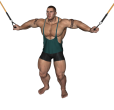 Crossover - Cable
Crossover - Cable
Benefits: This exercise isolates the section of the pecs along the sternum. Using the cable ensures that tension remains on the muscles for the entire range of motion.
Purpose: This exercise the action of the pecs pulling across the chest, especially focused on the middle pecs.
Beginner Chest Shoulders Strength High Low Cable Machine Pull Gym
General Info: The chest is composed of the Pectoralis Major and the Pectoralis Minor. The Pec Major attaches to the upper arm and pulls the upper arm across the chest. The Pec Minor lies mostly underneath the Pec Major and draws the shoulder blade down and forward.
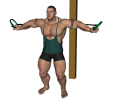 Crossover - With Bands
Crossover - With Bands
Benefits: This exercise isolates the section of the pecs along the sternum.
Purpose: This exercise the action of the pecs pulling across the chest, especially focused on the middle pecs.
Beginner Chest Shoulders Strength Band Pull Gym
General Info: The chest is composed of the Pectoralis Major and the Pectoralis Minor. The Pec Major attaches to the upper arm and pulls the upper arm across the chest. The Pec Minor lies mostly underneath the Pec Major and draws the shoulder blade down and forward.
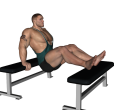 Dip - Bench
Dip - Bench
Benefits: .
Purpose: Benefits Strengthening the triceps balances the biceps muscle.
Beginner Triceps Shoulders Strength Flat Bench Push Compound Gym
General Info: The triceps is a straight muscle with three heads, long head (which extends and adducts the shoulder joint), lateral head (outer triceps) and medial head (inner head along with the long head).
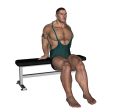 Dip - Bench Bent Knee
Dip - Bench Bent Knee
Benefits: .
Purpose: Benefits Strengthening the triceps balances the biceps muscle.
Beginner Triceps Shoulders Strength Flat Bench Push Compound Gym
General Info: The triceps is a straight muscle with three heads, long head (which extends and adducts the shoulder joint), lateral head (outer triceps) and medial head (inner head along with the long head).
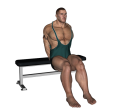 Dip - Bench Bent Knee Close Grip
Dip - Bench Bent Knee Close Grip
Benefits: .
Purpose: Benefits Strengthening the triceps balances the biceps muscle.
Beginner Triceps Shoulders Strength Flat Bench Push Compound Gym
General Info: The triceps is a straight muscle with three heads, long head (which extends and adducts the shoulder joint), lateral head (outer triceps) and medial head (inner head along with the long head).
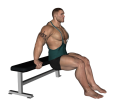 Dip - Bench Bent Knee Wide Grip
Dip - Bench Bent Knee Wide Grip
Benefits: .
Purpose: Benefits Strengthening the triceps balances the biceps muscle.
Beginner Triceps Shoulders Strength Flat Bench Push Compound Gym
General Info: The triceps is a straight muscle with three heads, long head (which extends and adducts the shoulder joint), lateral head (outer triceps) and medial head (inner head along with the long head).
 Dip - Chair
Dip - Chair
Benefits: .
Purpose: Benefits Strengthening the triceps balances the biceps muscle.
Beginner Triceps Shoulders Strength Chair Push Compound Home
General Info: The triceps is a straight muscle with three heads, long head (which extends and adducts the shoulder joint), lateral head (outer triceps) and medial head (inner head along with the long head).
 Dip - Chair Bent Knee
Dip - Chair Bent Knee
Benefits: .
Purpose: Benefits Strengthening the triceps balances the biceps muscle.
Beginner Triceps Shoulders Strength Chair Push Compound Home
General Info: The triceps is a straight muscle with three heads, long head (which extends and adducts the shoulder joint), lateral head (outer triceps) and medial head (inner head along with the long head).
 Dip - Chair Bent Knee Close Grip
Dip - Chair Bent Knee Close Grip
Benefits: .
Purpose: Benefits Strengthening the triceps balances the biceps muscle.
Beginner Triceps Shoulders Strength Chair Push Compound Home
General Info: The triceps is a straight muscle with three heads, long head (which extends and adducts the shoulder joint), lateral head (outer triceps) and medial head (inner head along with the long head).
 Dip - Chair Bent Knee Wide Grip
Dip - Chair Bent Knee Wide Grip
Benefits: .
Purpose: Benefits Strengthening the triceps balances the biceps muscle.
Beginner Triceps Shoulders Strength Chair Push Compound Home
General Info: The triceps is a straight muscle with three heads, long head (which extends and adducts the shoulder joint), lateral head (outer triceps) and medial head (inner head along with the long head).
 Dip - Chair Leg Raised Floor
Dip - Chair Leg Raised Floor
Benefits: .
Purpose: Benefits Strengthening the triceps balances the biceps muscle.
Beginner Triceps Shoulders Strength Chair Push Compound Home
General Info: The triceps is a straight muscle with three heads, long head (which extends and adducts the shoulder joint), lateral head (outer triceps) and medial head (inner head along with the long head).
 Dip - Chair Leg Raised Floor Close Grip
Dip - Chair Leg Raised Floor Close Grip
Benefits: .
Purpose: Benefits Strengthening the triceps balances the biceps muscle.
Beginner Triceps Shoulders Strength Chair Push Compound Home
General Info: The triceps is a straight muscle with three heads, long head (which extends and adducts the shoulder joint), lateral head (outer triceps) and medial head (inner head along with the long head).
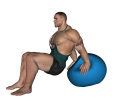 Dip - Fitness Ball Bent Knee
Dip - Fitness Ball Bent Knee
Benefits: .
Purpose: Benefits Strengthening the triceps balances the biceps muscle.
Beginner Triceps Shoulders Strength Fitness Ball Push Compound Gym
General Info: The triceps is a straight muscle with three heads, long head (which extends and adducts the shoulder joint), lateral head (outer triceps) and medial head (inner head along with the long head).
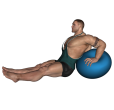 Dip - Fitness Ball Straight Leg
Dip - Fitness Ball Straight Leg
Benefits: Strengthening the triceps balances the biceps muscle.
Purpose: This exercise strengthens the triceps muscle.
Beginner Triceps Shoulders Strength Fitness Ball Push Compound Gym
General Info: The triceps is a straight muscle with three heads, long head (which extends and adducts the shoulder joint), lateral head (outer triceps) and medial head (inner head along with the long head).
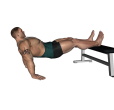 Dip - Leg Raised Floor
Dip - Leg Raised Floor
Benefits: Strengthening the triceps balances the biceps muscle.
Purpose: This exercise strengthens the triceps muscle.
Beginner Triceps Shoulders Strength Flat Bench Push Compound Gym
General Info: The triceps is a straight muscle with three heads, long head (which extends and adducts the shoulder joint), lateral head (outer triceps) and medial head (inner head along with the long head).
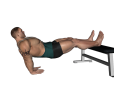 Dip - Leg Raised Floor Close Grip
Dip - Leg Raised Floor Close Grip
Benefits: Strengthening the triceps balances the biceps muscle.
Purpose: This exercise strengthens the triceps muscle.
Beginner Triceps Shoulders Strength Flat Bench Push Compound Gym
General Info: The triceps is a straight muscle with three heads, long head (which extends and adducts the shoulder joint), lateral head (outer triceps) and medial head (inner head along with the long head).
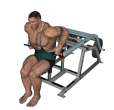 Dip - Machine
Dip - Machine
Benefits: Strengthening the triceps balances the biceps muscle.
Purpose: This exercise strengthens the triceps muscle.
Beginner Triceps Shoulders Strength Dip Machine Push Compound Gym
General Info: The triceps is a straight muscle with three heads, long head (which extends and adducts the shoulder joint), lateral head (outer triceps) and medial head (inner head along with the long head).
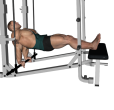 Dip - Smith Machine
Dip - Smith Machine
Benefits: Strengthening the triceps balances the biceps muscle.
Purpose: This exercise strengthens the triceps muscle.
Beginner Triceps Shoulders Strength Smith Machine Flat Bench Push Compound Gym
General Info: The triceps is a straight muscle with three heads, long head (which extends and adducts the shoulder joint), lateral head (outer triceps) and medial head (inner head along with the long head).
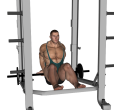 Dip - Smith Machine Bent Knee
Dip - Smith Machine Bent Knee
Benefits: .
Purpose: Benefits Strengthening the triceps balances the biceps muscle.
Beginner Triceps Shoulders Strength Smith Machine Push Compound Gym
General Info: The triceps is a straight muscle with three heads, long head (which extends and adducts the shoulder joint), lateral head (outer triceps) and medial head (inner head along with the long head).
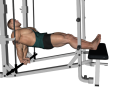 Dip - Smith Machine Close Grip
Dip - Smith Machine Close Grip
Benefits: Strengthening the triceps balances the biceps muscle.
Purpose: This exercise strengthens the triceps muscle.
Beginner Triceps Shoulders Strength Smith Machine Flat Bench Push Compound Gym
General Info: The triceps is a straight muscle with three heads, long head (which extends and adducts the shoulder joint), lateral head (outer triceps) and medial head (inner head along with the long head).
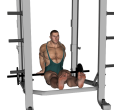 Dip - Smith Machine Straight Leg
Dip - Smith Machine Straight Leg
Benefits: .
Purpose: Benefits Strengthening the triceps balances the biceps muscle.
Beginner Triceps Shoulders Strength Smith Machine Push Compound Gym
General Info: The triceps is a straight muscle with three heads, long head (which extends and adducts the shoulder joint), lateral head (outer triceps) and medial head (inner head along with the long head).
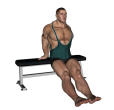 Dip - Straight Leg Bench
Dip - Straight Leg Bench
Benefits: Strengthening the triceps balances the biceps muscle.
Purpose: This exercise strengthens the triceps muscle.
Beginner Triceps Shoulders Strength Flat Bench Push Compound Gym
General Info: The triceps is a straight muscle with three heads, long head (which extends and adducts the shoulder joint), lateral head (outer triceps) and medial head (inner head along with the long head).
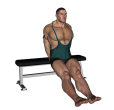 Dip - Straight Leg Bench Close Grip
Dip - Straight Leg Bench Close Grip
Benefits: .
Purpose: Benefits Strengthening the triceps balances the biceps muscle.
Beginner Triceps Shoulders Strength Flat Bench Push Compound Gym
General Info: The triceps is a straight muscle with three heads, long head (which extends and adducts the shoulder joint), lateral head (outer triceps) and medial head (inner head along with the long head).
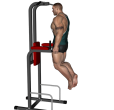 Dip - Triceps
Dip - Triceps
Benefits: Strengthening the triceps balances the biceps muscle.
Purpose: This exercise strengthens the triceps muscle.
Beginner Triceps Shoulders Strength Dipping Bars Push Compound Gym
General Info: The triceps is a straight muscle with three heads, long head (which extends and adducts the shoulder joint), lateral head (outer triceps) and medial head (inner head along with the long head).
 Dip - Triceps With Chains
Dip - Triceps With Chains
Benefits: This exercise is done with the addition of chains. The primary function of chains is to accommodate resistance. Chains are also a great means of weight loading (adding more weight to an exercise). Chains are also a great way for working the stabilizers.
Purpose: .
Beginner Triceps Shoulders Strength Dipping Bars Chains Push Compound Gym
General Info: The triceps is a straight muscle with three heads, long head (which extends and adducts the shoulder joint), lateral head (outer triceps) and medial head (inner head along with the long head).
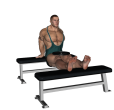 Dip - Weighted Bench
Dip - Weighted Bench
Benefits: .
Purpose: Benefits Strengthening the triceps balances the biceps muscle.
Beginner Triceps Shoulders Strength Flat Bench Plate Push Compound Gym
General Info: The triceps is a straight muscle with three heads, long head (which extends and adducts the shoulder joint), lateral head (outer triceps) and medial head (inner head along with the long head).
 Dip - Weighted Chair
Dip - Weighted Chair
Benefits: .
Purpose: Benefits Strengthening the triceps balances the biceps muscle.
Beginner Triceps Shoulders Strength Chair Book Push Compound Home
General Info: The triceps is a straight muscle with three heads, long head (which extends and adducts the shoulder joint), lateral head (outer triceps) and medial head (inner head along with the long head).
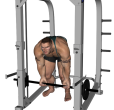 Drag Curl - Smith Machine Bent Over
Drag Curl - Smith Machine Bent Over
Benefits: This exercise works both heads of the biceps with a heavier weight than can typically be done with dumbbells.
Purpose: This exercise is used to target the biceps muscle to develop size, definition, strength, endurance and power.
Intermediate Biceps Forearms Shoulders Lower Back Strength Smith Machine Pull Compound Gym
General Info: The biceps is a straight muscle with two heads. The long head of the biceps crosses both the elbow and the shoulder joint. It bends the elbow and raises the arm forward at the shoulder. The short head crosses the elbow joint and, in conjunction with the brachioradialis, supinates the hand.
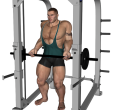 Drag Curl - Smith Machine Standing
Drag Curl - Smith Machine Standing
Benefits: This exercise works both heads of the biceps with a heavier weight than can typically be done with dumbbells.
Purpose: This exercise is used to target the biceps muscle to develop size, definition, strength, endurance and power.
Intermediate Biceps Forearms Shoulders Strength Smith Machine Pull Compound Gym
General Info: The biceps is a straight muscle with two heads. The long head of the biceps crosses both the elbow and the shoulder joint. It bends the elbow and raises the arm forward at the shoulder. The short head crosses the elbow joint and, in conjunction with the brachioradialis, supinates the hand.
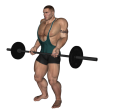 Drag Curl - Standing Barbell
Drag Curl - Standing Barbell
Benefits: This exercise works both heads of the biceps with a heavier weight than can typically be done with dumbbells.
Purpose: This exercise is used to target the biceps muscle to develop size, definition, strength, endurance and power.
Intermediate Biceps Forearms Shoulders Strength Barbell Pull Compound Gym
General Info: The biceps is a straight muscle with two heads. The long head of the biceps crosses both the elbow and the shoulder joint. It bends the elbow and raises the arm forward at the shoulder. The short head crosses the elbow joint and, in conjunction with the brachioradialis, supinates the hand.
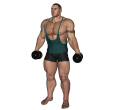 Dumbbell Curl - Alternate
Dumbbell Curl - Alternate
Benefits: This exercise works both heads of the biceps with a heavier weight than can typically be done with dumbbells.
Purpose: This exercise is used to target the biceps muscle to develop size, definition, strength, endurance and power.
Beginner Biceps Forearms Shoulders Strength Dumbbell Pull Gym
General Info: The biceps is a straight muscle with two heads. The long head of the biceps crosses both the elbow and the shoulder joint. It bends the elbow and raises the arm forward at the shoulder. The short head crosses the elbow joint and, in conjunction with the brachioradialis, supinates the hand.
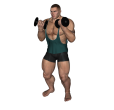 Dumbbell Curl - Basic
Dumbbell Curl - Basic
Benefits: This exercise works both heads of the biceps.
Purpose: This exercise is used to target the biceps muscle to develop size, definition, strength, endurance and power.
Beginner Biceps Forearms Shoulders Strength Dumbbell Pull Gym
General Info: The biceps is a straight muscle with two heads. The long head of the biceps crosses both the elbow and the shoulder joint. It bends the elbow and raises the arm forward at the shoulder. The short head crosses the elbow joint and, in conjunction with the brachioradialis, supinates the hand.
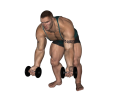 Dumbbell Curl - Bent Over
Dumbbell Curl - Bent Over
Benefits: This exercise is similar in effect to the Spider curl and does a good job of placing maximum tension on the biceps in the fully contracted position.
Purpose: This exercise works the biceps muscles but focuses also on the brachioradialis (a muscle that crosses the elbow joint and assists in rotating the forearm).
Beginner Biceps Forearms Shoulders Strength Dumbbell Pull Gym
General Info: The biceps is a straight muscle which has two heads. The long head crosses both the elbow and the shoulder joints. It bends the arm at the elbow and raises the arm forward at the shoulder. The short head crosses the elbow joint and, in conjunction with the brachioradialis, supinates the hand.
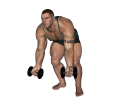 Dumbbell Curl - Bent Over Alternate
Dumbbell Curl - Bent Over Alternate
Benefits: This exercise works both heads of the biceps with a heavier weight than can typically be done with dumbbells.
Purpose: This exercise is used to target the biceps muscle to develop size, definition, strength, endurance and power.
Beginner Biceps Forearms Shoulders Strength Dumbbell Pull Gym
General Info: The biceps is a straight muscle with two heads. The long head of the biceps crosses both the elbow and the shoulder joint. It bends the elbow and raises the arm forward at the shoulder. The short head crosses the elbow joint and, in conjunction with the brachioradialis, supinates the hand.
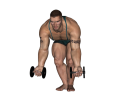 Dumbbell Curl - Bent Over Narrow
Dumbbell Curl - Bent Over Narrow
Benefits: This exercise is similar in effect to the Spider curl and does a good job of placing maximum tension on the biceps in the fully contracted position.
Purpose: This exercise works the biceps muscles but focuses also on the brachioradialis (a muscle that crosses the elbow joint and assists in rotating the forearm).
Beginner Biceps Forearms Shoulders Strength Dumbbell Pull Gym
General Info: The biceps is a straight muscle which has two heads. The long head crosses both the elbow and the shoulder joints. It bends the arm at the elbow and raises the arm forward at the shoulder. The short head crosses the elbow joint and, in conjunction with the brachioradialis, supinates the hand.
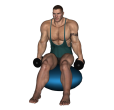 Dumbbell Curl - Fitness Ball Alternate
Dumbbell Curl - Fitness Ball Alternate
Benefits: This exercise isolates the biceps so that momentum does not come into play.
Purpose: This exercise strengthens the biceps.
Beginner Biceps Forearms Shoulders Traps Strength Dumbbell Fitness Ball Pull Gym
General Info: The biceps muscle is a straight muscle with 2 heads. The long head crosses both the elbow and shoulder joints and bends the elbow and raises the arm forward at the shoulder. The short head of the biceps crosses the elbow joint and, in conjunction with the brachioradialis, supinates the hand.
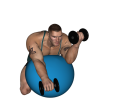 Dumbbell Curl - Fitness Ball Preacher Zottman Alternate
Dumbbell Curl - Fitness Ball Preacher Zottman Alternate
Benefits: This exercise isolates the biceps so that momentum does not come into play.
Purpose: This exercise strengthens the biceps.
Beginner Biceps Forearms Shoulders Traps Strength Dumbbell Fitness Ball Pull Gym
General Info: The biceps muscle is a straight muscle with 2 heads. The long head crosses both the elbow and shoulder joints and bends the elbow and raises the arm forward at the shoulder. The short head of the biceps crosses the elbow joint and, in conjunction with the brachioradialis, supinates the hand.
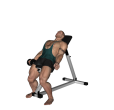 Dumbbell Curl - Incline Single
Dumbbell Curl - Incline Single
Benefits: This exercise works both heads of the biceps with a heavier weight than can typically be done with dumbbells.
Purpose: This exercise is used to target the biceps muscle to develop size, definition, strength, endurance and power.
Beginner Biceps Forearms Shoulders Strength Dumbbell Incline Bench Pull Gym
General Info: The biceps is a straight muscle with two heads. The long head of the biceps crosses both the elbow and the shoulder joint. It bends the elbow and raises the arm forward at the shoulder. The short head crosses the elbow joint and, in conjunction with the brachioradialis, supinates the hand.
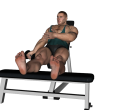 Dumbbell Curl - Incline Single Feet Up
Dumbbell Curl - Incline Single Feet Up
Benefits: This exercise works both heads of the biceps with a heavier weight than can typically be done with dumbbells.
Purpose: This exercise is used to target the biceps muscle to develop size, definition, strength, endurance and power.
Beginner Biceps Forearms Shoulders Strength Dumbbell Incline Bench Pull Gym
General Info: The biceps is a straight muscle with two heads. The long head of the biceps crosses both the elbow and the shoulder joint. It bends the elbow and raises the arm forward at the shoulder. The short head crosses the elbow joint and, in conjunction with the brachioradialis, supinates the hand.
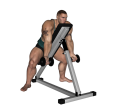 Dumbbell Curl - Prone Incline
Dumbbell Curl - Prone Incline
Benefits: This exercise works both heads of the biceps with a heavier weight than can typically be done with dumbbells.
Purpose: This exercise is used to target the biceps muscle to develop size, definition, strength, endurance and power.
Beginner Biceps Forearms Shoulders Strength Dumbbell Incline Bench Pull Gym
General Info: The biceps is a straight muscle with two heads. The long head of the biceps crosses both the elbow and the shoulder joint. It bends the elbow and raises the arm forward at the shoulder. The short head crosses the elbow joint and, in conjunction with the brachioradialis, supinates the hand.
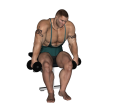 Dumbbell Curl - Seated Alternate
Dumbbell Curl - Seated Alternate
Benefits: This exercise isolates the biceps so that momentum does not come into play.
Purpose: This exercise strengthens the biceps.
Beginner Biceps Forearms Shoulders Traps Strength Dumbbell Flat Bench Pull Gym
General Info: The biceps muscle is a straight muscle with 2 heads. The long head crosses both the elbow and shoulder joints and bends the elbow and raises the arm forward at the shoulder. The short head of the biceps crosses the elbow joint and, in conjunction with the brachioradialis, supinates the hand..
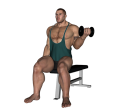 Dumbbell Curl - Seated Inner Alternate
Dumbbell Curl - Seated Inner Alternate
Benefits: This exercise isolates the biceps so that momentum does not come into play.
Purpose: This exercise strengthens the biceps.
Beginner Biceps Forearms Shoulders Traps Strength Dumbbell Flat Bench Pull Gym
General Info: The biceps muscle is a straight muscle with 2 heads. The long head crosses both the elbow and shoulder joints and bends the elbow and raises the arm forward at the shoulder. The short head of the biceps crosses the elbow joint and, in conjunction with the brachioradialis, supinates the hand..
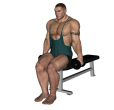 Dumbbell Curl - Seated Narrow Stance
Dumbbell Curl - Seated Narrow Stance
Benefits: This exercise isolates the biceps so that momentum does not come into play.
Purpose: This exercise strengthens the biceps.
Beginner Biceps Forearms Shoulders Traps Strength Dumbbell Flat Bench Pull Gym
General Info: The biceps muscle is a straight muscle with 2 heads. The long head crosses both the elbow and shoulder joints and bends the elbow and raises the arm forward at the shoulder. The short head of the biceps crosses the elbow joint and, in conjunction with the brachioradialis, supinates the hand..
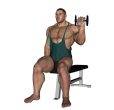 Dumbbell Curl - Seated Reverse Alternate
Dumbbell Curl - Seated Reverse Alternate
Benefits: This exercise isolates the biceps so that momentum does not come into play.
Purpose: This exercise strengthens the biceps.
Beginner Biceps Forearms Shoulders Traps Strength Dumbbell Flat Bench Pull Gym
General Info: The biceps muscle is a straight muscle with 2 heads. The long head crosses both the elbow and shoulder joints and bends the elbow and raises the arm forward at the shoulder. The short head of the biceps crosses the elbow joint and, in conjunction with the brachioradialis, supinates the hand..
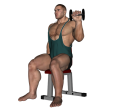 Dumbbell Curl - Seated Reverse Narrow Stance Alternate
Dumbbell Curl - Seated Reverse Narrow Stance Alternate
Benefits: This exercise isolates the biceps so that momentum does not come into play.
Purpose: This exercise strengthens the biceps.
Beginner Biceps Forearms Shoulders Traps Strength Dumbbell Flat Bench Pull Gym
General Info: The biceps muscle is a straight muscle with 2 heads. The long head crosses both the elbow and shoulder joints and bends the elbow and raises the arm forward at the shoulder. The short head of the biceps crosses the elbow joint and, in conjunction with the brachioradialis, supinates the hand..
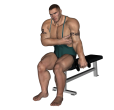 Dumbbell Curl - Seated Single
Dumbbell Curl - Seated Single
Benefits: This exercise isolates the biceps so that momentum does not come into play.
Purpose: This exercise strengthens the biceps.
Beginner Biceps Forearms Shoulders Traps Strength Dumbbell Flat Bench Pull Gym
General Info: The biceps muscle is a straight muscle with 2 heads. The long head crosses both the elbow and shoulder joints and bends the elbow and raises the arm forward at the shoulder. The short head of the biceps crosses the elbow joint and, in conjunction with the brachioradialis, supinates the hand..
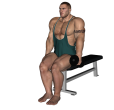 Dumbbell Curl - Seated Single Narrow
Dumbbell Curl - Seated Single Narrow
Benefits: This exercise isolates the biceps so that momentum does not come into play.
Purpose: This exercise strengthens the biceps.
Beginner Biceps Forearms Shoulders Traps Strength Dumbbell Flat Bench Pull Gym
General Info: The biceps muscle is a straight muscle with 2 heads. The long head crosses both the elbow and shoulder joints and bends the elbow and raises the arm forward at the shoulder. The short head of the biceps crosses the elbow joint and, in conjunction with the brachioradialis, supinates the hand..
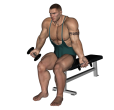 Dumbbell Curl - Seated Straight
Dumbbell Curl - Seated Straight
Benefits: This exercise isolates the biceps so that momentum does not come into play.
Purpose: This exercise strengthens the biceps.
Beginner Biceps Forearms Shoulders Traps Strength Dumbbell Flat Bench Pull Gym
General Info: The biceps muscle is a straight muscle with 2 heads. The long head crosses both the elbow and shoulder joints and bends the elbow and raises the arm forward at the shoulder. The short head of the biceps crosses the elbow joint and, in conjunction with the brachioradialis, supinates the hand..
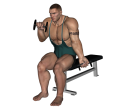 Dumbbell Curl - Seated Straight Alternate
Dumbbell Curl - Seated Straight Alternate
Benefits: This exercise isolates the biceps so that momentum does not come into play.
Purpose: This exercise strengthens the biceps.
Beginner Biceps Forearms Shoulders Traps Strength Dumbbell Flat Bench Pull Gym
General Info: The biceps muscle is a straight muscle with 2 heads. The long head crosses both the elbow and shoulder joints and bends the elbow and raises the arm forward at the shoulder. The short head of the biceps crosses the elbow joint and, in conjunction with the brachioradialis, supinates the hand.
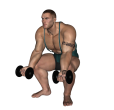 Dumbbell Curl - Squat
Dumbbell Curl - Squat
Benefits: This exercise isolates the biceps so that momentum does not come into play.
Purpose: This exercise strengthens the biceps.
Intermediate Biceps Forearms Shoulders Traps Strength Dumbbell Pull Gym
General Info: The biceps muscle is a straight muscle with 2 heads. The long head crosses both the elbow and shoulder joints and bends the elbow and raises the arm forward at the shoulder. The short head of the biceps crosses the elbow joint and, in conjunction with the brachioradialis, supinates the hand..
 Dumbbell Curl - Squat Alternate
Dumbbell Curl - Squat Alternate
Benefits: This exercise isolates the biceps so that momentum does not come into play.
Purpose: This exercise strengthens the biceps.
Intermediate Biceps Forearms Shoulders Traps Strength Dumbbell Pull Gym
General Info: The biceps muscle is a straight muscle with 2 heads. The long head crosses both the elbow and shoulder joints and bends the elbow and raises the arm forward at the shoulder. The short head of the biceps crosses the elbow joint and, in conjunction with the brachioradialis, supinates the hand..
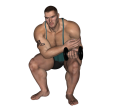 Dumbbell Curl - Squat Single
Dumbbell Curl - Squat Single
Benefits: This exercise isolates the biceps so that momentum does not come into play.
Purpose: This exercise strengthens the biceps.
Intermediate Biceps Forearms Shoulders Traps Strength Dumbbell Pull Gym
General Info: The biceps muscle is a straight muscle with 2 heads. The long head crosses both the elbow and shoulder joints and bends the elbow and raises the arm forward at the shoulder. The short head of the biceps crosses the elbow joint and, in conjunction with the brachioradialis, supinates the hand..
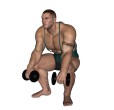 Dumbbell Curl - Squat Single Reverse
Dumbbell Curl - Squat Single Reverse
Benefits: This exercise isolates the biceps so that momentum does not come into play.
Purpose: This exercise strengthens the biceps.
Intermediate Biceps Forearms Shoulders Traps Strength Dumbbell Pull Gym
General Info: The biceps muscle is a straight muscle with 2 heads. The long head crosses both the elbow and shoulder joints and bends the elbow and raises the arm forward at the shoulder. The short head of the biceps crosses the elbow joint and, in conjunction with the brachioradialis, supinates the hand..
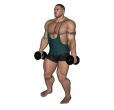 Dumbbell Curl - Standing
Dumbbell Curl - Standing
Benefits: This exercise works both heads of the biceps and isolates the biceps so that momentum does not come into play.
Purpose: This exercise is used to target the biceps muscle to develop size, definition, strength, endurance and power.
Beginner Biceps Forearms Shoulders Strength Dumbbell Pull Gym
General Info: The biceps is a straight muscle with two heads. The long head of the biceps crosses both the elbow and the shoulder joint. It bends the elbow and raises the arm forward at the shoulder. The short head crosses the elbow joint and, in conjunction with the brachioradialis, supinates the hand.
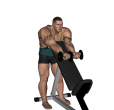 Dumbbell Curl - Standing Incline
Dumbbell Curl - Standing Incline
Benefits: This exercise works both heads of the biceps very similarly as the preacher curl.
Purpose: This exercise is used to target the biceps muscle to develop size, definition, strength, endurance and power.
Beginner Biceps Forearms Shoulders Strength Dumbbell Incline Bench Pull Gym
General Info: The biceps is a straight muscle with two heads. The long head of the biceps crosses both the elbow and the shoulder joint. It bends the elbow and raises the arm forward at the shoulder. The short head crosses the elbow joint and, in conjunction with the brachioradialis, supinates the hand.
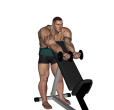 Dumbbell Curl - Standing Incline Alternate
Dumbbell Curl - Standing Incline Alternate
Benefits: This exercise works both heads of the biceps very similarly as the preacher curl.
Purpose: This exercise is used to target the biceps muscle to develop size, definition, strength, endurance and power.
Beginner Biceps Forearms Shoulders Strength Dumbbell Incline Bench Pull Gym
General Info: The biceps is a straight muscle with two heads. The long head of the biceps crosses both the elbow and the shoulder joint. It bends the elbow and raises the arm forward at the shoulder. The short head crosses the elbow joint and, in conjunction with the brachioradialis, supinates the hand.
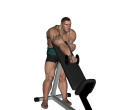 Dumbbell Curl - Standing Incline One Arm
Dumbbell Curl - Standing Incline One Arm
Benefits: This exercise works both heads of the biceps very similarly as the preacher curl.
Purpose: This exercise is used to target the biceps muscle to develop size, definition, strength, endurance and power.
Beginner Biceps Forearms Shoulders Strength Dumbbell Incline Bench Pull Gym
General Info: The biceps is a straight muscle with two heads. The long head of the biceps crosses both the elbow and the shoulder joint. It bends the elbow and raises the arm forward at the shoulder. The short head crosses the elbow joint and, in conjunction with the brachioradialis, supinates the hand.
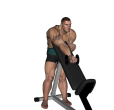 Dumbbell Curl - Standing Incline Single
Dumbbell Curl - Standing Incline Single
Benefits: This exercise works both heads of the biceps with a heavier weight than can typically be done with dumbbells.
Purpose: This exercise is used to target the biceps muscle to develop size, definition, strength, endurance and power.
Beginner Biceps Forearms Shoulders Strength Dumbbell Incline Bench Pull Gym
General Info: The biceps is a straight muscle with two heads. The long head of the biceps crosses both the elbow and the shoulder joint. It bends the elbow and raises the arm forward at the shoulder. The short head crosses the elbow joint and, in conjunction with the brachioradialis, supinates the hand.
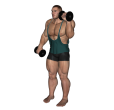 Dumbbell Curl - Standing Reverse Alternate
Dumbbell Curl - Standing Reverse Alternate
Benefits: This exercise works both heads of the biceps with a heavier weight than can typically be done with dumbbells.
Purpose: This exercise is used to target the biceps muscle to develop size, definition, strength, endurance and power.
Beginner Biceps Forearms Shoulders Strength Dumbbell Pull Gym
General Info: The biceps is a straight muscle with two heads. The long head of the biceps crosses both the elbow and the shoulder joint. It bends the elbow and raises the arm forward at the shoulder. The short head crosses the elbow joint and, in conjunction with the brachioradialis, supinates the hand.
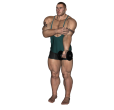 Dumbbell Curl - Standing Single
Dumbbell Curl - Standing Single
Benefits: This exercise works both heads of the biceps and isolates the biceps so that momentum does not come into play.
Purpose: This exercise is used to target the biceps muscle to develop size, definition, strength, endurance and power.
Beginner Biceps Forearms Shoulders Strength Dumbbell Pull Gym
General Info: The biceps is a straight muscle with two heads. The long head of the biceps crosses both the elbow and the shoulder joint. It bends the elbow and raises the arm forward at the shoulder. The short head crosses the elbow joint and, in conjunction with the brachioradialis, supinates the hand.
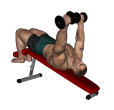 Dumbbell Press - Decline
Dumbbell Press - Decline
Benefits: This exercise works the chest muscles with a focus on your lower pecs.
Purpose: This exercise is used to target the lower pecs muscle to develop size, definition, strength, endurance and power.
Beginner Chest Triceps Shoulders Strength Dumbbell Decline Bench Push Compound Gym
General Info: The chest is composed of the Pectoralis Major and the Pectoralis Minor. The Pec Major attaches to the upper arm and pulls the upper arm across the chest. The Pec Minor lies mostly underneath the Pec Major and draws the shoulder blade down and forward.
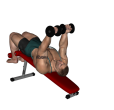 Dumbbell Press - Decline Reverse
Dumbbell Press - Decline Reverse
Benefits: This exercise works the chest muscles with a focus on your lower pecs. The reverse grip makes the exercise more difficult.
Purpose: This exercise is used to target the lower pecs muscle to develop size, definition, strength, endurance and power.
Beginner Chest Triceps Shoulders Strength Dumbbell Decline Bench Push Compound Gym
General Info: The chest is composed of the Pectoralis Major and the Pectoralis Minor. The Pec Major attaches to the upper arm and pulls the upper arm across the chest. The Pec Minor lies mostly underneath the Pec Major and draws the shoulder blade down and forward.
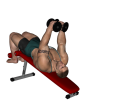 Dumbbell Press - Decline Reverse Rotation
Dumbbell Press - Decline Reverse Rotation
Benefits: This exercise works the chest muscles with a focus on your lower pecs. The reverse grip makes the exercise more difficult.
Purpose: This exercise is used to target the lower pecs muscle to develop size, definition, strength, endurance and power.
Beginner Chest Triceps Shoulders Strength Dumbbell Decline Bench Push Compound Gym
General Info: The chest is composed of the Pectoralis Major and the Pectoralis Minor. The Pec Major attaches to the upper arm and pulls the upper arm across the chest. The Pec Minor lies mostly underneath the Pec Major and draws the shoulder blade down and forward.
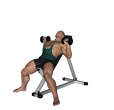 Dumbbell Press - Incline
Dumbbell Press - Incline
Benefits: This exercise works the chest muscles with a focus on your upper pecs.
Purpose: This exercise is used to target the upper pecs muscle to develop size, definition, strength, endurance and power.
Beginner Chest Triceps Shoulders Strength Dumbbell Incline Bench Push Compound Gym
General Info: The chest is composed of the Pectoralis Major and the Pectoralis Minor. The Pec Major attaches to the upper arm and pulls the upper arm across the chest. The Pec Minor lies mostly underneath the Pec Major and draws the shoulder blade down and forward.
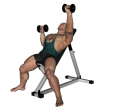 Dumbbell Press - Incline Alternate
Dumbbell Press - Incline Alternate
Benefits: This exercise works the chest muscles with a focus on your upper pecs.
Purpose: This exercise is used to target the upper pecs muscle to develop size, definition, strength, endurance and power.
Beginner Chest Triceps Shoulders Strength Dumbbell Incline Bench Push Compound Gym
General Info: The chest is composed of the Pectoralis Major and the Pectoralis Minor. The Pec Major attaches to the upper arm and pulls the upper arm across the chest. The Pec Minor lies mostly underneath the Pec Major and draws the shoulder blade down and forward.
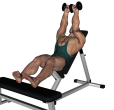 Dumbbell Press - Incline Feet Up
Dumbbell Press - Incline Feet Up
Benefits: This exercise works the chest muscles with a focus on your upper pecs.
Purpose: This exercise is used to target the upper pecs muscle to develop size, definition, strength, endurance and power.
Beginner Chest Triceps Shoulders Strength Dumbbell Incline Bench Push Compound Gym
General Info: The chest is composed of the Pectoralis Major and the Pectoralis Minor. The Pec Major attaches to the upper arm and pulls the upper arm across the chest. The Pec Minor lies mostly underneath the Pec Major and draws the shoulder blade down and forward.
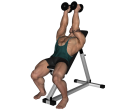 Dumbbell Press - Incline Inwards
Dumbbell Press - Incline Inwards
Benefits: This exercise works the chest muscles with a focus on your upper pecs.
Purpose: This exercise is used to target the upper pecs muscle to develop size, definition, strength, endurance and power.
Beginner Chest Triceps Shoulders Strength Dumbbell Incline Bench Push Compound Gym
General Info: The chest is composed of the Pectoralis Major and the Pectoralis Minor. The Pec Major attaches to the upper arm and pulls the upper arm across the chest. The Pec Minor lies mostly underneath the Pec Major and draws the shoulder blade down and forward.
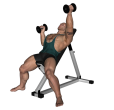 Dumbbell Press - Incline Inwards Alternate
Dumbbell Press - Incline Inwards Alternate
Benefits: This exercise works the chest muscles with a focus on your upper pecs.
Purpose: This exercise is used to target the upper pecs muscle to develop size, definition, strength, endurance and power.
Beginner Chest Triceps Shoulders Strength Dumbbell Incline Bench Push Compound Gym
General Info: The chest is composed of the Pectoralis Major and the Pectoralis Minor. The Pec Major attaches to the upper arm and pulls the upper arm across the chest. The Pec Minor lies mostly underneath the Pec Major and draws the shoulder blade down and forward.
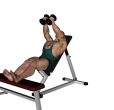 Dumbbell Press - Incline Inwards Feet Up
Dumbbell Press - Incline Inwards Feet Up
Benefits: This exercise works the chest muscles with a focus on your upper pecs.
Purpose: This exercise is used to target the upper pecs muscle to develop size, definition, strength, endurance and power.
Beginner Chest Triceps Shoulders Strength Dumbbell Incline Bench Push Compound Gym
General Info: The chest is composed of the Pectoralis Major and the Pectoralis Minor. The Pec Major attaches to the upper arm and pulls the upper arm across the chest. The Pec Minor lies mostly underneath the Pec Major and draws the shoulder blade down and forward.
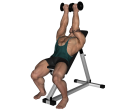 Dumbbell Press - Incline Reverse
Dumbbell Press - Incline Reverse
Benefits: This exercise works the chest muscles with a focus on your upper pecs.
Purpose: This exercise is used to target the upper pecs muscle to develop size, definition, strength, endurance and power.
Beginner Chest Triceps Shoulders Strength Dumbbell Incline Bench Push Compound Gym
General Info: The chest is composed of the Pectoralis Major and the Pectoralis Minor. The Pec Major attaches to the upper arm and pulls the upper arm across the chest. The Pec Minor lies mostly underneath the Pec Major and draws the shoulder blade down and forward.
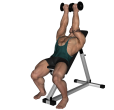 Dumbbell Press - Incline Reverse Alternate
Dumbbell Press - Incline Reverse Alternate
Benefits: This exercise works the chest muscles with a focus on your upper pecs.
Purpose: This exercise is used to target the upper pecs muscle to develop size, definition, strength, endurance and power.
Beginner Chest Triceps Shoulders Strength Dumbbell Incline Bench Push Compound Gym
General Info: The chest is composed of the Pectoralis Major and the Pectoralis Minor. The Pec Major attaches to the upper arm and pulls the upper arm across the chest. The Pec Minor lies mostly underneath the Pec Major and draws the shoulder blade down and forward.
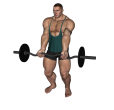 EZ Bar Curl - Basic
EZ Bar Curl - Basic
Benefits: This exercise puts the forearms in a stronger position, allowing you to lift heavier weights. The EZ Bar puts the hands in a very strong position.
Purpose: This exercise is used to target the biceps muscle to develop size, definition, strength, endurance and power.
Beginner Biceps Forearms Shoulders Strength EZ Bar Pull Gym
General Info: The biceps is a straight muscle with two heads. The long head of the biceps crosses both the elbow and the shoulder joint. It bends the elbow and raises the arm forward at the shoulder. The short head crosses the elbow joint and, in conjunction with the brachioradialis, supinates the hand.
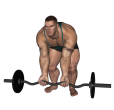 EZ Bar Curl - Bent Over
EZ Bar Curl - Bent Over
Benefits: This exercise is similar in effect to the Spider curl and does a good job of placing maximum tension on the biceps in the fully contracted position.
Purpose: This exercise works the biceps muscles but focuses also on the brachioradialis (a muscle that crosses the elbow joint and assists in rotating the forearm).
Beginner Biceps Forearms Shoulders Strength EZ Bar Pull Gym
General Info: The biceps is a straight muscle which has two heads. The long head crosses both the elbow and the shoulder joints. It bends the arm at the elbow and raises the arm forward at the shoulder. The short head crosses the elbow joint and, in conjunction with the brachioradialis, supinates the hand.
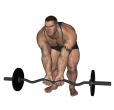 EZ Bar Curl - Bent Over Close Grip
EZ Bar Curl - Bent Over Close Grip
Benefits: This exercise is similar in effect to the Spider curl and does a good job of placing maximum tension on the biceps in the fully contracted position.
Purpose: This exercise works the biceps muscles but focuses also on the brachioradialis (a muscle that crosses the elbow joint and assists in rotating the forearm).
Beginner Biceps Forearms Shoulders Strength EZ Bar Pull Gym
General Info: The biceps is a straight muscle which has two heads. The long head crosses both the elbow and the shoulder joints. It bends the arm at the elbow and raises the arm forward at the shoulder. The short head crosses the elbow joint and, in conjunction with the brachioradialis, supinates the hand.
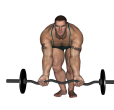 EZ Bar Curl - Bent Over Narrow Stance
EZ Bar Curl - Bent Over Narrow Stance
Benefits: This exercise is similar in effect to the Spider curl and does a good job of placing maximum tension on the biceps in the fully contracted position.
Purpose: This exercise works the biceps muscles but focuses also on the brachioradialis (a muscle that crosses the elbow joint and assists in rotating the forearm).
Beginner Biceps Forearms Shoulders Strength EZ Bar Pull Gym
General Info: The biceps is a straight muscle which has two heads. The long head crosses both the elbow and the shoulder joints. It bends the arm at the elbow and raises the arm forward at the shoulder. The short head crosses the elbow joint and, in conjunction with the brachioradialis, supinates the hand.
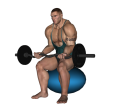 EZ Bar Curl - Fitness Ball
EZ Bar Curl - Fitness Ball
Benefits: This exercise puts the forearms in a stronger position, allowing you to lift heavier weights.
Purpose: This exercise is used to target the biceps muscle to develop size, definition, strength, endurance and power.
Beginner Biceps Forearms Shoulders Strength EZ Bar Fitness Ball Pull Gym
General Info: The biceps is a straight muscle with two heads. The long head of the biceps crosses both the elbow and the shoulder joint. It bends the elbow and raises the arm forward at the shoulder. The short head crosses the elbow joint and, in conjunction with the brachioradialis, supinates the hand.
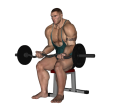 EZ Bar Curl - Seated
EZ Bar Curl - Seated
Benefits: This exercise isolates the biceps so that momentum does not come into play.
Purpose: This exercise strengthens the biceps.
Beginner Biceps Forearms Shoulders Traps Strength EZ Bar Flat Bench Pull Gym
General Info: The biceps muscle is a straight muscle with 2 heads. The long head crosses both the elbow and shoulder joints and bends the elbow and raises the arm forward at the shoulder. The short head of the biceps crosses the elbow joint and, in conjunction with the brachioradialis, supinates the hand..
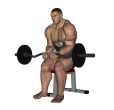 EZ Bar Curl - Seated Close Grip
EZ Bar Curl - Seated Close Grip
Benefits: This exercise isolates the biceps so that momentum does not come into play.
Purpose: This exercise strengthens the biceps.
Beginner Biceps Forearms Shoulders Traps Strength EZ Bar Flat Bench Pull Gym
General Info: The biceps muscle is a straight muscle with 2 heads. The long head crosses both the elbow and shoulder joints and bends the elbow and raises the arm forward at the shoulder. The short head of the biceps crosses the elbow joint and, in conjunction with the brachioradialis, supinates the hand..
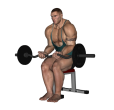 EZ Bar Curl - Seated Close Narrow
EZ Bar Curl - Seated Close Narrow
Benefits: This exercise isolates the biceps so that momentum does not come into play.
Purpose: This exercise strengthens the biceps.
Beginner Biceps Forearms Shoulders Traps Strength EZ Bar Flat Bench Pull Gym
General Info: The biceps muscle is a straight muscle with 2 heads. The long head crosses both the elbow and shoulder joints and bends the elbow and raises the arm forward at the shoulder. The short head of the biceps crosses the elbow joint and, in conjunction with the brachioradialis, supinates the hand..
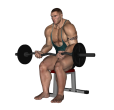 EZ Bar Curl - Seated Feet Up
EZ Bar Curl - Seated Feet Up
Benefits: This exercise isolates the biceps so that momentum does not come into play.
Purpose: This exercise strengthens the biceps.
Beginner Biceps Forearms Shoulders Traps Strength EZ Bar Flat Bench Pull Gym
General Info: The biceps muscle is a straight muscle with 2 heads. The long head crosses both the elbow and shoulder joints and bends the elbow and raises the arm forward at the shoulder. The short head of the biceps crosses the elbow joint and, in conjunction with the brachioradialis, supinates the hand..
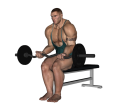 EZ Bar Curl - Seated Narrow Stance
EZ Bar Curl - Seated Narrow Stance
Benefits: This exercise isolates the biceps so that momentum does not come into play.
Purpose: This exercise strengthens the biceps.
Beginner Biceps Forearms Shoulders Traps Strength EZ Bar Flat Bench Pull Gym
General Info: The biceps muscle is a straight muscle with 2 heads. The long head crosses both the elbow and shoulder joints and bends the elbow and raises the arm forward at the shoulder. The short head of the biceps crosses the elbow joint and, in conjunction with the brachioradialis, supinates the hand..
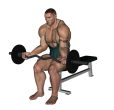 EZ Bar Curl - Seated Wide Grip
EZ Bar Curl - Seated Wide Grip
Benefits: This exercise isolates the biceps so that momentum does not come into play. The EZ Bar puts the hands in a very strong position.
Purpose: This exercise strengthens the biceps.
Beginner Biceps Forearms Shoulders Traps Strength EZ Bar Flat Bench Pull Gym
General Info: The biceps muscle is a straight muscle with 2 heads. The long head crosses both the elbow and shoulder joints and bends the elbow and raises the arm forward at the shoulder. The short head of the biceps crosses the elbow joint and, in conjunction with the brachioradialis, supinates the hand..
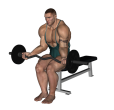 EZ Bar Curl - Seated Wide Narrow
EZ Bar Curl - Seated Wide Narrow
Benefits: This exercise isolates the biceps so that momentum does not come into play.
Purpose: This exercise strengthens the biceps.
Beginner Biceps Forearms Shoulders Traps Strength EZ Bar Flat Bench Pull Gym
General Info: The biceps muscle is a straight muscle with 2 heads. The long head crosses both the elbow and shoulder joints and bends the elbow and raises the arm forward at the shoulder. The short head of the biceps crosses the elbow joint and, in conjunction with the brachioradialis, supinates the hand..
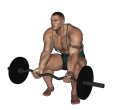 EZ Bar Curl - Squat
EZ Bar Curl - Squat
Benefits: This exercise isolates the biceps so that momentum does not come into play.
Purpose: This exercise strengthens the biceps.
Intermediate Biceps Forearms Shoulders Traps Strength EZ Bar Pull Gym
General Info: The biceps muscle is a straight muscle with 2 heads. The long head crosses both the elbow and shoulder joints and bends the elbow and raises the arm forward at the shoulder. The short head of the biceps crosses the elbow joint and, in conjunction with the brachioradialis, supinates the hand..
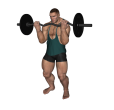 EZ Bar Curl - Standing
EZ Bar Curl - Standing
Benefits: This exercise puts the forearms in a stronger position, allowing you to lift heavier weights.
Purpose: This exercise is used to target the biceps muscle to develop size, definition, strength, endurance and power.
Beginner Biceps Forearms Shoulders Strength EZ Bar Pull Gym
General Info: The biceps is a straight muscle with two heads. The long head of the biceps crosses both the elbow and the shoulder joint. It bends the elbow and raises the arm forward at the shoulder. The short head crosses the elbow joint and, in conjunction with the brachioradialis, supinates the hand.
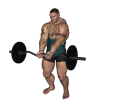 EZ Bar Curl - Standing Close Grip
EZ Bar Curl - Standing Close Grip
Benefits: This exercise puts the forearms in a stronger position, allowing you to lift heavier weights.
Purpose: This exercise is used to target the biceps muscle to develop size, definition, strength, endurance and power.
Beginner Biceps Forearms Shoulders Strength EZ Bar Pull Gym
General Info: The biceps is a straight muscle with two heads. The long head of the biceps crosses both the elbow and the shoulder joint. It bends the elbow and raises the arm forward at the shoulder. The short head crosses the elbow joint and, in conjunction with the brachioradialis, supinates the hand.
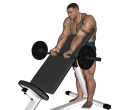 EZ Bar Curl - Standing Incline
EZ Bar Curl - Standing Incline
Benefits: This exercise works both heads of the biceps with a heavier weight than can typically be done with dumbbells.
Purpose: This exercise is used to target the biceps muscle to develop size, definition, strength, endurance and power.
Beginner Biceps Forearms Shoulders Strength EZ Bar Incline Bench Pull Gym
General Info: The biceps is a straight muscle with two heads. The long head of the biceps crosses both the elbow and the shoulder joint. It bends the elbow and raises the arm forward at the shoulder. The short head crosses the elbow joint and, in conjunction with the brachioradialis, supinates the hand.
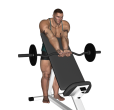 EZ Bar Curl - Standing Incline Close Grip
EZ Bar Curl - Standing Incline Close Grip
Benefits: This exercise works both heads of the biceps with a heavier weight than can typically be done with dumbbells.
Purpose: This exercise is used to target the biceps muscle to develop size, definition, strength, endurance and power.
Beginner Biceps Forearms Shoulders Strength EZ Bar Incline Bench Pull Gym
General Info: The biceps is a straight muscle with two heads. The long head of the biceps crosses both the elbow and the shoulder joint. It bends the elbow and raises the arm forward at the shoulder. The short head crosses the elbow joint and, in conjunction with the brachioradialis, supinates the hand.
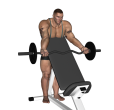 EZ Bar Curl - Standing Incline Wide Grip
EZ Bar Curl - Standing Incline Wide Grip
Benefits: This exercise works both heads of the biceps with a heavier weight than can typically be done with dumbbells.
Purpose: This exercise is used to target the biceps muscle to develop size, definition, strength, endurance and power.
Beginner Biceps Forearms Shoulders Strength EZ Bar Incline Bench Pull Gym
General Info: The biceps is a straight muscle with two heads. The long head of the biceps crosses both the elbow and the shoulder joint. It bends the elbow and raises the arm forward at the shoulder. The short head crosses the elbow joint and, in conjunction with the brachioradialis, supinates the hand.
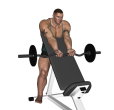 EZ Bar Curl - Standing Incline Wide Stance
EZ Bar Curl - Standing Incline Wide Stance
Benefits: This exercise works both heads of the biceps with a heavier weight than can typically be done with dumbbells.
Purpose: This exercise is used to target the biceps muscle to develop size, definition, strength, endurance and power.
Beginner Biceps Forearms Shoulders Strength EZ Bar Incline Bench Pull Gym
General Info: The biceps is a straight muscle with two heads. The long head of the biceps crosses both the elbow and the shoulder joint. It bends the elbow and raises the arm forward at the shoulder. The short head crosses the elbow joint and, in conjunction with the brachioradialis, supinates the hand.
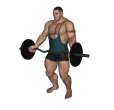 EZ Bar Curl - Standing Wide Grip
EZ Bar Curl - Standing Wide Grip
Benefits: This exercise puts the forearms in a stronger position, allowing you to lift heavier weights.
Purpose: This exercise is used to target the biceps muscle to develop size, definition, strength, endurance and power.
Beginner Biceps Forearms Shoulders Strength EZ Bar Pull Gym
General Info: The biceps is a straight muscle with two heads. The long head of the biceps crosses both the elbow and the shoulder joint. It bends the elbow and raises the arm forward at the shoulder. The short head crosses the elbow joint and, in conjunction with the brachioradialis, supinates the hand.
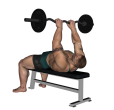 EZ Bar Press - Flat Bench Close Grip
EZ Bar Press - Flat Bench Close Grip
Benefits: This exercise works both heads of the triceps with a heavier weight than can typically be done with dumbbells.
Purpose: This exercise is used to target the triceps muscle to develop size, definition, strength, endurance and power.
Beginner Triceps Chest Shoulders Strength EZ Bar Flat Bench Push Compound Gym
General Info: The triceps is a straight muscle with three heads. The long head straightens the elbow, adducts the shoulder (brings it from a side position to the body) and extends the shoulder (brings the arm from a front position down to the body). The lateral head (outer head) straightens the elbow. The medial head also straightens the elbow.
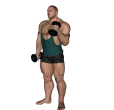 Hammer Curl - Alternate
Hammer Curl - Alternate
Benefits: The Alternative Hammer Curl places greater relative intensity on the biceps muscle.
Purpose: The Alternate Hammer Curl focuses on the biceps but also involves the brachioradialis.
Beginner Biceps Forearms Shoulders Strength Dumbbell Pull Gym
General Info: The biceps is a straight muscle with two heads. The long head of the biceps crosses both the elbow and the shoulder joints. It bends the elbow and raises the arm forward at the shoulder. The short head crosses the elbow joint and, in conjunction with the brachioradialis muscle, supinates the hand.
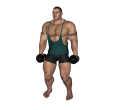 Hammer Curl - Basic
Hammer Curl - Basic
Benefits: The Hammer Curl places greater relative intensity on the biceps muscle. Using a hammer grip keeps the hands in a very strong position.
Purpose: The Hammer Curl focuses on the biceps but also involves the brachioradialis.
Beginner Biceps Forearms Shoulders Strength Dumbbell Pull Gym
General Info: The biceps is a straight muscle with two heads. The long head of the biceps crosses both the elbow and the shoulder joints. It bends the elbow and raises the arm forward at the shoulder. The short head crosses the elbow joint and, in conjunction with the brachioradialis muscle, supinates the hand.
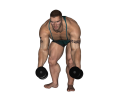 Hammer Curl - Bent Over
Hammer Curl - Bent Over
Benefits: This exercise is similar in effect to the Spider curl and does a good job of placing maximum tension on the biceps in the fully contracted position.
Purpose: This exercise works the biceps muscles but focuses also on the brachioradialis (a muscle that crosses the elbow joint and assists in rotating the forearm).
Beginner Biceps Forearms Shoulders Strength Dumbbell Pull Gym
General Info: The biceps is a straight muscle which has two heads. The long head crosses both the elbow and the shoulder joints. It bends the arm at the elbow and raises the arm forward at the shoulder. The short head crosses the elbow joint and, in conjunction with the brachioradialis, supinates the hand.
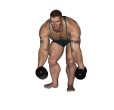 Hammer Curl - Bent Over Dumbbell Alternate
Hammer Curl - Bent Over Dumbbell Alternate
Benefits: This exercise does a good job of placing maximum tension on the biceps in the fully contracted position and also supinates the forearm..
Purpose: This exercise works the biceps muscles but focuses also on the brachioradialis (a muscle that crosses the elbow joint and assists in rotating the forearm).
Beginner Biceps Forearms Shoulders Strength Dumbbell Pull Gym
General Info: The biceps is a straight muscle which has two heads. The long head crosses both the elbow and the shoulder joints. It bends the arm at the elbow and raises the arm forward at the shoulder. The short head crosses the elbow joint and, in conjunction with the brachioradialis, supinates the hand.
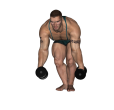 Hammer Curl - Bent Over Narrow Stance
Hammer Curl - Bent Over Narrow Stance
Benefits: This exercise does a good job of placing maximum tension on the biceps in the fully contracted position and also supinates the forearm..
Purpose: This exercise works the biceps muscles but focuses also on the brachioradialis (a muscle that crosses the elbow joint and assists in rotating the forearm).
Beginner Biceps Forearms Shoulders Strength Dumbbell Pull Gym
General Info: The biceps is a straight muscle which has two heads. The long head crosses both the elbow and the shoulder joints. It bends the arm at the elbow and raises the arm forward at the shoulder. The short head crosses the elbow joint and, in conjunction with the brachioradialis, supinates the hand.
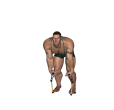 Hammer Curl - Bent Over Resistance
Hammer Curl - Bent Over Resistance
Benefits: This exercise is similar in effect to the Spider curl and does a good job of placing maximum tension on the biceps in the fully contracted position.
Purpose: This exercise works the biceps muscles but focuses also on the brachioradialis (a muscle that crosses the elbow joint and assists in rotating the forearm).
Beginner Biceps Forearms Shoulders Strength Resistance Tube Pull Gym
General Info: The biceps is a straight muscle which has two heads. The long head crosses both the elbow and the shoulder joints. It bends the arm at the elbow and raises the arm forward at the shoulder. The short head crosses the elbow joint and, in conjunction with the brachioradialis, supinates the hand.
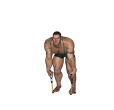 Hammer Curl - Bent Over Resistance Alternate
Hammer Curl - Bent Over Resistance Alternate
Benefits: This exercise is similar in effect to the Spider curl and does a good job of placing maximum tension on the biceps in the fully contracted position.
Purpose: This exercise works the biceps muscles but focuses also on the brachioradialis (a muscle that crosses the elbow joint and assists in rotating the forearm).
Beginner Biceps Forearms Shoulders Strength Resistance Tube Pull Gym
General Info: The biceps is a straight muscle which has two heads. The long head crosses both the elbow and the shoulder joints. It bends the arm at the elbow and raises the arm forward at the shoulder. The short head crosses the elbow joint and, in conjunction with the brachioradialis, supinates the hand.
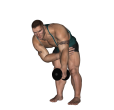 Hammer Curl - Bent Over Single
Hammer Curl - Bent Over Single
Benefits: The hammer curl places greater relative intensity on the brachioradialis muscle.
Purpose: The Alternate Hammer Curl focuses on the biceps but also involves the brachioradialis.
Beginner Biceps Forearms Shoulders Strength Dumbbell Pull Gym
General Info: The biceps is a straight muscle with two heads. The long head of the biceps crosses both the elbow and the shoulder joints. It bends the elbow and raises the arm forward at the shoulder. The short head crosses the elbow joint and, in conjunction with the brachioradialis muscle, supinates the hand.
 Hammer Curl - Bent Over Water Bottle
Hammer Curl - Bent Over Water Bottle
Benefits: This exercise is similar in effect to the Spider curl and does a good job of placing maximum tension on the biceps in the fully contracted position.
Purpose: This exercise works the biceps muscles but focuses also on the brachioradialis (a muscle that crosses the elbow joint and assists in rotating the forearm).
Beginner Biceps Forearms Shoulders Strength Water Bottle Pull Home
General Info: The biceps is a straight muscle which has two heads. The long head crosses both the elbow and the shoulder joints. It bends the arm at the elbow and raises the arm forward at the shoulder. The short head crosses the elbow joint and, in conjunction with the brachioradialis, supinates the hand.
 Hammer Curl - Bent Over Water Bottle Alternate
Hammer Curl - Bent Over Water Bottle Alternate
Benefits: This exercise does a good job of placing maximum tension on the biceps in the fully contracted position and also supinates the forearm..
Purpose: This exercise works the biceps muscles but focuses also on the brachioradialis (a muscle that crosses the elbow joint and assists in rotating the forearm).
Beginner Biceps Forearms Shoulders Strength Water Bottle Pull Home
General Info: The biceps is a straight muscle which has two heads. The long head crosses both the elbow and the shoulder joints. It bends the arm at the elbow and raises the arm forward at the shoulder. The short head crosses the elbow joint and, in conjunction with the brachioradialis, supinates the hand.
 Hammer Curl - Bent Over Water Bottle Narrow
Hammer Curl - Bent Over Water Bottle Narrow
Benefits: This exercise does a good job of placing maximum tension on the biceps in the fully contracted position and also supinates the forearm..
Purpose: This exercise works the biceps muscles but focuses also on the brachioradialis (a muscle that crosses the elbow joint and assists in rotating the forearm).
Beginner Biceps Forearms Shoulders Strength Water Bottle Pull Home
General Info: The biceps is a straight muscle which has two heads. The long head crosses both the elbow and the shoulder joints. It bends the arm at the elbow and raises the arm forward at the shoulder. The short head crosses the elbow joint and, in conjunction with the brachioradialis, supinates the hand.
 Hammer Curl - Bent Over Water Bottle Single
Hammer Curl - Bent Over Water Bottle Single
Benefits: The hammer curl places greater relative intensity on the brachioradialis muscle.
Purpose: The Alternate Hammer Curl focuses on the biceps but also involves the brachioradialis.
Beginner Biceps Forearms Shoulders Strength Water Bottle Pull Home
General Info: The biceps is a straight muscle with two heads. The long head of the biceps crosses both the elbow and the shoulder joints. It bends the elbow and raises the arm forward at the shoulder. The short head crosses the elbow joint and, in conjunction with the brachioradialis muscle, supinates the hand.
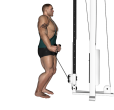 Hammer Curl - Cable Rope Attachment
Hammer Curl - Cable Rope Attachment
Benefits: The Cable Hammer Curl places greater relative intensity on the biceps muscle because there is always tension on the cable. Using a hammer grip keeps the hands in a very strong position.
Purpose: The Cable Hammer Curl focuses on the biceps but also involves the brachioradialis.
Beginner Biceps Forearms Shoulders Strength High Low Cable Machine Cable Rope Attachment Pull Gym
General Info: The biceps is a straight muscle with two heads. The long head of the biceps crosses both the elbow and the shoulder joints. It bends the elbow and raises the arm forward at the shoulder. The short head crosses the elbow joint and, in conjunction with the brachioradialis muscle, supinates the hand.
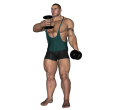 Hammer Curl - Cross Body
Hammer Curl - Cross Body
Benefits: This exercise works both heads of the biceps with a heavier weight than can typically be done with dumbbells.
Purpose: This exercise is used to target the biceps muscle to develop size, definition, strength, endurance and power.
Intermediate Biceps Forearms Shoulders Strength Dumbbell Pull Gym
General Info: The biceps is a straight muscle with two heads. The long head of the biceps crosses both the elbow and the shoulder joint. It bends the elbow and raises the arm forward at the shoulder. The short head crosses the elbow joint and, in conjunction with the brachioradialis, supinates the hand.
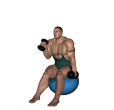 Hammer Curl - Fitness Ball Dumbbell Alternate
Hammer Curl - Fitness Ball Dumbbell Alternate
Benefits: This exercise isolates the biceps so that momentum does not come into play.
Purpose: This exercise strengthens the biceps.
Beginner Biceps Forearms Shoulders Traps Strength Dumbbell Fitness Ball Pull Gym
General Info: The biceps muscle is a straight muscle with 2 heads. The long head crosses both the elbow and shoulder joints and bends the elbow and raises the arm forward at the shoulder. The short head of the biceps crosses the elbow joint and, in conjunction with the brachioradialis, supinates the hand.
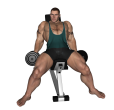 Hammer Curl - Incline Dumbbell
Hammer Curl - Incline Dumbbell
Benefits: The Hammer Curl places greater relative intensity on the biceps muscle.
Purpose: The Hammer Curl focuses on the biceps but also involves the brachioradialis.
Beginner Biceps Forearms Shoulders Strength Dumbbell Incline Bench Pull Gym
General Info: The biceps is a straight muscle with two heads. The long head of the biceps crosses both the elbow and the shoulder joints. It bends the elbow and raises the arm forward at the shoulder. The short head crosses the elbow joint and, in conjunction with the brachioradialis muscle, supinates the hand.
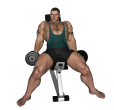 Hammer Curl - Incline Dumbbell Alternate
Hammer Curl - Incline Dumbbell Alternate
Benefits: The Alternative Hammer Curl places greater relative intensity on the biceps muscle.
Purpose: The Alternate Hammer Curl focuses on the biceps but also involves the brachioradialis.
Beginner Biceps Forearms Shoulders Strength Dumbbell Incline Bench Pull Gym
General Info: The biceps is a straight muscle with two heads. The long head of the biceps crosses both the elbow and the shoulder joints. It bends the elbow and raises the arm forward at the shoulder. The short head crosses the elbow joint and, in conjunction with the brachioradialis muscle, supinates the hand.
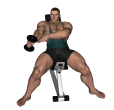 Hammer Curl - Incline Single
Hammer Curl - Incline Single
Benefits: This exercise works both heads of the biceps with a heavier weight than can typically be done with dumbbells.
Purpose: This exercise is used to target the biceps muscle to develop size, definition, strength, endurance and power.
Beginner Biceps Forearms Shoulders Strength Dumbbell Incline Bench Pull Gym
General Info: The biceps is a straight muscle with two heads. The long head of the biceps crosses both the elbow and the shoulder joint. It bends the elbow and raises the arm forward at the shoulder. The short head crosses the elbow joint and, in conjunction with the brachioradialis, supinates the hand.
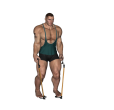 Hammer Curl - Resistance Tube
Hammer Curl - Resistance Tube
Benefits: The Alternative Hammer Curl places greater relative intensity on the biceps muscle. Using a hammer grip keeps the hands in a very strong position.
Purpose: The Alternate Hammer Curl focuses on the biceps but also involves the brachioradialis.
Beginner Biceps Forearms Shoulders Strength Resistance Tube Pull Gym
General Info: The biceps is a straight muscle with two heads. The long head of the biceps crosses both the elbow and the shoulder joints. It bends the elbow and raises the arm forward at the shoulder. The short head crosses the elbow joint and, in conjunction with the brachioradialis muscle, supinates the hand.
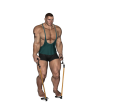 Hammer Curl - Resistance Tube Alternate
Hammer Curl - Resistance Tube Alternate
Benefits: The Alternative Hammer Curl places greater relative intensity on the biceps muscle. Using a hammer grip keeps the hands in a very strong position.
Purpose: The Alternate Hammer Curl focuses on the biceps but also involves the brachioradialis.
Beginner Biceps Forearms Shoulders Strength Resistance Tube Pull Gym
General Info: The biceps is a straight muscle with two heads. The long head of the biceps crosses both the elbow and the shoulder joints. It bends the elbow and raises the arm forward at the shoulder. The short head crosses the elbow joint and, in conjunction with the brachioradialis muscle, supinates the hand.
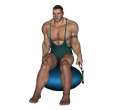 Hammer Curl - Resistance Tube Seated Single
Hammer Curl - Resistance Tube Seated Single
Benefits: This exercise isolates the biceps so that momentum does not come into play.
Purpose: This exercise strengthens the biceps.
Beginner Biceps Forearms Shoulders Traps Strength Resistance Tube Fitness Ball Pull Gym
General Info: The biceps muscle is a straight muscle with 2 heads. The long head crosses both the elbow and shoulder joints and bends the elbow and raises the arm forward at the shoulder. The short head of the biceps crosses the elbow joint and, in conjunction with the brachioradialis, supinates the hand.
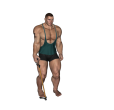 Hammer Curl - Resistance Tube Single
Hammer Curl - Resistance Tube Single
Benefits: This exercise works both heads of the biceps with a heavier weight than can typically be done with dumbbells.
Purpose: This exercise is used to target the biceps muscle to develop size, definition, strength, endurance and power.
Beginner Biceps Forearms Shoulders Strength Resistance Tube Pull Gym
General Info: The biceps is a straight muscle with two heads. The long head of the biceps crosses both the elbow and the shoulder joint. It bends the elbow and raises the arm forward at the shoulder. The short head crosses the elbow joint and, in conjunction with the brachioradialis, supinates the hand.
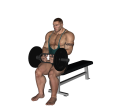 Hammer Curl - Seated Barbell
Hammer Curl - Seated Barbell
Benefits: This exercise isolates the biceps so that momentum does not come into play. Using a hammer grip keeps the hands in a very strong position.
Purpose: This exercise strengthens the biceps.
Beginner Biceps Forearms Shoulders Traps Strength Hammer Barbell Flat Bench Pull Gym
General Info: The biceps muscle is a straight muscle with 2 heads. The long head crosses both the elbow and shoulder joints and bends the elbow and raises the arm forward at the shoulder. The short head of the biceps crosses the elbow joint and, in conjunction with the brachioradialis, supinates the hand..
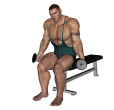 Hammer Curl - Seated Dumbbell
Hammer Curl - Seated Dumbbell
Benefits: This exercise isolates the biceps so that momentum does not come into play. Using a hammer grip keeps the hands in a very strong position.
Purpose: This exercise strengthens the biceps.
Beginner Biceps Forearms Shoulders Traps Strength Dumbbell Flat Bench Pull Gym
General Info: The biceps muscle is a straight muscle with 2 heads. The long head crosses both the elbow and shoulder joints and bends the elbow and raises the arm forward at the shoulder. The short head of the biceps crosses the elbow joint and, in conjunction with the brachioradialis, supinates the hand..
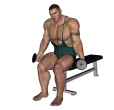 Hammer Curl - Seated Dumbbell Alternate
Hammer Curl - Seated Dumbbell Alternate
Benefits: This exercise isolates the biceps so that momentum does not come into play. Using a hammer grip keeps the hands in a very strong position.
Purpose: This exercise strengthens the biceps.
Beginner Biceps Forearms Shoulders Traps Strength Dumbbell Flat Bench Pull Gym
General Info: The biceps muscle is a straight muscle with 2 heads. The long head crosses both the elbow and shoulder joints and bends the elbow and raises the arm forward at the shoulder. The short head of the biceps crosses the elbow joint and, in conjunction with the brachioradialis, supinates the hand..
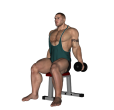 Hammer Curl - Seated Dumbbell Feet Up
Hammer Curl - Seated Dumbbell Feet Up
Benefits: This exercise isolates the biceps so that momentum does not come into play.
Purpose: This exercise strengthens the biceps.
Intermediate Biceps Forearms Shoulders Traps Strength Dumbbell Flat Bench Pull Gym
General Info: The biceps muscle is a straight muscle with 2 heads. The long head crosses both the elbow and shoulder joints and bends the elbow and raises the arm forward at the shoulder. The short head of the biceps crosses the elbow joint and, in conjunction with the brachioradialis, supinates the hand..
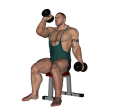 Hammer Curl - Seated Dumbbell Feet Up Alternate
Hammer Curl - Seated Dumbbell Feet Up Alternate
Benefits: This exercise isolates the biceps so that momentum does not come into play.
Purpose: This exercise strengthens the biceps.
Intermediate Biceps Forearms Shoulders Traps Strength Dumbbell Flat Bench Pull Gym
General Info: The biceps muscle is a straight muscle with 2 heads. The long head crosses both the elbow and shoulder joints and bends the elbow and raises the arm forward at the shoulder. The short head of the biceps crosses the elbow joint and, in conjunction with the brachioradialis, supinates the hand..
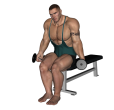 Hammer Curl - Seated Dumbbell Narrow
Hammer Curl - Seated Dumbbell Narrow
Benefits: This exercise isolates the biceps so that momentum does not come into play.
Purpose: This exercise strengthens the biceps.
Beginner Biceps Forearms Shoulders Traps Strength Dumbbell Flat Bench Pull Gym
General Info: The biceps muscle is a straight muscle with 2 heads. The long head crosses both the elbow and shoulder joints and bends the elbow and raises the arm forward at the shoulder. The short head of the biceps crosses the elbow joint and, in conjunction with the brachioradialis, supinates the hand..
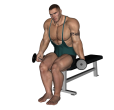 Hammer Curl - Seated Dumbbell Narrow Alternate
Hammer Curl - Seated Dumbbell Narrow Alternate
Benefits: This exercise isolates the biceps so that momentum does not come into play.
Purpose: This exercise strengthens the biceps.
Beginner Biceps Forearms Shoulders Traps Strength Dumbbell Flat Bench Pull Gym
General Info: The biceps muscle is a straight muscle with 2 heads. The long head crosses both the elbow and shoulder joints and bends the elbow and raises the arm forward at the shoulder. The short head of the biceps crosses the elbow joint and, in conjunction with the brachioradialis, supinates the hand..
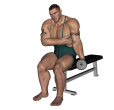 Hammer Curl - Seated Dumbbell Single
Hammer Curl - Seated Dumbbell Single
Benefits: This exercise isolates the biceps so that momentum does not come into play.
Purpose: This exercise strengthens the biceps.
Beginner Biceps Forearms Shoulders Traps Strength Dumbbell Flat Bench Pull Gym
General Info: The biceps muscle is a straight muscle with 2 heads. The long head crosses both the elbow and shoulder joints and bends the elbow and raises the arm forward at the shoulder. The short head of the biceps crosses the elbow joint and, in conjunction with the brachioradialis, supinates the hand..
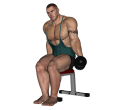 Hammer Curl - Seated Dumbbell Single Narrow
Hammer Curl - Seated Dumbbell Single Narrow
Benefits: This exercise isolates the biceps so that momentum does not come into play.
Purpose: This exercise strengthens the biceps.
Beginner Biceps Forearms Shoulders Traps Strength Dumbbell Flat Bench Pull Gym
General Info: The biceps muscle is a straight muscle with 2 heads. The long head crosses both the elbow and shoulder joints and bends the elbow and raises the arm forward at the shoulder. The short head of the biceps crosses the elbow joint and, in conjunction with the brachioradialis, supinates the hand..
 Hammer Curl - Seated Water Bottle
Hammer Curl - Seated Water Bottle
Benefits: This exercise isolates the biceps so that momentum does not come into play.
Purpose: This exercise strengthens the biceps.
Beginner Biceps Forearms Shoulders Traps Strength Water Bottle Chair Pull Home
General Info: The biceps muscle is a straight muscle with 2 heads. The long head crosses both the elbow and shoulder joints and bends the elbow and raises the arm forward at the shoulder. The short head of the biceps crosses the elbow joint and, in conjunction with the brachioradialis, supinates the hand..
 Hammer Curl - Seated Water Bottle Alternate
Hammer Curl - Seated Water Bottle Alternate
Benefits: This exercise isolates the biceps so that momentum does not come into play.
Purpose: This exercise strengthens the biceps.
Beginner Biceps Forearms Shoulders Traps Strength Water Bottle Chair Pull Home
General Info: The biceps muscle is a straight muscle with 2 heads. The long head crosses both the elbow and shoulder joints and bends the elbow and raises the arm forward at the shoulder. The short head of the biceps crosses the elbow joint and, in conjunction with the brachioradialis, supinates the hand..
 Hammer Curl - Seated Water Bottle Feet Up
Hammer Curl - Seated Water Bottle Feet Up
Benefits: This exercise isolates the biceps so that momentum does not come into play.
Purpose: This exercise strengthens the biceps.
Intermediate Biceps Forearms Shoulders Traps Strength Water Bottle Chair Pull Home
General Info: The biceps muscle is a straight muscle with 2 heads. The long head crosses both the elbow and shoulder joints and bends the elbow and raises the arm forward at the shoulder. The short head of the biceps crosses the elbow joint and, in conjunction with the brachioradialis, supinates the hand..
 Hammer Curl - Seated Water Bottle Feet Up Alternate
Hammer Curl - Seated Water Bottle Feet Up Alternate
Benefits: This exercise isolates the biceps so that momentum does not come into play.
Purpose: This exercise strengthens the biceps.
Intermediate Biceps Forearms Shoulders Traps Strength Water Bottle Chair Pull Home
General Info: The biceps muscle is a straight muscle with 2 heads. The long head crosses both the elbow and shoulder joints and bends the elbow and raises the arm forward at the shoulder. The short head of the biceps crosses the elbow joint and, in conjunction with the brachioradialis, supinates the hand..
 Hammer Curl - Seated Water Bottle Narrow
Hammer Curl - Seated Water Bottle Narrow
Benefits: This exercise isolates the biceps so that momentum does not come into play.
Purpose: This exercise strengthens the biceps.
Beginner Biceps Forearms Shoulders Traps Strength Water Bottle Chair Pull Home
General Info: The biceps muscle is a straight muscle with 2 heads. The long head crosses both the elbow and shoulder joints and bends the elbow and raises the arm forward at the shoulder. The short head of the biceps crosses the elbow joint and, in conjunction with the brachioradialis, supinates the hand..
 Hammer Curl - Seated Water Bottle Narrow Alternate
Hammer Curl - Seated Water Bottle Narrow Alternate
Benefits: This exercise isolates the biceps so that momentum does not come into play.
Purpose: This exercise strengthens the biceps.
Beginner Biceps Forearms Shoulders Traps Strength Water Bottle Chair Pull Home
General Info: The biceps muscle is a straight muscle with 2 heads. The long head crosses both the elbow and shoulder joints and bends the elbow and raises the arm forward at the shoulder. The short head of the biceps crosses the elbow joint and, in conjunction with the brachioradialis, supinates the hand..
 Hammer Curl - Seated Water Bottle Single
Hammer Curl - Seated Water Bottle Single
Benefits: This exercise isolates the biceps so that momentum does not come into play.
Purpose: This exercise strengthens the biceps.
Beginner Biceps Forearms Shoulders Traps Strength Water Bottle Chair Pull Home
General Info: The biceps muscle is a straight muscle with 2 heads. The long head crosses both the elbow and shoulder joints and bends the elbow and raises the arm forward at the shoulder. The short head of the biceps crosses the elbow joint and, in conjunction with the brachioradialis, supinates the hand..
 Hammer Curl - Seated Water Bottle Single Narrow
Hammer Curl - Seated Water Bottle Single Narrow
Benefits: This exercise isolates the biceps so that momentum does not come into play.
Purpose: This exercise strengthens the biceps.
Beginner Biceps Forearms Shoulders Traps Strength Water Bottle Chair Pull Home
General Info: The biceps muscle is a straight muscle with 2 heads. The long head crosses both the elbow and shoulder joints and bends the elbow and raises the arm forward at the shoulder. The short head of the biceps crosses the elbow joint and, in conjunction with the brachioradialis, supinates the hand..
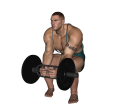 Hammer Curl - Squat Barbell
Hammer Curl - Squat Barbell
Benefits: This exercise isolates the biceps so that momentum does not come into play.
Purpose: This exercise strengthens the biceps.
Intermediate Biceps Forearms Shoulders Traps Strength Hammer Barbell Pull Gym
General Info: The biceps muscle is a straight muscle with 2 heads. The long head crosses both the elbow and shoulder joints and bends the elbow and raises the arm forward at the shoulder. The short head of the biceps crosses the elbow joint and, in conjunction with the brachioradialis, supinates the hand..
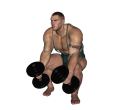 Hammer Curl - Squat Dumbbell
Hammer Curl - Squat Dumbbell
Benefits: This exercise isolates the biceps so that momentum does not come into play.
Purpose: This exercise strengthens the biceps.
Beginner Biceps Forearms Shoulders Traps Strength Dumbbell Pull Gym
General Info: The biceps muscle is a straight muscle with 2 heads. The long head crosses both the elbow and shoulder joints and bends the elbow and raises the arm forward at the shoulder. The short head of the biceps crosses the elbow joint and, in conjunction with the brachioradialis, supinates the hand..
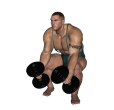 Hammer Curl - Squat Dumbbell Single
Hammer Curl - Squat Dumbbell Single
Benefits: This exercise isolates the biceps so that momentum does not come into play.
Purpose: This exercise strengthens the biceps.
Beginner Biceps Forearms Shoulders Traps Strength Dumbbell Pull Gym
General Info: The biceps muscle is a straight muscle with 2 heads. The long head crosses both the elbow and shoulder joints and bends the elbow and raises the arm forward at the shoulder. The short head of the biceps crosses the elbow joint and, in conjunction with the brachioradialis, supinates the hand..
 Hammer Curl - Squat Water Bottle
Hammer Curl - Squat Water Bottle
Benefits: This exercise isolates the biceps so that momentum does not come into play.
Purpose: This exercise strengthens the biceps.
Beginner Biceps Forearms Shoulders Traps Strength Water Bottle Pull Home
General Info: The biceps muscle is a straight muscle with 2 heads. The long head crosses both the elbow and shoulder joints and bends the elbow and raises the arm forward at the shoulder. The short head of the biceps crosses the elbow joint and, in conjunction with the brachioradialis, supinates the hand..
 Hammer Curl - Squat Water Bottle Single
Hammer Curl - Squat Water Bottle Single
Benefits: This exercise isolates the biceps so that momentum does not come into play.
Purpose: This exercise strengthens the biceps.
Beginner Biceps Forearms Shoulders Traps Strength Water Bottle Pull Home
General Info: The biceps muscle is a straight muscle with 2 heads. The long head crosses both the elbow and shoulder joints and bends the elbow and raises the arm forward at the shoulder. The short head of the biceps crosses the elbow joint and, in conjunction with the brachioradialis, supinates the hand..
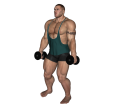 Hammer Curl - Standing
Hammer Curl - Standing
Benefits: This exercise works both heads of the biceps with a heavier weight than can typically be done with dumbbells.
Purpose: This exercise is used to target the biceps. Using a hammer grip keeps the hands in a very strong position.
Beginner Biceps Forearms Shoulders Strength Dumbbell Pull Gym
General Info: The biceps is a straight muscle with two heads. The long head of the biceps crosses both the elbow and the shoulder joint. It bends the elbow and raises the arm forward at the shoulder. The short head crosses the elbow joint and, in conjunction with the brachioradialis, supinates the hand.
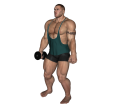 Hammer Curl - Standing Dumbbell Single
Hammer Curl - Standing Dumbbell Single
Benefits: This exercise isolates the biceps so that momentum does not come into play. Using a hammer grip keeps the hands in a very strong position.
Purpose: This exercise strengthens the biceps.
Beginner Biceps Forearms Shoulders Traps Strength Dumbbell Pull Gym
General Info: The biceps muscle is a straight muscle with 2 heads. The long head crosses both the elbow and shoulder joints and bends the elbow and raises the arm forward at the shoulder. The short head of the biceps crosses the elbow joint and, in conjunction with the brachioradialis, supinates the hand..
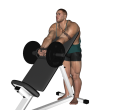 Hammer Curl - Standing Incline Barbell
Hammer Curl - Standing Incline Barbell
Benefits: This exercise works both heads of the biceps similar to a hammer barbell preacher curl.
Purpose: This exercise is used to target the biceps muscle to develop size, definition, strength, endurance and power.
Beginner Biceps Forearms Shoulders Strength Hammer Barbell Incline Bench Pull Gym
General Info: The biceps is a straight muscle with two heads. The long head of the biceps crosses both the elbow and the shoulder joint. It bends the elbow and raises the arm forward at the shoulder. The short head crosses the elbow joint and, in conjunction with the brachioradialis, supinates the hand.
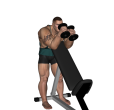 Hammer Curl - Standing Incline Dumbbell
Hammer Curl - Standing Incline Dumbbell
Benefits: This exercise works both heads of the biceps similar to a hammer dumbbell preacher curl.
Purpose: This exercise is used to target the biceps muscle to develop size, definition, strength, endurance and power.
Beginner Biceps Forearms Shoulders Strength Dumbbell Incline Bench Pull Gym
General Info: The biceps is a straight muscle with two heads. The long head of the biceps crosses both the elbow and the shoulder joint. It bends the elbow and raises the arm forward at the shoulder. The short head crosses the elbow joint and, in conjunction with the brachioradialis, supinates the hand.
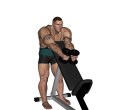 Hammer Curl - Standing Incline Dumbbell Alternate
Hammer Curl - Standing Incline Dumbbell Alternate
Benefits: This exercise works both heads of the biceps with a heavier weight than can typically be done with dumbbells.
Purpose: This exercise is used to target the biceps muscle to develop size, definition, strength, endurance and power.
Beginner Biceps Forearms Shoulders Strength Dumbbell Incline Bench Pull Gym
General Info: The biceps is a straight muscle with two heads. The long head of the biceps crosses both the elbow and the shoulder joint. It bends the elbow and raises the arm forward at the shoulder. The short head crosses the elbow joint and, in conjunction with the brachioradialis, supinates the hand.
 Hammer Curl - Standing Water Bottle
Hammer Curl - Standing Water Bottle
Benefits: This exercise works both heads of the biceps with a heavier weight than can typically be done with dumbbells.
Purpose: This exercise is used to target the biceps muscle to develop size, definition, strength, endurance and power.
Beginner Biceps Forearms Shoulders Strength Water Bottle Pull Home
General Info: The biceps is a straight muscle with two heads. The long head of the biceps crosses both the elbow and the shoulder joint. It bends the elbow and raises the arm forward at the shoulder. The short head crosses the elbow joint and, in conjunction with the brachioradialis, supinates the hand.
 Hammer Curl - Standing Water Bottle Single
Hammer Curl - Standing Water Bottle Single
Benefits: This exercise isolates the biceps so that momentum does not come into play.
Purpose: This exercise strengthens the biceps.
Beginner Biceps Forearms Shoulders Traps Strength Water Bottle Pull Home
General Info: The biceps muscle is a straight muscle with 2 heads. The long head crosses both the elbow and shoulder joints and bends the elbow and raises the arm forward at the shoulder. The short head of the biceps crosses the elbow joint and, in conjunction with the brachioradialis, supinates the hand..
 Hammer Curl - Water Bottle Alternate
Hammer Curl - Water Bottle Alternate
Benefits: The Alternative Hammer Curl places greater relative intensity on the biceps muscle.
Purpose: The Alternate Hammer Curl focuses on the biceps but also involves the brachioradialis.
Beginner Biceps Forearms Shoulders Strength Water Bottle Pull Home
General Info: The biceps is a straight muscle with two heads. The long head of the biceps crosses both the elbow and the shoulder joints. It bends the elbow and raises the arm forward at the shoulder. The short head crosses the elbow joint and, in conjunction with the brachioradialis muscle, supinates the hand.
 Hammer Curl - Water Bottle Basic
Hammer Curl - Water Bottle Basic
Benefits: The Hammer Curl places greater relative intensity on the biceps muscle.
Purpose: The Hammer Curl focuses on the biceps but also involves the brachioradialis.
Beginner Biceps Forearms Shoulders Strength Water Bottle Pull Home
General Info: The biceps is a straight muscle with two heads. The long head of the biceps crosses both the elbow and the shoulder joints. It bends the elbow and raises the arm forward at the shoulder. The short head crosses the elbow joint and, in conjunction with the brachioradialis muscle, supinates the hand.
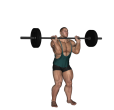 Jerk - Balance
Jerk - Balance
Benefits: The press is a highly effective compound upper-body exercise.
Purpose: The push press is a good exercise for building up and strengthening the shoulder region.
Intermediate Shoulders Triceps Strength Barbell Push Compound Gym
General Info: The Deltoids is a fan-shaped muscle. The Anterior (Front) Deltoid raises the arm toward the front of the body and rotates the arm inward. The Lateral (Side) Deltoid raises the arm to the side. The Posterior (Rear) Deltoid raises the arm toward the rear and rotates the arm outward.
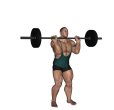 Jerk - Split
Jerk - Split
Benefits: The press is a highly effective compound upper-body exercise.
Purpose: The push press is a good exercise for building up and strengthening the shoulder region.
Intermediate Shoulders Triceps Strength Barbell Push Compound Gym
General Info: The Deltoids is a fan-shaped muscle. The Anterior (Front) Deltoid raises the arm toward the front of the body and rotates the arm inward. The Lateral (Side) Deltoid raises the arm to the side. The Posterior (Rear) Deltoid raises the arm toward the rear and rotates the arm outward.
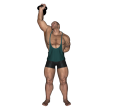 Kettlebell - Advanced Windmill
Kettlebell - Advanced Windmill
Benefits: This exercise trains the deep core muscles.
Purpose: This exercise strengthens the abdominal muscles.
Abdominals Hamstrings Shoulders Glutes Strength Kettlebell Push Compound Gym
General Info: The abs can be divided into the abdominals themselves and the obliques. The obliques are the outer abs and are used in twisting movements. For the sake of exercising, the abdominals are sometimes divided into upper abs and lower abs (this is not a technical division but something for exercising). Both upper and lower abs are used in straight line ab exercises while the upper abs are also involved in twisting movements.
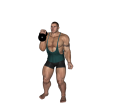 Kettlebell - Arnold Press
Kettlebell - Arnold Press
Benefits: Arnold Press vs a Barbell Press gives a wide range of motion as you lower the dumbbells well down in front giving that maximum stretch other shoulder exercises lack. Essentially it is a combination of two moves which isolate shoulder muscles - shoulder press and a lateral raise.
Purpose: To build muscle mass in the front and side heads of the deltoids. Arnold Shoulder Press is an excellent alternative to Shoulder Dumbbell press and can be used to spice up your workouts. I perform Arnold press and shoulder dumbbell presses on alternate weeks for variety in my workouts.
Intermediate Shoulders Forearms Triceps Strength Kettlebell Push Compound Gym
General Info: When it comes to the best exercise with the best range of motion for Shoulder muscles, Arnold press stands out from the crowd. It was created by bodybuilder Arnold Schwarzenegger and hits both the medial and front heads of deltoids.
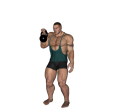 Kettlebell - Bent Press
Kettlebell - Bent Press
Benefits: The press is a highly effective compound upper-body exercise. It also works the oblique muscles.
Purpose: The Barbell Shoulder Press (sometimes called the Military Press) is a good exercise for building up and strengthening the shoulder region.
Shoulders Triceps Strength Kettlebell Push Compound Gym
General Info: The Deltoids is a fan-shaped muscle. The Anterior (Front) Deltoid raises the arm toward the front of the body and rotates the arm inward. The Lateral (Side) Deltoid raises the arm to the side. The Posterior (Rear) Deltoid raises the arm toward the rear and rotates the arm outward.
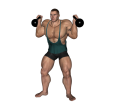 Kettlebell - Double Jerk
Kettlebell - Double Jerk
Benefits: The press is a highly effective compound upper-body exercise.
Purpose: The push press is a good exercise for building up and strengthening the shoulder region.
Shoulders Triceps Strength Kettlebell Push Compound Gym
General Info: The Deltoids is a fan-shaped muscle. The Anterior (Front) Deltoid raises the arm toward the front of the body and rotates the arm inward. The Lateral (Side) Deltoid raises the arm to the side. The Posterior (Rear) Deltoid raises the arm toward the rear and rotates the arm outward.
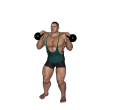 Kettlebell - Double Push Press
Kettlebell - Double Push Press
Benefits: The press is a highly effective compound upper-body exercise.
Purpose: The press is a good exercise for building up and strengthening the shoulder region.
Intermediate Shoulders Triceps Strength Kettlebell Push Compound Gym
General Info: The Deltoids is a fan-shaped muscle. The Anterior (Front) Deltoid raises the arm toward the front of the body and rotates the arm inward. The Lateral (Side) Deltoid raises the arm to the side. The Posterior (Rear) Deltoid raises the arm toward the rear and rotates the arm outward.
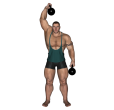 Kettlebell - Double Windmill
Kettlebell - Double Windmill
Benefits: This exercise trains the deep core muscles.
Purpose: This exercise strengthens the abdominal muscles.
Abdominals Hamstrings Shoulders Glutes Triceps Strength Kettlebell Compound Gym
General Info: The abs can be divided into the abdominals themselves and the obliques. The obliques are the outer abs and are used in twisting movements. For the sake of exercising, the abdominals are sometimes divided into upper abs and lower abs (this is not a technical division but something for exercising). Both upper and lower abs are used in straight line ab exercises while the upper abs are also involved in twisting movements.
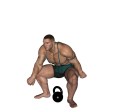 Kettlebell - Figure 8
Kettlebell - Figure 8
Benefits: This exercise trains the deep core muscles.
Purpose: This exercise strengthens the abdominal muscles.
Intermediate Abdominals Shoulders Strength Kettlebell Compound Gym
General Info: The abs can be divided into the abdominals themselves and the obliques. The obliques are the outer abs and are used in twisting movements. For the sake of exercising, the abdominals are sometimes divided into upper abs and lower abs (this is not a technical division but something for exercising). Both upper and lower abs are used in straight line ab exercises while the upper abs are also involved in twisting movements.
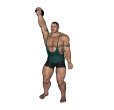 Kettlebell - Fundamental Windmill
Kettlebell - Fundamental Windmill
Benefits: This exercise trains the deep core muscles.
Purpose: This exercise strengthens the abdominal muscles.
Intermediate Abdominals Hamstrings Shoulders Glutes Strength Kettlebell Push Compound Gym
General Info: The abs can be divided into the abdominals themselves and the obliques. The obliques are the outer abs and are used in twisting movements. For the sake of exercising, the abdominals are sometimes divided into upper abs and lower abs (this is not a technical division but something for exercising). Both upper and lower abs are used in straight line ab exercises while the upper abs are also involved in twisting movements.
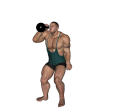 Kettlebell - One Arm Jerk
Kettlebell - One Arm Jerk
Benefits: The press is a highly effective compound upper-body exercise.
Purpose: The push press is a good exercise for building up and strengthening the shoulder region.
Shoulders Triceps Strength Kettlebell Push Compound Gym
General Info: The Deltoids is a fan-shaped muscle. The Anterior (Front) Deltoid raises the arm toward the front of the body and rotates the arm inward. The Lateral (Side) Deltoid raises the arm to the side. The Posterior (Rear) Deltoid raises the arm toward the rear and rotates the arm outward.
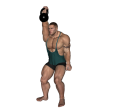 Kettlebell - One Arm Military Press To The Side
Kettlebell - One Arm Military Press To The Side
Benefits: The press is a highly effective compound upper-body exercise.
Purpose: The Military Press is a good exercise for building up and strengthening the shoulder region.
Shoulders Triceps Chest Strength Kettlebell Push Compound Gym
General Info: The Deltoids is a fan-shaped muscle. The Anterior (Front) Deltoid raises the arm toward the front of the body and rotates the arm inward. The Lateral (Side) Deltoid raises the arm to the side. The Posterior (Rear) Deltoid raises the arm toward the rear and rotates the arm outward.
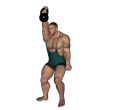 Kettlebell - One Arm Para Press
Kettlebell - One Arm Para Press
Benefits: The press is a highly effective compound upper-body exercise.
Purpose: This exercise is a good exercise for building up and strengthening the shoulder region.
Shoulders Triceps Chest Strength Kettlebell Push Compound Gym
General Info: The Deltoids is a fan-shaped muscle. The Anterior (Front) Deltoid raises the arm toward the front of the body and rotates the arm inward. The Lateral (Side) Deltoid raises the arm to the side. The Posterior (Rear) Deltoid raises the arm toward the rear and rotates the arm outward.
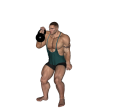 Kettlebell - One Arm Push Press
Kettlebell - One Arm Push Press
Benefits: The press is a highly effective compound upper-body exercise.
Purpose: The push press is a good exercise for building up and strengthening the shoulder region.
Intermediate Shoulders Triceps Chest Strength Kettlebell Push Compound Gym
General Info: The Deltoids is a fan-shaped muscle. The Anterior (Front) Deltoid raises the arm toward the front of the body and rotates the arm inward. The Lateral (Side) Deltoid raises the arm to the side. The Posterior (Rear) Deltoid raises the arm toward the rear and rotates the arm outward.
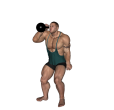 Kettlebell - One Arm Split Jerk
Kettlebell - One Arm Split Jerk
Benefits: The press is a highly effective compound upper-body exercise.
Purpose: The push press is a good exercise for building up and strengthening the shoulder region.
Shoulders Triceps Strength Kettlebell Push Compound Gym
General Info: The Deltoids is a fan-shaped muscle. The Anterior (Front) Deltoid raises the arm toward the front of the body and rotates the arm inward. The Lateral (Side) Deltoid raises the arm to the side. The Posterior (Rear) Deltoid raises the arm toward the rear and rotates the arm outward.
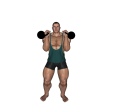 Kettlebell - Press Alternate
Kettlebell - Press Alternate
Benefits: The press is a highly effective compound upper-body exercise.
Purpose: The Barbell Shoulder Press (sometimes called the Military Press) is a good exercise for building up and strengthening the shoulder region.
Beginner Shoulders Triceps Strength Kettlebell Push Compound Gym
General Info: The Deltoids is a fan-shaped muscle. The Anterior (Front) Deltoid raises the arm toward the front of the body and rotates the arm inward. The Lateral (Side) Deltoid raises the arm to the side. The Posterior (Rear) Deltoid raises the arm toward the rear and rotates the arm outward.
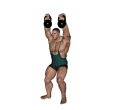 Kettlebell - Seesaw Press
Kettlebell - Seesaw Press
Benefits: The press is a highly effective compound upper-body exercise.
Purpose: The Military Press is a good exercise for building up and strengthening the shoulder region.
Intermediate Shoulders Triceps Chest Strength Kettlebell Push Compound Gym
General Info: The Deltoids is a fan-shaped muscle. The Anterior (Front) Deltoid raises the arm toward the front of the body and rotates the arm inward. The Lateral (Side) Deltoid raises the arm to the side. The Posterior (Rear) Deltoid raises the arm toward the rear and rotates the arm outward.
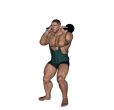 Kettlebell - Thruster
Kettlebell - Thruster
Benefits: It is one of the best exercises to develop full body strength and increase your fat-burning metabolism.
Purpose: To develop core strength of the lower and middle body.
Intermediate Quads Glutes Hamstrings Calves Lower Back Shoulders Strength Kettlebell Push Compound Gym
General Info: The quads are a set of four muscles in the upper front thigh. All four muscles work to straighten the knee. One of the four (rectus femoris) also helps to bend the hip. Squats are considered a vital exercise for increasing the strength and size of the legs and butt.
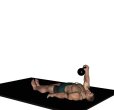 Kettlebell - Turkish Get Up Lunge Style
Kettlebell - Turkish Get Up Lunge Style
Benefits: This exercise is a highly effective compound upper-body exercise. It also works the quads.
Purpose: The exercise is a good exercise for building up and strengthening the shoulder region.
Shoulders Triceps Quads Strength Kettlebell Push Compound Gym
General Info: The Deltoids is a fan-shaped muscle. The Anterior (Front) Deltoid raises the arm toward the front of the body and rotates the arm inward. The Lateral (Side) Deltoid raises the arm to the side. The Posterior (Rear) Deltoid raises the arm toward the rear and rotates the arm outward.
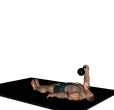 Kettlebell - Turkish Get Up Squat Style
Kettlebell - Turkish Get Up Squat Style
Benefits: This exercise is a highly effective compound upper-body exercise. It also works the quads.
Purpose: The exercise is a good exercise for building up and strengthening the shoulder region.
Shoulders Triceps Quads Strength Kettlebell Push Compound Gym
General Info: The Deltoids is a fan-shaped muscle. The Anterior (Front) Deltoid raises the arm toward the front of the body and rotates the arm inward. The Lateral (Side) Deltoid raises the arm to the side. The Posterior (Rear) Deltoid raises the arm toward the rear and rotates the arm outward.
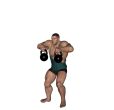 Kettlebell - Two Arm Jerk
Kettlebell - Two Arm Jerk
Benefits: The jerk is a highly effective compound upper-body exercise.
Purpose: The jerk is a good exercise for building up and strengthening the shoulder region.
Shoulders Triceps Strength Kettlebell Push Compound Gym
General Info: The Deltoids is a fan-shaped muscle. The Anterior (Front) Deltoid raises the arm toward the front of the body and rotates the arm inward. The Lateral (Side) Deltoid raises the arm to the side. The Posterior (Rear) Deltoid raises the arm toward the rear and rotates the arm outward.
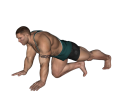 Mountain Climber - Basic
Mountain Climber - Basic
Benefits: It is the single best exercise to develop full body strength and increase your fat-burning metabolism.
Purpose: To develop core strength of the lower and middle body.
Intermediate Quads Hip Flexors Hip Extensors Shoulders Body Only Gym Home
General Info: The quads are a set of four muscles in the upper front thigh. All four muscles work to straighten the knee. One of the four (rectus femoris) also helps to bend the hip. Squats are considered a vital exercise for increasing the strength and size of the legs and butt.
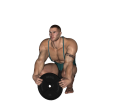 Plate Curl - Squat
Plate Curl - Squat
Benefits: This exercise isolates the biceps so that momentum does not come into play.
Purpose: This exercise strengthens the biceps.
Intermediate Biceps Forearms Shoulders Traps Strength Plate Pull Gym
General Info: The biceps muscle is a straight muscle with 2 heads. The long head crosses both the elbow and shoulder joints and bends the elbow and raises the arm forward at the shoulder. The short head of the biceps crosses the elbow joint and, in conjunction with the brachioradialis, supinates the hand..
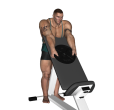 Plate Curl - Standing Incline
Plate Curl - Standing Incline
Benefits: This exercise works both heads of the biceps and is very similar to the preacher curl.
Purpose: This exercise is used to target the biceps muscle to develop size, definition, strength, endurance and power.
Beginner Biceps Forearms Shoulders Strength Plate Incline Bench Pull Gym
General Info: The biceps is a straight muscle with two heads. The long head of the biceps crosses both the elbow and the shoulder joint. It bends the elbow and raises the arm forward at the shoulder. The short head crosses the elbow joint and, in conjunction with the brachioradialis, supinates the hand.
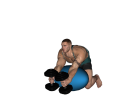 Preacher Curl - Ball Dumbbell Hammer Single
Preacher Curl - Ball Dumbbell Hammer Single
Benefits: This exercise isolates the biceps so that momentum does not come into play.
Purpose: This exercise strengthens the biceps.
Beginner Biceps Forearms Shoulders Traps Strength Dumbbell Fitness Ball Pull Gym
General Info: The biceps muscle is a straight muscle with 2 heads. The long head crosses both the elbow and shoulder joints and bends the elbow and raises the arm forward at the shoulder. The short head of the biceps crosses the elbow joint and, in conjunction with the brachioradialis, supinates the hand.
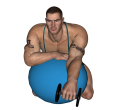 Preacher Curl - Ball Dumbbell Zottman Single
Preacher Curl - Ball Dumbbell Zottman Single
Benefits: This exercise isolates the biceps so that momentum does not come into play.
Purpose: This exercise strengthens the biceps.
Beginner Biceps Forearms Shoulders Traps Strength Dumbbell Fitness Ball Pull Gym
General Info: The biceps muscle is a straight muscle with 2 heads. The long head crosses both the elbow and shoulder joints and bends the elbow and raises the arm forward at the shoulder. The short head of the biceps crosses the elbow joint and, in conjunction with the brachioradialis, supinates the hand.
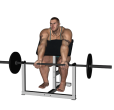 Preacher Curl - Barbell
Preacher Curl - Barbell
Benefits: This exercise isolates the biceps so that momentum does not come into play.
Purpose: This exercise strengthens the biceps.
Beginner Biceps Forearms Shoulders Traps Strength Barbell Preacher Bench Pull Gym
General Info: The biceps muscle is a straight muscle with 2 heads. The long head crosses both the elbow and shoulder joints and bends the elbow and raises the arm forward at the shoulder. The short head of the biceps crosses the elbow joint and, in conjunction with the brachioradialis, supinates the hand.
 Preacher Curl - Barbell With Chains
Preacher Curl - Barbell With Chains
Benefits: This exercise is done with the addition of chains. The primary function of chains is to accommodate resistance. Chains are also a great means of weight loading (adding more weight to an exercise). Chains are also a great way for working the stabilizers.
Purpose: Benefits This exercise isolates the biceps so that momentum does not come into play.
Beginner Biceps Forearms Shoulders Traps Strength Barbell Chains Preacher Bench Pull Gym
General Info: The biceps muscle is a straight muscle with 2 heads. The long head crosses both the elbow and shoulder joints and bends the elbow and raises the arm forward at the shoulder. The short head of the biceps crosses the elbow joint and, in conjunction with the brachioradialis, supinates the hand.
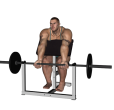 Preacher Curl - Basic
Preacher Curl - Basic
Benefits: This exercise isolates the biceps so that momentum does not come into play.
Purpose: This exercise strengthens the biceps.
Beginner Biceps Forearms Shoulders Traps Strength Barbell Preacher Bench Pull Gym
General Info: The biceps muscle is a straight muscle with 2 heads. The long head crosses both the elbow and shoulder joints and bends the elbow and raises the arm forward at the shoulder. The short head of the biceps crosses the elbow joint and, in conjunction with the brachioradialis, supinates the hand.
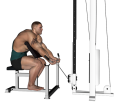 Preacher Curl - Cable
Preacher Curl - Cable
Benefits: This exercise isolates the biceps so that momentum does not come into play. The cable keeps tension on the muscles throughout the exercise.
Purpose: This exercise strengthens the biceps.
Beginner Biceps Forearms Shoulders Traps Strength Cable Machine Preacher Bench Pull Gym
General Info: The biceps muscle is a straight muscle with 2 heads. The long head crosses both the elbow and shoulder joints and bends the elbow and raises the arm forward at the shoulder. The short head of the biceps crosses the elbow joint and, in conjunction with the brachioradialis, supinates the hand.
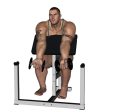 Preacher Curl - Dumbbell
Preacher Curl - Dumbbell
Benefits: This exercise isolates the biceps so that momentum does not come into play.
Purpose: This exercise strengthens the biceps.
Beginner Biceps Forearms Shoulders Traps Strength Dumbbell Preacher Bench Pull Gym
General Info: The biceps muscle is a straight muscle with 2 heads. The long head crosses both the elbow and shoulder joints and bends the elbow and raises the arm forward at the shoulder. The short head of the biceps crosses the elbow joint and, in conjunction with the brachioradialis, supinates the hand.
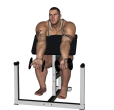 Preacher Curl - Dumbbell Alternate
Preacher Curl - Dumbbell Alternate
Benefits: This exercise isolates the biceps so that momentum does not come into play.
Purpose: This exercise strengthens the biceps.
Beginner Biceps Forearms Shoulders Traps Strength Dumbbell Preacher Bench Pull Gym
General Info: The biceps muscle is a straight muscle with 2 heads. The long head crosses both the elbow and shoulder joints and bends the elbow and raises the arm forward at the shoulder. The short head of the biceps crosses the elbow joint and, in conjunction with the brachioradialis, supinates the hand.
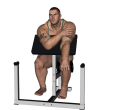 Preacher Curl - Dumbbell Reverse Single
Preacher Curl - Dumbbell Reverse Single
Benefits: This exercise isolates the biceps so that momentum does not come into play. The reverse grip makes the exercise more difficult.
Purpose: This exercise strengthens the biceps.
Beginner Biceps Forearms Shoulders Traps Strength Dumbbell Preacher Bench Pull Gym
General Info: The biceps muscle is a straight muscle with 2 heads. The long head crosses both the elbow and shoulder joints and bends the elbow and raises the arm forward at the shoulder. The short head of the biceps crosses the elbow joint and, in conjunction with the brachioradialis, supinates the hand.
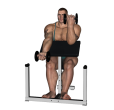 Preacher Curl - Dumbbell Single
Preacher Curl - Dumbbell Single
Benefits: This exercise isolates the biceps so that momentum does not come into play.
Purpose: This exercise strengthens the biceps.
Beginner Biceps Forearms Shoulders Traps Strength Dumbbell Preacher Bench Pull Gym
General Info: The biceps muscle is a straight muscle with 2 heads. The long head crosses both the elbow and shoulder joints and bends the elbow and raises the arm forward at the shoulder. The short head of the biceps crosses the elbow joint and, in conjunction with the brachioradialis, supinates the hand.
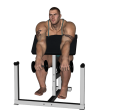 Preacher Curl - Dumbbell Zottman
Preacher Curl - Dumbbell Zottman
Benefits: This exercise isolates the biceps so that momentum does not come into play. The rotation used in this exercise works the forearms.
Purpose: This exercise strengthens the biceps.
Beginner Biceps Forearms Shoulders Traps Strength Dumbbell Preacher Bench Pull Gym
General Info: The biceps muscle is a straight muscle with 2 heads. The long head crosses both the elbow and shoulder joints and bends the elbow and raises the arm forward at the shoulder. The short head of the biceps crosses the elbow joint and, in conjunction with the brachioradialis, supinates the hand.
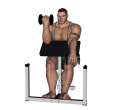 Preacher Curl - Dumbbell Zottman Alternate
Preacher Curl - Dumbbell Zottman Alternate
Benefits: This exercise isolates the biceps so that momentum does not come into play. The rotation used in this exercise works the forearms.
Purpose: This exercise strengthens the biceps.
Beginner Biceps Forearms Shoulders Traps Strength Dumbbell Preacher Bench Pull Gym
General Info: The biceps muscle is a straight muscle with 2 heads. The long head crosses both the elbow and shoulder joints and bends the elbow and raises the arm forward at the shoulder. The short head of the biceps crosses the elbow joint and, in conjunction with the brachioradialis, supinates the hand.
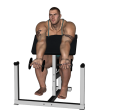 Preacher Curl - Dumbbell Zottman Reverse
Preacher Curl - Dumbbell Zottman Reverse
Benefits: This exercise isolates the biceps so that momentum does not come into play. The rotation used in this exercise works the forearms.
Purpose: This exercise strengthens the biceps.
Beginner Biceps Forearms Shoulders Traps Strength Dumbbell Preacher Bench Pull Gym
General Info: The biceps muscle is a straight muscle with 2 heads. The long head crosses both the elbow and shoulder joints and bends the elbow and raises the arm forward at the shoulder. The short head of the biceps crosses the elbow joint and, in conjunction with the brachioradialis, supinates the hand.
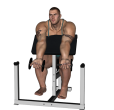 Preacher Curl - Dumbbell Zottman Reverse Alternate
Preacher Curl - Dumbbell Zottman Reverse Alternate
Benefits: This exercise isolates the biceps so that momentum does not come into play. The rotation used in this exercise works the forearms.
Purpose: This exercise strengthens the biceps.
Beginner Biceps Forearms Shoulders Traps Strength Dumbbell Preacher Bench Pull Gym
General Info: The biceps muscle is a straight muscle with 2 heads. The long head crosses both the elbow and shoulder joints and bends the elbow and raises the arm forward at the shoulder. The short head of the biceps crosses the elbow joint and, in conjunction with the brachioradialis, supinates the hand.
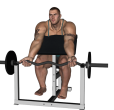 Preacher Curl - EZ Bar
Preacher Curl - EZ Bar
Benefits: This exercise isolates the biceps so that momentum does not come into play.
Purpose: This exercise strengthens the biceps.
Beginner Biceps Forearms Shoulders Traps Strength Barbell Preacher Bench Pull Gym
General Info: The biceps muscle is a straight muscle with 2 heads. The long head crosses both the elbow and shoulder joints and bends the elbow and raises the arm forward at the shoulder. The short head of the biceps crosses the elbow joint and, in conjunction with the brachioradialis, supinates the hand.
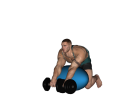 Preacher Curl - Fit Ball Dumbbell Reverse Single
Preacher Curl - Fit Ball Dumbbell Reverse Single
Benefits: This exercise isolates the biceps so that momentum does not come into play.
Purpose: This exercise strengthens the biceps.
Beginner Biceps Forearms Shoulders Traps Strength Dumbbell Fitness Ball Pull Gym
General Info: The biceps muscle is a straight muscle with 2 heads. The long head crosses both the elbow and shoulder joints and bends the elbow and raises the arm forward at the shoulder. The short head of the biceps crosses the elbow joint and, in conjunction with the brachioradialis, supinates the hand.
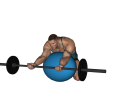 Preacher Curl - Fitness Ball Barbell
Preacher Curl - Fitness Ball Barbell
Benefits: This exercise isolates the biceps so that momentum does not come into play.
Purpose: This exercise strengthens the biceps.
Beginner Biceps Forearms Shoulders Traps Strength Barbell Fitness Ball Pull Gym
General Info: The biceps muscle is a straight muscle with 2 heads. The long head crosses both the elbow and shoulder joints and bends the elbow and raises the arm forward at the shoulder. The short head of the biceps crosses the elbow joint and, in conjunction with the brachioradialis, supinates the hand.
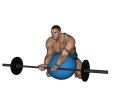 Preacher Curl - Fitness Ball Barbell Close Grip
Preacher Curl - Fitness Ball Barbell Close Grip
Benefits: This exercise isolates the biceps so that momentum does not come into play.
Purpose: This exercise strengthens the biceps.
Beginner Biceps Forearms Shoulders Traps Strength Barbell Fitness Ball Pull Gym
General Info: The biceps muscle is a straight muscle with 2 heads. The long head crosses both the elbow and shoulder joints and bends the elbow and raises the arm forward at the shoulder. The short head of the biceps crosses the elbow joint and, in conjunction with the brachioradialis, supinates the hand.
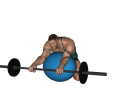 Preacher Curl - Fitness Ball Barbell Reverse
Preacher Curl - Fitness Ball Barbell Reverse
Benefits: This exercise isolates the biceps so that momentum does not come into play. The reverse grip makes the exercise more difficult.
Purpose: This exercise strengthens the biceps.
Beginner Biceps Forearms Shoulders Traps Strength Barbell Fitness Ball Pull Gym
General Info: The biceps muscle is a straight muscle with 2 heads. The long head crosses both the elbow and shoulder joints and bends the elbow and raises the arm forward at the shoulder. The short head of the biceps crosses the elbow joint and, in conjunction with the brachioradialis, supinates the hand.
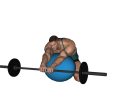 Preacher Curl - Fitness Ball Barbell Reverse Close
Preacher Curl - Fitness Ball Barbell Reverse Close
Benefits: This exercise isolates the biceps so that momentum does not come into play. The reverse grip makes the exercise more difficult.
Purpose: This exercise strengthens the biceps.
Beginner Biceps Forearms Shoulders Traps Strength Barbell Fitness Ball Pull Gym
General Info: The biceps muscle is a straight muscle with 2 heads. The long head crosses both the elbow and shoulder joints and bends the elbow and raises the arm forward at the shoulder. The short head of the biceps crosses the elbow joint and, in conjunction with the brachioradialis, supinates the hand.
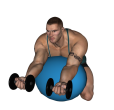 Preacher Curl - Fitness Ball Dumbbell
Preacher Curl - Fitness Ball Dumbbell
Benefits: This exercise isolates the biceps so that momentum does not come into play.
Purpose: This exercise strengthens the biceps.
Beginner Biceps Forearms Shoulders Traps Strength Dumbbell Fitness Ball Pull Gym
General Info: The biceps muscle is a straight muscle with 2 heads. The long head crosses both the elbow and shoulder joints and bends the elbow and raises the arm forward at the shoulder. The short head of the biceps crosses the elbow joint and, in conjunction with the brachioradialis, supinates the hand.
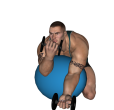 Preacher Curl - Fitness Ball Dumbbell Alternate
Preacher Curl - Fitness Ball Dumbbell Alternate
Benefits: This exercise isolates the biceps so that momentum does not come into play.
Purpose: This exercise strengthens the biceps.
Beginner Biceps Forearms Shoulders Traps Strength Dumbbell Fitness Ball Pull Gym
General Info: The biceps muscle is a straight muscle with 2 heads. The long head crosses both the elbow and shoulder joints and bends the elbow and raises the arm forward at the shoulder. The short head of the biceps crosses the elbow joint and, in conjunction with the brachioradialis, supinates the hand.
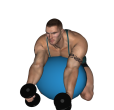 Preacher Curl - Fitness Ball Dumbbell Hammer
Preacher Curl - Fitness Ball Dumbbell Hammer
Benefits: This exercise isolates the biceps so that momentum does not come into play.
Purpose: This exercise strengthens the biceps.
Beginner Biceps Forearms Shoulders Traps Strength Dumbbell Fitness Ball Pull Gym
General Info: The biceps muscle is a straight muscle with 2 heads. The long head crosses both the elbow and shoulder joints and bends the elbow and raises the arm forward at the shoulder. The short head of the biceps crosses the elbow joint and, in conjunction with the brachioradialis, supinates the hand.
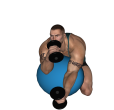 Preacher Curl - Fitness Ball Dumbbell Hammer Alternate
Preacher Curl - Fitness Ball Dumbbell Hammer Alternate
Benefits: This exercise isolates the biceps so that momentum does not come into play.
Purpose: This exercise strengthens the biceps.
Beginner Biceps Forearms Shoulders Traps Strength Dumbbell Fitness Ball Pull Gym
General Info: The biceps muscle is a straight muscle with 2 heads. The long head crosses both the elbow and shoulder joints and bends the elbow and raises the arm forward at the shoulder. The short head of the biceps crosses the elbow joint and, in conjunction with the brachioradialis, supinates the hand.
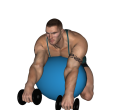 Preacher Curl - Fitness Ball Dumbbell Reverse
Preacher Curl - Fitness Ball Dumbbell Reverse
Benefits: This exercise isolates the biceps so that momentum does not come into play. The reverse grip makes the exercise more difficult.
Purpose: This exercise strengthens the biceps.
Beginner Biceps Forearms Shoulders Traps Strength Dumbbell Fitness Ball Pull Gym
General Info: The biceps muscle is a straight muscle with 2 heads. The long head crosses both the elbow and shoulder joints and bends the elbow and raises the arm forward at the shoulder. The short head of the biceps crosses the elbow joint and, in conjunction with the brachioradialis, supinates the hand.
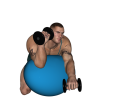 Preacher Curl - Fitness Ball Dumbbell Reverse Alternate
Preacher Curl - Fitness Ball Dumbbell Reverse Alternate
Benefits: This exercise isolates the biceps so that momentum does not come into play. The reverse grip makes the exercise more difficult.
Purpose: This exercise strengthens the biceps.
Beginner Biceps Forearms Shoulders Traps Strength Dumbbell Fitness Ball Pull Gym
General Info: The biceps muscle is a straight muscle with 2 heads. The long head crosses both the elbow and shoulder joints and bends the elbow and raises the arm forward at the shoulder. The short head of the biceps crosses the elbow joint and, in conjunction with the brachioradialis, supinates the hand.
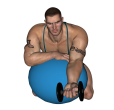 Preacher Curl - Fitness Ball Dumbbell Single
Preacher Curl - Fitness Ball Dumbbell Single
Benefits: This exercise isolates the biceps so that momentum does not come into play.
Purpose: This exercise strengthens the biceps.
Beginner Biceps Forearms Shoulders Traps Strength Dumbbell Fitness Ball Pull Gym
General Info: The biceps muscle is a straight muscle with 2 heads. The long head crosses both the elbow and shoulder joints and bends the elbow and raises the arm forward at the shoulder. The short head of the biceps crosses the elbow joint and, in conjunction with the brachioradialis, supinates the hand.
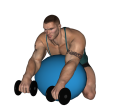 Preacher Curl - Fitness Ball Dumbbell Zottman
Preacher Curl - Fitness Ball Dumbbell Zottman
Benefits: This exercise isolates the biceps so that momentum does not come into play. The rotation used in this exercise works the forearms.
Purpose: This exercise strengthens the biceps.
Beginner Biceps Forearms Shoulders Traps Strength Dumbbell Fitness Ball Pull Gym
General Info: The biceps muscle is a straight muscle with 2 heads. The long head crosses both the elbow and shoulder joints and bends the elbow and raises the arm forward at the shoulder. The short head of the biceps crosses the elbow joint and, in conjunction with the brachioradialis, supinates the hand.
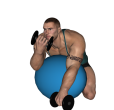 Preacher Curl - Fitness Ball Dumbbell Zottman Alternate
Preacher Curl - Fitness Ball Dumbbell Zottman Alternate
Benefits: This exercise isolates the biceps so that momentum does not come into play. The rotation used in this exercise works the forearms.
Purpose: This exercise strengthens the biceps.
Beginner Biceps Forearms Shoulders Traps Strength Dumbbell Fitness Ball Pull Gym
General Info: The biceps muscle is a straight muscle with 2 heads. The long head crosses both the elbow and shoulder joints and bends the elbow and raises the arm forward at the shoulder. The short head of the biceps crosses the elbow joint and, in conjunction with the brachioradialis, supinates the hand.
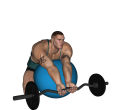 Preacher Curl - Fitness Ball EZ Bar
Preacher Curl - Fitness Ball EZ Bar
Benefits: This exercise isolates the biceps so that momentum does not come into play.
Purpose: This exercise strengthens the biceps.
Beginner Biceps Forearms Shoulders Traps Strength EZ Bar Fitness Ball Pull Gym
General Info: The biceps muscle is a straight muscle with 2 heads. The long head crosses both the elbow and shoulder joints and bends the elbow and raises the arm forward at the shoulder. The short head of the biceps crosses the elbow joint and, in conjunction with the brachioradialis, supinates the hand.
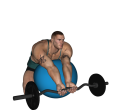 Preacher Curl - Fitness Ball EZ Bar Close Grip
Preacher Curl - Fitness Ball EZ Bar Close Grip
Benefits: This exercise isolates the biceps so that momentum does not come into play.
Purpose: This exercise strengthens the biceps.
Beginner Biceps Forearms Shoulders Traps Strength EZ Bar Fitness Ball Pull Gym
General Info: The biceps muscle is a straight muscle with 2 heads. The long head crosses both the elbow and shoulder joints and bends the elbow and raises the arm forward at the shoulder. The short head of the biceps crosses the elbow joint and, in conjunction with the brachioradialis, supinates the hand.
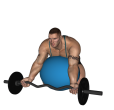 Preacher Curl - Fitness Ball EZ Bar Wide Grip
Preacher Curl - Fitness Ball EZ Bar Wide Grip
Benefits: This exercise isolates the biceps so that momentum does not come into play.
Purpose: This exercise strengthens the biceps.
Beginner Biceps Forearms Shoulders Traps Strength EZ Bar Fitness Ball Pull Gym
General Info: The biceps muscle is a straight muscle with 2 heads. The long head crosses both the elbow and shoulder joints and bends the elbow and raises the arm forward at the shoulder. The short head of the biceps crosses the elbow joint and, in conjunction with the brachioradialis, supinates the hand.
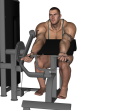 Preacher Curl - Machine
Preacher Curl - Machine
Benefits: This exercise isolates the biceps so that momentum does not come into play.
Purpose: This exercise strengthens the biceps.
Beginner Biceps Forearms Shoulders Traps Strength Preacher Curl Machine Pull Gym
General Info: The biceps muscle is a straight muscle with 2 heads. The long head crosses both the elbow and shoulder joints and bends the elbow and raises the arm forward at the shoulder. The short head of the biceps crosses the elbow joint and, in conjunction with the brachioradialis, supinates the hand.
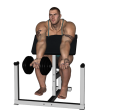 Preacher Curl - One Arm Dumbbell
Preacher Curl - One Arm Dumbbell
Benefits: This exercise isolates the biceps so that momentum does not come into play.
Purpose: This exercise strengthens the biceps.
Beginner Biceps Forearms Shoulders Traps Strength Dumbbell Preacher Bench Pull Gym
General Info: The biceps muscle is a straight muscle with 2 heads. The long head crosses both the elbow and shoulder joints and bends the elbow and raises the arm forward at the shoulder. The short head of the biceps crosses the elbow joint and, in conjunction with the brachioradialis, supinates the hand.
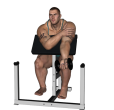 Preacher Curl - Single Dumbbell
Preacher Curl - Single Dumbbell
Benefits: This exercise isolates the biceps so that momentum does not come into play.
Purpose: This exercise strengthens the biceps.
Beginner Biceps Forearms Shoulders Traps Strength Dumbbell Preacher Bench Pull Gym
General Info: The biceps muscle is a straight muscle with 2 heads. The long head crosses both the elbow and shoulder joints and bends the elbow and raises the arm forward at the shoulder. The short head of the biceps crosses the elbow joint and, in conjunction with the brachioradialis, supinates the hand.
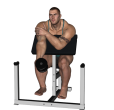 Preacher Curl - Single Dumbbell Hammer
Preacher Curl - Single Dumbbell Hammer
Benefits: This exercise isolates the biceps so that momentum does not come into play.
Purpose: This exercise strengthens the biceps.
Beginner Biceps Forearms Shoulders Traps Strength Dumbbell Preacher Bench Pull Gym
General Info: The biceps muscle is a straight muscle with 2 heads. The long head crosses both the elbow and shoulder joints and bends the elbow and raises the arm forward at the shoulder. The short head of the biceps crosses the elbow joint and, in conjunction with the brachioradialis, supinates the hand.
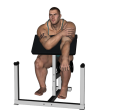 Preacher Curl - Single Dumbbell Zottman
Preacher Curl - Single Dumbbell Zottman
Benefits: This exercise isolates the biceps so that momentum does not come into play. The rotation used in this exercise works the forearms.
Purpose: This exercise strengthens the biceps.
Beginner Biceps Forearms Shoulders Traps Strength Dumbbell Preacher Bench Pull Gym
General Info: The biceps muscle is a straight muscle with 2 heads. The long head crosses both the elbow and shoulder joints and bends the elbow and raises the arm forward at the shoulder. The short head of the biceps crosses the elbow joint and, in conjunction with the brachioradialis, supinates the hand.
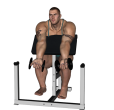 Preacher Curl - Two Arm Dumbbell
Preacher Curl - Two Arm Dumbbell
Benefits: This exercise isolates the biceps so that momentum does not come into play.
Purpose: This exercise strengthens the biceps.
Beginner Biceps Forearms Shoulders Traps Strength Dumbbell Preacher Bench Pull Gym
General Info: The biceps muscle is a straight muscle with 2 heads. The long head crosses both the elbow and shoulder joints and bends the elbow and raises the arm forward at the shoulder. The short head of the biceps crosses the elbow joint and, in conjunction with the brachioradialis, supinates the hand.
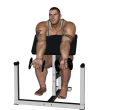 Preacher Curl - Zottman
Preacher Curl - Zottman
Benefits: This exercise isolates the biceps so that momentum does not come into play. the rotation used in this exercise works the forearms.
Purpose: This exercise strengthens the biceps.
Beginner Biceps Forearms Shoulders Traps Strength Dumbbell Preacher Bench Pull Gym
General Info: The biceps muscle is a straight muscle with 2 heads. The long head crosses both the elbow and shoulder joints and bends the elbow and raises the arm forward at the shoulder. The short head of the biceps crosses the elbow joint and, in conjunction with the brachioradialis, supinates the hand.
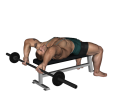 Pull Over - Bent Arm Barbell
Pull Over - Bent Arm Barbell
Benefits: This exercise is an alternative isolation exercise for the development of the lats. It also stretches the pecs.
Purpose: This exercise puts more emphasis on your lats.
Intermediate Lats Shoulders Chest Strength Barbell Flat Bench Pull Compound Gym
General Info: The lats is the larger, flat, dorso-lateral muscle on the trunk, posterior to the arm, and partly covered by the traps on its median dorsal region. It pulls the arm back and down towards the spine.
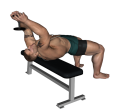 Pull Over - Bent Arm Dumbbell
Pull Over - Bent Arm Dumbbell
Benefits: This exercise is an alternative isolation exercise for the development of the lats. It also provides an excellent stretch of the pecs.
Purpose: This exercise puts more emphasis on your lats.
Intermediate Lats Shoulders Chest Strength Dumbbell Flat Bench Push Compound Gym
General Info: The lats is the larger, flat, dorso-lateral muscle on the trunk, posterior to the arm, and partly covered by the traps on its median dorsal region. It pulls the arm back and down towards the spine.
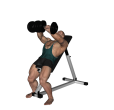 Pull Over - Incline Two Handed Dumbbell
Pull Over - Incline Two Handed Dumbbell
Benefits: This exercise is an alternative isolation exercise for the development of the lats.
Purpose: This exercise puts more emphasis on your lats.
Intermediate Lats Shoulders Chest Strength Dumbbell Incline Bench Push Compound Gym
General Info: The lats is the larger, flat, dorso-lateral muscle on the trunk, posterior to the arm, and partly covered by the traps on its median dorsal region. It pulls the arm back and down towards the spine.
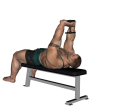 Pull Over - Straight Arm Dumbbell
Pull Over - Straight Arm Dumbbell
Benefits: This exercise is an alternative isolation exercise for the development of the lats. It also stretches the pecs.
Purpose: This exercise puts more emphasis on your lats.
Intermediate Lats Shoulders Chest Strength Dumbbell Flat Bench Push Compound Gym
General Info: The lats is the larger, flat, dorso-lateral muscle on the trunk, posterior to the arm, and partly covered by the traps on its median dorsal region. It pulls the arm back and down towards the spine.
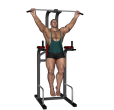 Pull Up - Rocky Pull Down
Pull Up - Rocky Pull Down
Benefits: This exercise is a strong, effective free weight back exercise for building width of the lats and middle back.
Purpose: This is a good exercise for increasing the width in the upper back. It also involves the biceps and some traps.
Beginner Lats Biceps Traps Shoulders Strength Chinning Bar Pull Compound Gym
General Info: There are a number of muscles in the back, although the two major muscles are the lats and traps. The lats pulls the arm back and down towards the spine. The traps pull the shoulder blades back and towards the spine.
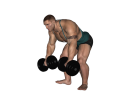 Reverse Curl - Bent Over Dumbbell
Reverse Curl - Bent Over Dumbbell
Benefits: This exercise is similar in effect to the Spider curl and does a good job of placing maximum tension on the biceps in the fully contracted position.
Purpose: This exercise works the biceps muscles but focuses also on the brachioradialis (a muscle that crosses the elbow joint and assists in rotating the forearm).
Beginner Biceps Forearms Shoulders Strength Dumbbell Pull Gym
General Info: The biceps is a straight muscle which has two heads. The long head crosses both the elbow and the shoulder joints. It bends the arm at the elbow and raises the arm forward at the shoulder. The short head crosses the elbow joint and, in conjunction with the brachioradialis, supinates the hand.
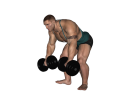 Reverse Curl - Bent Over Dumbbell Alternate
Reverse Curl - Bent Over Dumbbell Alternate
Benefits: This exercise is similar in effect to the Spider curl and does a good job of placing maximum tension on the biceps in the fully contracted position.
Purpose: This exercise works the biceps muscles but focuses also on the brachioradialis (a muscle that crosses the elbow joint and assists in rotating the forearm).
Beginner Biceps Forearms Shoulders Strength Dumbbell Pull Gym
General Info: The biceps is a straight muscle which has two heads. The long head crosses both the elbow and the shoulder joints. It bends the arm at the elbow and raises the arm forward at the shoulder. The short head crosses the elbow joint and, in conjunction with the brachioradialis, supinates the hand.
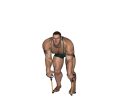 Reverse Curl - Bent Over Resistance Tube
Reverse Curl - Bent Over Resistance Tube
Benefits: This exercise is similar in effect to the Spider curl and does a good job of placing maximum tension on the biceps in the fully contracted position.
Purpose: This exercise works the biceps muscles but focuses also on the brachioradialis (a muscle that crosses the elbow joint and assists in rotating the forearm).
Beginner Biceps Forearms Shoulders Strength Resistance Tube Pull Gym
General Info: The biceps is a straight muscle which has two heads. The long head crosses both the elbow and the shoulder joints. It bends the arm at the elbow and raises the arm forward at the shoulder. The short head crosses the elbow joint and, in conjunction with the brachioradialis, supinates the hand.
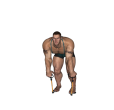 Reverse Curl - Bent Over Resistance Tube Alternate
Reverse Curl - Bent Over Resistance Tube Alternate
Benefits: This exercise is similar in effect to the Spider curl and does a good job of placing maximum tension on the biceps in the fully contracted position.
Purpose: This exercise works the biceps muscles but focuses also on the brachioradialis (a muscle that crosses the elbow joint and assists in rotating the forearm).
Beginner Biceps Forearms Shoulders Strength Resistance Tube Pull Gym
General Info: The biceps is a straight muscle which has two heads. The long head crosses both the elbow and the shoulder joints. It bends the arm at the elbow and raises the arm forward at the shoulder. The short head crosses the elbow joint and, in conjunction with the brachioradialis, supinates the hand.
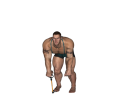 Reverse Curl - Bent Over Resistance Tube Single
Reverse Curl - Bent Over Resistance Tube Single
Benefits: This exercise is similar in effect to the Spider curl and does a good job of placing maximum tension on the biceps in the fully contracted position.
Purpose: This exercise works the biceps muscles but focuses also on the brachioradialis (a muscle that crosses the elbow joint and assists in rotating the forearm).
Beginner Biceps Forearms Shoulders Strength Resistance Tube Pull Gym
General Info: The biceps is a straight muscle which has two heads. The long head crosses both the elbow and the shoulder joints. It bends the arm at the elbow and raises the arm forward at the shoulder. The short head crosses the elbow joint and, in conjunction with the brachioradialis, supinates the hand.
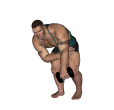 Reverse Curl - Bent Over Single Dumbbell
Reverse Curl - Bent Over Single Dumbbell
Benefits: This exercise is similar in effect to the Spider curl and does a good job of placing maximum tension on the biceps in the fully contracted position.
Purpose: This exercise works the biceps muscles but focuses also on the brachioradialis (a muscle that crosses the elbow joint and assists in rotating the forearm).
Beginner Biceps Forearms Shoulders Strength Dumbbell Pull Gym
General Info: The biceps is a straight muscle which has two heads. The long head crosses both the elbow and the shoulder joints. It bends the arm at the elbow and raises the arm forward at the shoulder. The short head crosses the elbow joint and, in conjunction with the brachioradialis, supinates the hand.
 Reverse Curl - Bent Over Single Water Bottle
Reverse Curl - Bent Over Single Water Bottle
Benefits: This exercise is similar in effect to the Spider curl and does a good job of placing maximum tension on the biceps in the fully contracted position.
Purpose: This exercise works the biceps muscles but focuses also on the brachioradialis (a muscle that crosses the elbow joint and assists in rotating the forearm).
Beginner Biceps Forearms Shoulders Strength Water Bottle Pull Home
General Info: The biceps is a straight muscle which has two heads. The long head crosses both the elbow and the shoulder joints. It bends the arm at the elbow and raises the arm forward at the shoulder. The short head crosses the elbow joint and, in conjunction with the brachioradialis, supinates the hand.
 Reverse Curl - Bent Over Water Bottle
Reverse Curl - Bent Over Water Bottle
Benefits: This exercise is similar in effect to the Spider curl and does a good job of placing maximum tension on the biceps in the fully contracted position.
Purpose: This exercise works the biceps muscles but focuses also on the brachioradialis (a muscle that crosses the elbow joint and assists in rotating the forearm).
Beginner Biceps Forearms Shoulders Strength Water Bottle Pull Home
General Info: The biceps is a straight muscle which has two heads. The long head crosses both the elbow and the shoulder joints. It bends the arm at the elbow and raises the arm forward at the shoulder. The short head crosses the elbow joint and, in conjunction with the brachioradialis, supinates the hand.
 Reverse Curl - Bent Over Water Bottle Alternate
Reverse Curl - Bent Over Water Bottle Alternate
Benefits: This exercise is similar in effect to the Spider curl and does a good job of placing maximum tension on the biceps in the fully contracted position.
Purpose: This exercise works the biceps muscles but focuses also on the brachioradialis (a muscle that crosses the elbow joint and assists in rotating the forearm).
Beginner Biceps Forearms Shoulders Strength Water Bottle Pull Home
General Info: The biceps is a straight muscle which has two heads. The long head crosses both the elbow and the shoulder joints. It bends the arm at the elbow and raises the arm forward at the shoulder. The short head crosses the elbow joint and, in conjunction with the brachioradialis, supinates the hand.
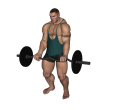 Reverse Curl - EZ Bar
Reverse Curl - EZ Bar
Benefits: This exercise puts the forearms in a stronger position, allowing you to lift heavier weights.
Purpose: This exercise is used to target the biceps muscle to develop size, definition, strength, endurance and power.
Beginner Biceps Forearms Shoulders Strength EZ Bar Pull Gym
General Info: The biceps is a straight muscle with two heads. The long head of the biceps crosses both the elbow and the shoulder joint. It bends the elbow and raises the arm forward at the shoulder. The short head crosses the elbow joint and, in conjunction with the brachioradialis, supinates the hand.
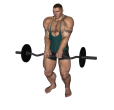 Reverse Curl - EZ Bar Close Grip
Reverse Curl - EZ Bar Close Grip
Benefits: This exercise puts the forearms in a stronger position, allowing you to lift heavier weights.
Purpose: This exercise is used to target the biceps muscle to develop size, definition, strength, endurance and power.
Beginner Biceps Forearms Shoulders Strength EZ Bar Pull Gym
General Info: The biceps is a straight muscle with two heads. The long head of the biceps crosses both the elbow and the shoulder joint. It bends the elbow and raises the arm forward at the shoulder. The short head crosses the elbow joint and, in conjunction with the brachioradialis, supinates the hand.
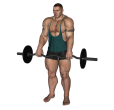 Reverse Curl - EZ Bar Narrow Stance
Reverse Curl - EZ Bar Narrow Stance
Benefits: This exercise puts the forearms in a stronger position, allowing you to lift heavier weights.
Purpose: This exercise is used to target the biceps muscle to develop size, definition, strength, endurance and power.
Beginner Biceps Forearms Shoulders Strength EZ Bar Pull Gym
General Info: The biceps is a straight muscle with two heads. The long head of the biceps crosses both the elbow and the shoulder joint. It bends the elbow and raises the arm forward at the shoulder. The short head crosses the elbow joint and, in conjunction with the brachioradialis, supinates the hand.
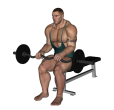 Reverse Curl - EZ Bar Seated
Reverse Curl - EZ Bar Seated
Benefits: This exercise puts the forearms in a stronger position, allowing you to lift heavier weights.
Purpose: This exercise is used to target the biceps muscle to develop size, definition, strength, endurance and power.
Beginner Biceps Forearms Shoulders Strength EZ Bar Flat Bench Pull Gym
General Info: The biceps is a straight muscle with two heads. The long head of the biceps crosses both the elbow and the shoulder joint. It bends the elbow and raises the arm forward at the shoulder. The short head crosses the elbow joint and, in conjunction with the brachioradialis, supinates the hand.
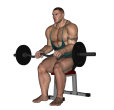 Reverse Curl - EZ Bar Seated Feet Up
Reverse Curl - EZ Bar Seated Feet Up
Benefits: This exercise puts the forearms in a stronger position, allowing you to lift heavier weights.
Purpose: This exercise is used to target the biceps muscle to develop size, definition, strength, endurance and power.
Beginner Biceps Forearms Shoulders Strength EZ Bar Flat Bench Pull Gym
General Info: The biceps is a straight muscle with two heads. The long head of the biceps crosses both the elbow and the shoulder joint. It bends the elbow and raises the arm forward at the shoulder. The short head crosses the elbow joint and, in conjunction with the brachioradialis, supinates the hand.
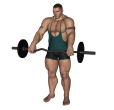 Reverse Curl - EZ Bar Wide Grip Narrow Stance
Reverse Curl - EZ Bar Wide Grip Narrow Stance
Benefits: This exercise puts the forearms in a stronger position, allowing you to lift heavier weights.
Purpose: This exercise is used to target the biceps muscle to develop size, definition, strength, endurance and power.
Beginner Biceps Forearms Shoulders Strength EZ Bar Pull Gym
General Info: The biceps is a straight muscle with two heads. The long head of the biceps crosses both the elbow and the shoulder joint. It bends the elbow and raises the arm forward at the shoulder. The short head crosses the elbow joint and, in conjunction with the brachioradialis, supinates the hand.
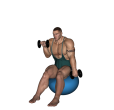 Reverse Curl - Fitness Ball Dumbbell Alternate
Reverse Curl - Fitness Ball Dumbbell Alternate
Benefits: Reverse curls work the forearms more than regular bicep curls.
Purpose: This exercise increases strength and produces greater functional strength in both the biceps and the forearms.
Beginner Biceps Forearms Shoulders Strength Dumbbell Fitness Ball Pull Gym
General Info: The biceps is a straight muscle with two heads. The long head of the biceps crosses both the elbow and the shoulder joint. It bends the elbow and raises the arm forward at the shoulder. The short head crosses the elbow joint and, in conjunction with the brachioradialis, supinates the hand.
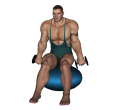 Reverse Curl - Fitness Ball Single Dumbbell
Reverse Curl - Fitness Ball Single Dumbbell
Benefits: Reverse curls work the forearms more than regular bicep curls.
Purpose: This exercise increases strength and produces greater functional strength in both the biceps and the forearms.
Beginner Biceps Forearms Shoulders Strength Dumbbell Fitness Ball Pull Gym
General Info: The biceps is a straight muscle with two heads. The long head of the biceps crosses both the elbow and the shoulder joint. It bends the elbow and raises the arm forward at the shoulder. The short head crosses the elbow joint and, in conjunction with the brachioradialis, supinates the hand.
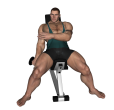 Reverse Curl - Incline Single Dumbbell
Reverse Curl - Incline Single Dumbbell
Benefits: Reverse curls work the forearms more than regular bicep curls.
Purpose: This exercise increases strength and produces greater functional strength in both the biceps and the forearms.
Beginner Biceps Forearms Shoulders Strength Dumbbell Incline Bench Pull Gym
General Info: The biceps is a straight muscle with two heads. The long head of the biceps crosses both the elbow and the shoulder joint. It bends the elbow and raises the arm forward at the shoulder. The short head crosses the elbow joint and, in conjunction with the brachioradialis, supinates the hand.
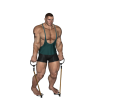 Reverse Curl - Resistance Tube
Reverse Curl - Resistance Tube
Benefits: This exercise places great relative intensity on the biceps muscle and is a basic bicep exercise.
Purpose: This exercise focuses on the biceps but also involves the brachioradialis.
Beginner Biceps Forearms Shoulders Strength Resistance Tube Pull Gym
General Info: The biceps is a straight muscle with two heads. The long head of the biceps crosses both the elbow and the shoulder joints. It bends the elbow and raises the arm forward at the shoulder. The short head crosses the elbow joint and, in conjunction with the brachioradialis muscle, supinates the hand.
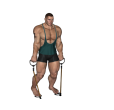 Reverse Curl - Resistance Tube Alternate
Reverse Curl - Resistance Tube Alternate
Benefits: This exercise places great relative intensity on the biceps muscle and is a basic bicep exercise.
Purpose: This exercise focuses on the biceps but also involves the brachioradialis.
Beginner Biceps Forearms Shoulders Strength Resistance Tube Pull Gym
General Info: The biceps is a straight muscle with two heads. The long head of the biceps crosses both the elbow and the shoulder joints. It bends the elbow and raises the arm forward at the shoulder. The short head crosses the elbow joint and, in conjunction with the brachioradialis muscle, supinates the hand.
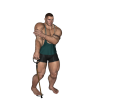 Reverse Curl - Resistance Tube Single
Reverse Curl - Resistance Tube Single
Benefits: This exercise isolates the biceps so that momentum does not come into play.
Purpose: This exercise strengthens the biceps.
Beginner Biceps Forearms Shoulders Strength Resistance Tube Pull Gym
General Info: The biceps is a straight muscle with two heads. The long head of the biceps crosses both the elbow and the shoulder joint. It bends the elbow and raises the arm forward at the shoulder. The short head crosses the elbow joint and, in conjunction with the brachioradialis, supinates the hand.
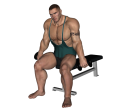 Reverse Curl - Seated Dumbbell
Reverse Curl - Seated Dumbbell
Benefits: This exercise isolates the biceps so that momentum does not come into play.
Purpose: This exercise strengthens the biceps.
Beginner Biceps Forearms Shoulders Traps Strength Dumbbell Flat Bench Pull Gym
General Info: The biceps muscle is a straight muscle with 2 heads. The long head crosses both the elbow and shoulder joints and bends the elbow and raises the arm forward at the shoulder. The short head of the biceps crosses the elbow joint and, in conjunction with the brachioradialis, supinates the hand..
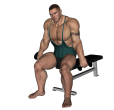 Reverse Curl - Seated Dumbbell Alternate
Reverse Curl - Seated Dumbbell Alternate
Benefits: This exercise isolates the biceps so that momentum does not come into play.
Purpose: This exercise strengthens the biceps.
Beginner Biceps Forearms Shoulders Traps Strength Dumbbell Flat Bench Pull Gym
General Info: The biceps muscle is a straight muscle with 2 heads. The long head crosses both the elbow and shoulder joints and bends the elbow and raises the arm forward at the shoulder. The short head of the biceps crosses the elbow joint and, in conjunction with the brachioradialis, supinates the hand..
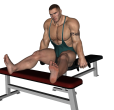 Reverse Curl - Seated Dumbbell Feet Up
Reverse Curl - Seated Dumbbell Feet Up
Benefits: This exercise isolates the biceps so that momentum does not come into play. It also works the forearms.
Purpose: This exercise strengthens the biceps.
Beginner Biceps Forearms Shoulders Traps Strength Dumbbell Flat Bench Pull Gym
General Info: The biceps muscle is a straight muscle with 2 heads. The long head crosses both the elbow and shoulder joints and bends the elbow and raises the arm forward at the shoulder. The short head of the biceps crosses the elbow joint and, in conjunction with the brachioradialis, supinates the hand..
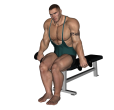 Reverse Curl - Seated Dumbbell Narrow Alternate
Reverse Curl - Seated Dumbbell Narrow Alternate
Benefits: This exercise isolates the biceps so that momentum does not come into play. It also works the forearms.
Purpose: This exercise strengthens the biceps.
Beginner Biceps Forearms Shoulders Traps Strength Dumbbell Flat Bench Pull Gym
General Info: The biceps muscle is a straight muscle with 2 heads. The long head crosses both the elbow and shoulder joints and bends the elbow and raises the arm forward at the shoulder. The short head of the biceps crosses the elbow joint and, in conjunction with the brachioradialis, supinates the hand..
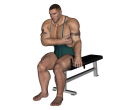 Reverse Curl - Seated Dumbbell Single
Reverse Curl - Seated Dumbbell Single
Benefits: This exercise isolates the biceps so that momentum does not come into play. It also works the forearms.
Purpose: This exercise strengthens the biceps.
Beginner Biceps Forearms Shoulders Traps Strength Dumbbell Flat Bench Pull Gym
General Info: The biceps muscle is a straight muscle with 2 heads. The long head crosses both the elbow and shoulder joints and bends the elbow and raises the arm forward at the shoulder. The short head of the biceps crosses the elbow joint and, in conjunction with the brachioradialis, supinates the hand..
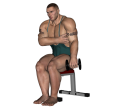 Reverse Curl - Seated Dumbbell Single Narrow
Reverse Curl - Seated Dumbbell Single Narrow
Benefits: This exercise isolates the biceps so that momentum does not come into play. It also works the forearms.
Purpose: This exercise strengthens the biceps.
Beginner Biceps Forearms Shoulders Traps Strength Dumbbell Flat Bench Pull Gym
General Info: The biceps muscle is a straight muscle with 2 heads. The long head crosses both the elbow and shoulder joints and bends the elbow and raises the arm forward at the shoulder. The short head of the biceps crosses the elbow joint and, in conjunction with the brachioradialis, supinates the hand..
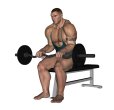 Reverse Curl - Seated EZ Bar
Reverse Curl - Seated EZ Bar
Benefits: This exercise isolates the biceps so that momentum does not come into play. It also works the forearms.
Purpose: This exercise strengthens the biceps.
Beginner Biceps Forearms Shoulders Traps Strength EZ Bar Flat Bench Pull Gym
General Info: The biceps muscle is a straight muscle with 2 heads. The long head crosses both the elbow and shoulder joints and bends the elbow and raises the arm forward at the shoulder. The short head of the biceps crosses the elbow joint and, in conjunction with the brachioradialis, supinates the hand..
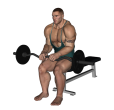 Reverse Curl - Seated EZ Bar Close Grip
Reverse Curl - Seated EZ Bar Close Grip
Benefits: This exercise isolates the biceps so that momentum does not come into play. It also works the forearms.
Purpose: This exercise strengthens the biceps.
Beginner Biceps Forearms Shoulders Traps Strength EZ Bar Flat Bench Pull Gym
General Info: The biceps muscle is a straight muscle with 2 heads. The long head crosses both the elbow and shoulder joints and bends the elbow and raises the arm forward at the shoulder. The short head of the biceps crosses the elbow joint and, in conjunction with the brachioradialis, supinates the hand..
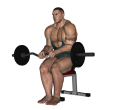 Reverse Curl - Seated EZ Bar Close Narrow
Reverse Curl - Seated EZ Bar Close Narrow
Benefits: This exercise isolates the biceps so that momentum does not come into play. It also works the forearms.
Purpose: This exercise strengthens the biceps.
Beginner Biceps Forearms Shoulders Traps Strength EZ Bar Flat Bench Pull Gym
General Info: The biceps muscle is a straight muscle with 2 heads. The long head crosses both the elbow and shoulder joints and bends the elbow and raises the arm forward at the shoulder. The short head of the biceps crosses the elbow joint and, in conjunction with the brachioradialis, supinates the hand..
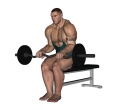 Reverse Curl - Seated EZ Bar Narrow
Reverse Curl - Seated EZ Bar Narrow
Benefits: This exercise isolates the biceps so that momentum does not come into play. It also works the forearms.
Purpose: This exercise strengthens the biceps.
Beginner Biceps Forearms Shoulders Traps Strength EZ Bar Flat Bench Pull Gym
General Info: The biceps muscle is a straight muscle with 2 heads. The long head crosses both the elbow and shoulder joints and bends the elbow and raises the arm forward at the shoulder. The short head of the biceps crosses the elbow joint and, in conjunction with the brachioradialis, supinates the hand..
 Reverse Curl - Seated Water Bottle
Reverse Curl - Seated Water Bottle
Benefits: This exercise isolates the biceps so that momentum does not come into play.
Purpose: This exercise strengthens the biceps.
Beginner Biceps Forearms Shoulders Traps Strength Water Bottle Chair Pull Home
General Info: The biceps muscle is a straight muscle with 2 heads. The long head crosses both the elbow and shoulder joints and bends the elbow and raises the arm forward at the shoulder. The short head of the biceps crosses the elbow joint and, in conjunction with the brachioradialis, supinates the hand..
 Reverse Curl - Seated Water Bottle Alternate
Reverse Curl - Seated Water Bottle Alternate
Benefits: This exercise isolates the biceps so that momentum does not come into play.
Purpose: This exercise strengthens the biceps.
Beginner Biceps Forearms Shoulders Traps Strength Water Bottle Chair Pull Home
General Info: The biceps muscle is a straight muscle with 2 heads. The long head crosses both the elbow and shoulder joints and bends the elbow and raises the arm forward at the shoulder. The short head of the biceps crosses the elbow joint and, in conjunction with the brachioradialis, supinates the hand..
 Reverse Curl - Seated Water Bottle Feet Up
Reverse Curl - Seated Water Bottle Feet Up
Benefits: This exercise isolates the biceps so that momentum does not come into play.
Purpose: This exercise strengthens the biceps.
Beginner Biceps Forearms Shoulders Traps Strength Water Bottle Chair Pull Home
General Info: The biceps muscle is a straight muscle with 2 heads. The long head crosses both the elbow and shoulder joints and bends the elbow and raises the arm forward at the shoulder. The short head of the biceps crosses the elbow joint and, in conjunction with the brachioradialis, supinates the hand..
 Reverse Curl - Seated Water Bottle Narrow Alternate
Reverse Curl - Seated Water Bottle Narrow Alternate
Benefits: This exercise isolates the biceps so that momentum does not come into play.
Purpose: This exercise strengthens the biceps.
Beginner Biceps Forearms Shoulders Traps Strength Water Bottle Chair Pull Home
General Info: The biceps muscle is a straight muscle with 2 heads. The long head crosses both the elbow and shoulder joints and bends the elbow and raises the arm forward at the shoulder. The short head of the biceps crosses the elbow joint and, in conjunction with the brachioradialis, supinates the hand..
 Reverse Curl - Seated Water Bottle Single
Reverse Curl - Seated Water Bottle Single
Benefits: This exercise isolates the biceps so that momentum does not come into play.
Purpose: This exercise strengthens the biceps.
Beginner Biceps Forearms Shoulders Traps Strength Water Bottle Chair Pull Home
General Info: The biceps muscle is a straight muscle with 2 heads. The long head crosses both the elbow and shoulder joints and bends the elbow and raises the arm forward at the shoulder. The short head of the biceps crosses the elbow joint and, in conjunction with the brachioradialis, supinates the hand..
 Reverse Curl - Seated Water Bottle Single Narrow
Reverse Curl - Seated Water Bottle Single Narrow
Benefits: This exercise isolates the biceps so that momentum does not come into play.
Purpose: This exercise strengthens the biceps.
Beginner Biceps Forearms Shoulders Traps Strength Water Bottle Chair Pull Home
General Info: The biceps muscle is a straight muscle with 2 heads. The long head crosses both the elbow and shoulder joints and bends the elbow and raises the arm forward at the shoulder. The short head of the biceps crosses the elbow joint and, in conjunction with the brachioradialis, supinates the hand..
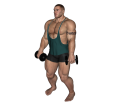 Reverse Curl - Standing Dumbbell Alternate
Reverse Curl - Standing Dumbbell Alternate
Benefits: This exercise works both heads of the biceps with a heavier weight than can typically be done with dumbbells.
Purpose: This exercise is used to target the biceps muscle to develop size, definition, strength, endurance and power.
Beginner Biceps Forearms Shoulders Strength Dumbbell Pull Gym
General Info: The biceps is a straight muscle with two heads. The long head of the biceps crosses both the elbow and the shoulder joint. It bends the elbow and raises the arm forward at the shoulder. The short head crosses the elbow joint and, in conjunction with the brachioradialis, supinates the hand.
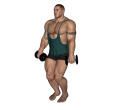 Reverse Curl - Standing Dumbbell Narrow Stance
Reverse Curl - Standing Dumbbell Narrow Stance
Benefits: This exercise works both heads of the biceps. It also works the forearms.
Purpose: This exercise is used to target the biceps muscle to develop size, definition, strength, endurance and power.
Beginner Biceps Forearms Shoulders Strength Dumbbell Pull Gym
General Info: The biceps is a straight muscle with two heads. The long head of the biceps crosses both the elbow and the shoulder joint. It bends the elbow and raises the arm forward at the shoulder. The short head crosses the elbow joint and, in conjunction with the brachioradialis, supinates the hand.
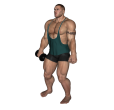 Reverse Curl - Standing Dumbbell Single
Reverse Curl - Standing Dumbbell Single
Benefits: This exercise isolates the biceps so that momentum does not come into play. It also works the forearms.
Purpose: This exercise strengthens the biceps.
Beginner Biceps Forearms Shoulders Traps Strength Dumbbell Pull Gym
General Info: The biceps muscle is a straight muscle with 2 heads. The long head crosses both the elbow and shoulder joints and bends the elbow and raises the arm forward at the shoulder. The short head of the biceps crosses the elbow joint and, in conjunction with the brachioradialis, supinates the hand..
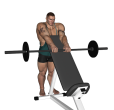 Reverse Curl - Standing Incline Barbell
Reverse Curl - Standing Incline Barbell
Benefits: This exercise works both heads of the biceps with a heavier weight than can typically be done with dumbbells. It is very similar to a preacher curl. It also works the forearms.
Purpose: This exercise is used to target the biceps muscle to develop size, definition, strength, endurance and power.
Beginner Biceps Forearms Shoulders Strength Barbell Incline Bench Pull Gym
General Info: The biceps is a straight muscle with two heads. The long head of the biceps crosses both the elbow and the shoulder joint. It bends the elbow and raises the arm forward at the shoulder. The short head crosses the elbow joint and, in conjunction with the brachioradialis, supinates the hand.
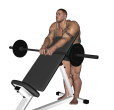 Reverse Curl - Standing Incline Barbell Close
Reverse Curl - Standing Incline Barbell Close
Benefits: This exercise works both heads of the biceps with a heavier weight than can typically be done with dumbbells. It is very similar to a preacher curl. It also works the forearms.
Purpose: This exercise is used to target the biceps muscle to develop size, definition, strength, endurance and power.
Beginner Biceps Forearms Shoulders Strength Barbell Incline Bench Pull Gym
General Info: The biceps is a straight muscle with two heads. The long head of the biceps crosses both the elbow and the shoulder joint. It bends the elbow and raises the arm forward at the shoulder. The short head crosses the elbow joint and, in conjunction with the brachioradialis, supinates the hand.
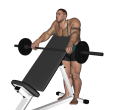 Reverse Curl - Standing Incline Barbell Wide Grip
Reverse Curl - Standing Incline Barbell Wide Grip
Benefits: This exercise works both heads of the biceps with a heavier weight than can typically be done with dumbbells. It is very similar to a preacher curl. It also works the forearms.
Purpose: This exercise is used to target the biceps muscle to develop size, definition, strength, endurance and power.
Beginner Biceps Forearms Shoulders Strength Barbell Incline Bench Pull Gym
General Info: The biceps is a straight muscle with two heads. The long head of the biceps crosses both the elbow and the shoulder joint. It bends the elbow and raises the arm forward at the shoulder. The short head crosses the elbow joint and, in conjunction with the brachioradialis, supinates the hand.
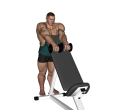 Reverse Curl - Standing Incline Dumbbell
Reverse Curl - Standing Incline Dumbbell
Benefits: This exercise works both heads of the biceps. It is very similar to a preacher curl. It also works the forearms.
Purpose: This exercise is used to target the biceps muscle to develop size, definition, strength, endurance and power.
Beginner Biceps Forearms Shoulders Strength Dumbbell Incline Bench Pull Gym
General Info: The biceps is a straight muscle with two heads. The long head of the biceps crosses both the elbow and the shoulder joint. It bends the elbow and raises the arm forward at the shoulder. The short head crosses the elbow joint and, in conjunction with the brachioradialis, supinates the hand.
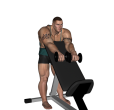 Reverse Curl - Standing Incline Dumbbell Alternate
Reverse Curl - Standing Incline Dumbbell Alternate
Benefits: This exercise works both heads of the biceps. It is very similar to a preacher curl. It also works the forearms.
Purpose: This exercise is used to target the biceps muscle to develop size, definition, strength, endurance and power.
Beginner Biceps Forearms Shoulders Strength Dumbbell Incline Bench Pull Gym
General Info: The biceps is a straight muscle with two heads. The long head of the biceps crosses both the elbow and the shoulder joint. It bends the elbow and raises the arm forward at the shoulder. The short head crosses the elbow joint and, in conjunction with the brachioradialis, supinates the hand.
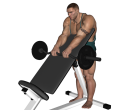 Reverse Curl - Standing Incline EZ Bar
Reverse Curl - Standing Incline EZ Bar
Benefits: This exercise works both heads of the biceps with a heavier weight than can typically be done with dumbbells.
Purpose: This exercise is used to target the biceps muscle to develop size, definition, strength, endurance and power.
Beginner Biceps Forearms Shoulders Strength EZ Bar Incline Bench Pull Gym
General Info: The biceps is a straight muscle with two heads. The long head of the biceps crosses both the elbow and the shoulder joint. It bends the elbow and raises the arm forward at the shoulder. The short head crosses the elbow joint and, in conjunction with the brachioradialis, supinates the hand.
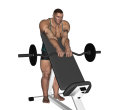 Reverse Curl - Standing Incline EZ Bar Close Grip
Reverse Curl - Standing Incline EZ Bar Close Grip
Benefits: This exercise works both heads of the biceps with a heavier weight than can typically be done with dumbbells. It is very similar to a preacher curl. It also works the forearms.
Purpose: This exercise is used to target the biceps muscle to develop size, definition, strength, endurance and power.
Beginner Biceps Forearms Shoulders Strength EZ Bar Incline Bench Pull Gym
General Info: The biceps is a straight muscle with two heads. The long head of the biceps crosses both the elbow and the shoulder joint. It bends the elbow and raises the arm forward at the shoulder. The short head crosses the elbow joint and, in conjunction with the brachioradialis, supinates the hand.
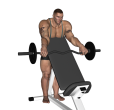 Reverse Curl - Standing Incline EZ Bar Wide Grip
Reverse Curl - Standing Incline EZ Bar Wide Grip
Benefits: This exercise works both heads of the biceps with a heavier weight than can typically be done with dumbbells. It is very similar to a preacher curl. It also works the forearms.
Purpose: This exercise is used to target the biceps muscle to develop size, definition, strength, endurance and power.
Beginner Biceps Forearms Shoulders Strength EZ Bar Incline Bench Pull Gym
General Info: The biceps is a straight muscle with two heads. The long head of the biceps crosses both the elbow and the shoulder joint. It bends the elbow and raises the arm forward at the shoulder. The short head crosses the elbow joint and, in conjunction with the brachioradialis, supinates the hand.
 Reverse Curl - Standing Water Bottle Alternate
Reverse Curl - Standing Water Bottle Alternate
Benefits: This exercise isolates the biceps so that momentum does not come into play.
Purpose: This exercise strengthens the biceps.
Beginner Biceps Forearms Shoulders Traps Strength Water Bottle Pull Home
General Info: The biceps muscle is a straight muscle with 2 heads. The long head crosses both the elbow and shoulder joints and bends the elbow and raises the arm forward at the shoulder. The short head of the biceps crosses the elbow joint and, in conjunction with the brachioradialis, supinates the hand..
 Reverse Curl - Standing Water Bottle Single
Reverse Curl - Standing Water Bottle Single
Benefits: This exercise isolates the biceps so that momentum does not come into play.
Purpose: This exercise strengthens the biceps.
Beginner Biceps Forearms Shoulders Traps Strength Water Bottle Chair Pull Home
General Info: The biceps muscle is a straight muscle with 2 heads. The long head crosses both the elbow and shoulder joints and bends the elbow and raises the arm forward at the shoulder. The short head of the biceps crosses the elbow joint and, in conjunction with the brachioradialis, supinates the hand..
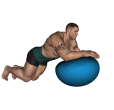 Roll Out - Fitness Ball
Roll Out - Fitness Ball
Benefits: This exercise will give you a well-defined mid-section.
Purpose: This exercise strengthens the abdominal muscles.
Intermediate Abdominals Shoulders Strength Fitness Ball Pull Compound Gym
General Info: The abs can be divided into the abdominals themselves and the obliques. The obliques are the outer abs and are used in twisting movements. For the sake of exercising, the abdominals are sometimes divided into upper abs and lower abs (this is not a technical division but something for exercising). Both upper and lower abs are used in straight line ab exercises while the upper abs are also involved in twisting movements.
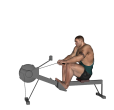 Row - Stationary
Row - Stationary
Benefits: Stationary rowing is an excellent overall exercise.
Purpose: This exercise improves cardio fitness.
Intermediate Quads Back Biceps Shoulders Cardio Rowing Machine Gym
General Info: Research has shown that people who spend long periods of time jogging, on treadmills, jumping rope, or stationary bikes, at a relative constant rate of speed, actually lose heart size and fitness. In addition, the body stores more fat to ensure that it can meet the demands of this marathon. But those who do short bursts (1-5 minutes) of intensive exercising and then cool down for another 2-5 minutes have better heart fitness and the muscles of their heart are stronger. Short bursts of intensive exercising have another benefit. The body actually burns more fat and continues to do it for 2-4 hours after the exercise has been completed. This means that your metabolic rate is higher and you will lose fat and be slimmer.
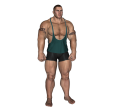 Shoulder Circles - Fundamental
Shoulder Circles - Fundamental
Benefits: This exercise tones and tightens your shoulders.
Purpose: This exercise focuses on working the entire shoulder joint and makes an excellent warm-up before any resistance or weigh training involving the shoulders.
Beginner Shoulders Traps Stretching Body Only Gym Home
General Info: Shoulder Circles require little time, yet can give good benefits when done regularly. They can be done almost anywhere, without special equipment. The three heads of the deltoid muscles require regular movement to ensure their flexibility and mobility.
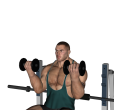 Shoulder Press - Arnold Dumbbell
Shoulder Press - Arnold Dumbbell
Benefits: The press is a highly effective compound upper-body exercise.
Purpose: Shoulder presses are good exercises for building up and strengthening the shoulder region. The Arnold Shoulder Press is an excellent intermediate alternative to the standard shoulder press.
Intermediate Shoulders Forearms Triceps Strength Dumbbell Flat Bench Push Compound Gym
General Info: The deltoid is a fan-shaped muscle. The Anterior (front) deltoid raises the arm toward the front of the body and rotates the arm inward. The Lateral (side) deltoid raises the arm to the side. The Posterior (rear) deltoid raises the arm toward the rear and rotates the arm outward. This exercise was created by bodybuilder Arnold Schwarzenegger and hits both the medial and front heads of deltoids.
 Shoulder Press - Arnold Water Bottle
Shoulder Press - Arnold Water Bottle
Benefits: The press is a highly effective compound upper-body exercise.
Purpose: Shoulder presses are good exercises for building up and strengthening the shoulder region. The Arnold Shoulder Press is an excellent intermediate alternative to the standard shoulder press.
Intermediate Shoulders Forearms Triceps Strength Water Bottle Chair Push Compound Home
General Info: The deltoids is a fan-shaped muscle. The Anterior (front) deltoid raises the arm toward the front of the body and rotates the arm inward. The Lateral (side) deltoid raises the arm to the side. The Posterior (rear) deltoid raises the arm toward the rear and rotates the arm outward. This exercise was created by bodybuilder Arnold Schwarzenegger and hits both the medial and front heads of deltoids.
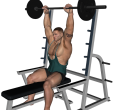 Shoulder Press - Barbell
Shoulder Press - Barbell
Benefits: The press is a highly effective compound upper-body exercise.
Purpose: The Barbell Shoulder Press (sometimes called the Military Press) is a good exercise for building up and strengthening the shoulder region.
Intermediate Shoulders Triceps Chest Strength Barbell Military Press Chair Push Compound Gym
General Info: The Deltoids is a fan-shaped muscle. The Anterior (Front) Deltoid raises the arm toward the front of the body and rotates the arm inward. The Lateral (Side) Deltoid raises the arm to the side. The Posterior (Rear) Deltoid raises the arm toward the rear and rotates the arm outward.
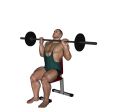 Shoulder Press - Bradford Rocky
Shoulder Press - Bradford Rocky
Benefits: The press is a highly effective compound upper-body exercise.
Purpose: The Military Press is a good exercise for building up and strengthening the shoulder region.
Intermediate Shoulders Triceps Chest Strength Barbell Push Compound Gym
General Info: The Deltoids is a fan-shaped muscle. The Anterior (Front) Deltoid raises the arm toward the front of the body and rotates the arm inward. The Lateral (Side) Deltoid raises the arm to the side. The Posterior (Rear) Deltoid raises the arm toward the rear and rotates the arm outward.
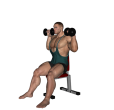 Shoulder Press - Dumbbell
Shoulder Press - Dumbbell
Benefits: The press is a highly effective compound upper-body exercise.
Purpose: The Shoulder Press is a good exercise for building up and strengthening the shoulder region.
Beginner Shoulders Triceps Chest Strength Dumbbell Military Press Chair Push Compound Gym
General Info: The Deltoids is a fan-shaped muscle. The Anterior (Front) Deltoid raises the arm toward the front of the body and rotates the arm inward. The Lateral (Side) Deltoid raises the arm to the side. The Posterior (Rear) Deltoid raises the arm toward the rear and rotates the arm outward.
 Shoulder Press - Dumbbell Single
Shoulder Press - Dumbbell Single
Benefits: The press is a highly effective compound upper-body exercise.
Purpose: The Barbell Shoulder Press (sometimes called the Military Press) is a good exercise for building up and strengthening the shoulder region.
Beginner Shoulders Triceps Chest Strength Dumbbell Military Press Chair Push Compound Gym
General Info: The Deltoids is a fan-shaped muscle. The Anterior (Front) Deltoid raises the arm toward the front of the body and rotates the arm inward. The Lateral (Side) Deltoid raises the arm to the side. The Posterior (Rear) Deltoid raises the arm toward the rear and rotates the arm outward.
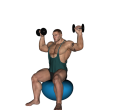 Shoulder Press - Fitness Ball Dublin
Shoulder Press - Fitness Ball Dublin
Benefits: The shoulder press is a highly effective compound upper-body exercise.
Purpose: The shoulder press is a good exercise for building up and strengthening the shoulder region.
Intermediate Shoulders Triceps Strength Dumbbell Fitness Ball Push Compound Gym
General Info: The Deltoids is a fan-shaped muscle. The Anterior (Front) Deltoid raises the arm toward the front of the body and rotates the arm inward. The Lateral (Side) Deltoid raises the arm to the side. The Posterior (Rear) Deltoid raises the arm toward the rear and rotates the arm outward.
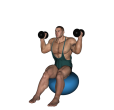 Shoulder Press - Fitness Ball Dumbbell Inwards
Shoulder Press - Fitness Ball Dumbbell Inwards
Benefits: The press is a highly effective compound upper-body exercise.
Purpose: The shoulder press is a good exercise for building up and strengthening the shoulder region.
Beginner Shoulders Triceps Chest Strength Dumbbell Fitness Ball Push Compound Gym
General Info: The Deltoids is a fan-shaped muscle. The Anterior (Front) Deltoid raises the arm toward the front of the body and rotates the arm inward. The Lateral (Side) Deltoid raises the arm to the side. The Posterior (Rear) Deltoid raises the arm toward the rear and rotates the arm outward.
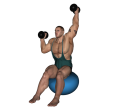 Shoulder Press - Fitness Ball Dumbbell Inwards Alternate
Shoulder Press - Fitness Ball Dumbbell Inwards Alternate
Benefits: The press is a highly effective compound upper-body exercise.
Purpose: The shoulder press is a good exercise for building up and strengthening the shoulder region.
Beginner Shoulders Triceps Chest Strength Dumbbell Fitness Ball Push Compound Gym
General Info: The Deltoids is a fan-shaped muscle. The Anterior (Front) Deltoid raises the arm toward the front of the body and rotates the arm inward. The Lateral (Side) Deltoid raises the arm to the side. The Posterior (Rear) Deltoid raises the arm toward the rear and rotates the arm outward.
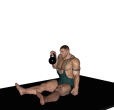 Shoulder Press - Kettlebell
Shoulder Press - Kettlebell
Benefits: The press is a highly effective compound upper-body exercise.
Purpose: The Shoulder Press is a good exercise for building up and strengthening the shoulder region.
Shoulders Triceps Chest Strength Kettlebell Push Compound Gym
General Info: The Deltoids is a fan-shaped muscle. The Anterior (Front) Deltoid raises the arm toward the front of the body and rotates the arm inward. The Lateral (Side) Deltoid raises the arm to the side. The Posterior (Rear) Deltoid raises the arm toward the rear and rotates the arm outward.
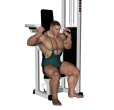 Shoulder Press - Machine
Shoulder Press - Machine
Benefits: The press is a highly effective compound upper-body exercise.
Purpose: The press is a good exercise for building up and strengthening the shoulder region.
Intermediate Shoulders Triceps Chest Strength Shoulder Press Machine Push Compound Gym
General Info: The Deltoids is a fan-shaped muscle. The Anterior (Front) Deltoid raises the arm toward the front of the body and rotates the arm inward. The Lateral (Side) Deltoid raises the arm to the side. The Posterior (Rear) Deltoid raises the arm toward the rear and rotates the arm outward.
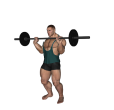 Shoulder Press - Push
Shoulder Press - Push
Benefits: The press is a highly effective compound upper-body exercise.
Purpose: The push press is a good exercise for building up and strengthening the shoulder region.
Intermediate Shoulders Triceps Chest Strength Barbell Push Compound Gym
General Info: The Deltoids is a fan-shaped muscle. The Anterior (Front) Deltoid raises the arm toward the front of the body and rotates the arm inward. The Lateral (Side) Deltoid raises the arm to the side. The Posterior (Rear) Deltoid raises the arm toward the rear and rotates the arm outward.
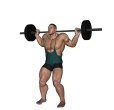 Shoulder Press - Push Behind The Neck
Shoulder Press - Push Behind The Neck
Benefits: The press is a highly effective compound upper-body exercise.
Purpose: The push press is a good exercise for building up and strengthening the shoulder region.
Intermediate Shoulders Triceps Chest Strength Barbell Push Compound Gym
General Info: The Deltoids is a fan-shaped muscle. The Anterior (Front) Deltoid raises the arm toward the front of the body and rotates the arm inward. The Lateral (Side) Deltoid raises the arm to the side. The Posterior (Rear) Deltoid raises the arm toward the rear and rotates the arm outward.
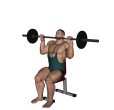 Shoulder Press - Seated Barbell Military
Shoulder Press - Seated Barbell Military
Benefits: The press is a highly effective compound upper-body exercise.
Purpose: The Military Press is a good exercise for building up and strengthening the shoulder region.
Intermediate Shoulders Triceps Chest Strength Barbell Military Press Chair Push Compound Gym
General Info: The deltoid is a fan-shaped muscle. The Anterior (Front) Deltoid raises the arm toward the front of the body and rotates the arm inward. The Lateral (Side) Deltoid raises the arm to the side. The Posterior (Rear) Deltoid raises the arm toward the rear and rotates the arm outward.
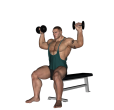 Shoulder Press - Seated Dublin
Shoulder Press - Seated Dublin
Benefits: The press is a highly effective compound upper-body exercise.
Purpose: The shoulder press is a good exercise for building up and strengthening the shoulder region.
Intermediate Shoulders Triceps Strength Dumbbell Flat Bench Push Compound Gym
General Info: The Deltoids is a fan-shaped muscle. The Anterior (Front) Deltoid raises the arm toward the front of the body and rotates the arm inward. The Lateral (Side) Deltoid raises the arm to the side. The Posterior (Rear) Deltoid raises the arm toward the rear and rotates the arm outward.
 Shoulder Press - Seated Dublin Water Bottle
Shoulder Press - Seated Dublin Water Bottle
Benefits: The press is a highly effective compound upper-body exercise.
Purpose: The Press is a good exercise for building up and strengthening the shoulder region.
Intermediate Shoulders Triceps Strength Water Bottle Chair Push Compound Home
General Info: The Deltoids is a fan-shaped muscle. The Anterior (Front) Deltoid raises the arm toward the front of the body and rotates the arm inward. The Lateral (Side) Deltoid raises the arm to the side. The Posterior (Rear) Deltoid raises the arm toward the rear and rotates the arm outward.
 Shoulder Press - Smith Machine Kneeling Front
Shoulder Press - Smith Machine Kneeling Front
Benefits: The press is a highly effective compound upper-body exercise.
Purpose: The shoulder press is a good exercise for building up and strengthening the shoulder region.
Intermediate Shoulders Triceps Chest Strength Smith Machine Push Compound Gym
General Info: The Deltoids is a fan-shaped muscle. The Anterior (Front) Deltoid raises the arm toward the front of the body and rotates the arm inward. The Lateral (Side) Deltoid raises the arm to the side. The Posterior (Rear) Deltoid raises the arm toward the rear and rotates the arm outward.
 Shoulder Press - Smith Machine Kneeling Rear
Shoulder Press - Smith Machine Kneeling Rear
Benefits: The press is a highly effective compound upper-body exercise.
Purpose: The shoulder press is a good exercise for building up and strengthening the shoulder region.
Intermediate Shoulders Triceps Chest Strength Smith Machine Push Compound Gym
General Info: The Deltoids is a fan-shaped muscle. The Anterior (Front) Deltoid raises the arm toward the front of the body and rotates the arm inward. The Lateral (Side) Deltoid raises the arm to the side. The Posterior (Rear) Deltoid raises the arm toward the rear and rotates the arm outward.
 Shoulder Press - Smith Machine Kneeling Reverse
Shoulder Press - Smith Machine Kneeling Reverse
Benefits: The press is a highly effective compound upper-body exercise.
Purpose: The shoulder press is a good exercise for building up and strengthening the shoulder region.
Intermediate Shoulders Triceps Chest Strength Smith Machine Push Compound Gym
General Info: The Deltoids is a fan-shaped muscle. The Anterior (Front) Deltoid raises the arm toward the front of the body and rotates the arm inward. The Lateral (Side) Deltoid raises the arm to the side. The Posterior (Rear) Deltoid raises the arm toward the rear and rotates the arm outward.
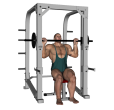 Shoulder Press - Smith Machine Overhead
Shoulder Press - Smith Machine Overhead
Benefits: The press is a highly effective compound upper-body exercise.
Purpose: The shoulder press is a good exercise for building up and strengthening the shoulder region.
Intermediate Shoulders Triceps Chest Strength Smith Machine Push Compound Gym
General Info: The Deltoids is a fan-shaped muscle. The Anterior (Front) Deltoid raises the arm toward the front of the body and rotates the arm inward. The Lateral (Side) Deltoid raises the arm to the side. The Posterior (Rear) Deltoid raises the arm toward the rear and rotates the arm outward.
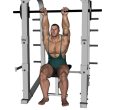 Shoulder Press - Smith Machine Seated
Shoulder Press - Smith Machine Seated
Benefits: The press is a highly effective compound upper-body exercise.
Purpose: The shoulder press is a good exercise for building up and strengthening the shoulder region.
Intermediate Shoulders Triceps Chest Strength Smith Machine Flat Bench Push Compound Gym
General Info: The Deltoids is a fan-shaped muscle. The Anterior (Front) Deltoid raises the arm toward the front of the body and rotates the arm inward. The Lateral (Side) Deltoid raises the arm to the side. The Posterior (Rear) Deltoid raises the arm toward the rear and rotates the arm outward.
 Shoulder Press - Smith Machine Seated Feet Up
Shoulder Press - Smith Machine Seated Feet Up
Benefits: The press is a highly effective compound upper-body exercise.
Purpose: The shoulder press is a good exercise for building up and strengthening the shoulder region.
Intermediate Shoulders Triceps Chest Strength Smith Machine Flat Bench Push Compound Gym
General Info: The Deltoids is a fan-shaped muscle. The Anterior (Front) Deltoid raises the arm toward the front of the body and rotates the arm inward. The Lateral (Side) Deltoid raises the arm to the side. The Posterior (Rear) Deltoid raises the arm toward the rear and rotates the arm outward.
 Shoulder Press - Smith Machine Seated Feet Up Rear
Shoulder Press - Smith Machine Seated Feet Up Rear
Benefits: The press is a highly effective compound upper-body exercise.
Purpose: The shoulder press is a good exercise for building up and strengthening the shoulder region.
Intermediate Shoulders Triceps Chest Strength Smith Machine Flat Bench Push Compound Gym
General Info: The Deltoids is a fan-shaped muscle. The Anterior (Front) Deltoid raises the arm toward the front of the body and rotates the arm inward. The Lateral (Side) Deltoid raises the arm to the side. The Posterior (Rear) Deltoid raises the arm toward the rear and rotates the arm outward.
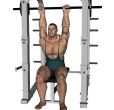 Shoulder Press - Smith Machine Seated Rear
Shoulder Press - Smith Machine Seated Rear
Benefits: The press is a highly effective compound upper-body exercise.
Purpose: The shoulder press is a good exercise for building up and strengthening the shoulder region.
Intermediate Shoulders Triceps Chest Strength Smith Machine Flat Bench Push Compound Gym
General Info: The Deltoids is a fan-shaped muscle. The Anterior (Front) Deltoid raises the arm toward the front of the body and rotates the arm inward. The Lateral (Side) Deltoid raises the arm to the side. The Posterior (Rear) Deltoid raises the arm toward the rear and rotates the arm outward.
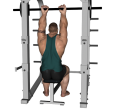 Shoulder Press - Smith Machine Seated Reverse
Shoulder Press - Smith Machine Seated Reverse
Benefits: The press is a highly effective compound upper-body exercise.
Purpose: The shoulder press is a good exercise for building up and strengthening the shoulder region.
Intermediate Shoulders Triceps Chest Strength Smith Machine Flat Bench Push Compound Gym
General Info: The Deltoids is a fan-shaped muscle. The Anterior (Front) Deltoid raises the arm toward the front of the body and rotates the arm inward. The Lateral (Side) Deltoid raises the arm to the side. The Posterior (Rear) Deltoid raises the arm toward the rear and rotates the arm outward.
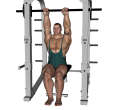 Shoulder Press - Smith Machine Seated Upright
Shoulder Press - Smith Machine Seated Upright
Benefits: The press is a highly effective compound upper-body exercise.
Purpose: The shoulder press is a good exercise for building up and strengthening the shoulder region.
Intermediate Shoulders Triceps Chest Strength Smith Machine Flat Bench Push Compound Gym
General Info: The Deltoids is a fan-shaped muscle. The Anterior (Front) Deltoid raises the arm toward the front of the body and rotates the arm inward. The Lateral (Side) Deltoid raises the arm to the side. The Posterior (Rear) Deltoid raises the arm toward the rear and rotates the arm outward.
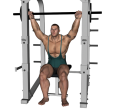 Shoulder Press - Smith Machine Seated Wide Grip
Shoulder Press - Smith Machine Seated Wide Grip
Benefits: The press is a highly effective compound upper-body exercise.
Purpose: The shoulder press is a good exercise for building up and strengthening the shoulder region.
Intermediate Shoulders Triceps Chest Strength Smith Machine Flat Bench Push Compound Gym
General Info: The Deltoids is a fan-shaped muscle. The Anterior (Front) Deltoid raises the arm toward the front of the body and rotates the arm inward. The Lateral (Side) Deltoid raises the arm to the side. The Posterior (Rear) Deltoid raises the arm toward the rear and rotates the arm outward.
 Shoulder Press - Smith Seated Feet On Bench Rear
Shoulder Press - Smith Seated Feet On Bench Rear
Benefits: The press is a highly effective compound upper-body exercise.
Purpose: The shoulder press is a good exercise for building up and strengthening the shoulder region.
Intermediate Shoulders Triceps Chest Strength Smith Machine Flat Bench Push Compound Gym
General Info: The Deltoids is a fan-shaped muscle. The Anterior (Front) Deltoid raises the arm toward the front of the body and rotates the arm inward. The Lateral (Side) Deltoid raises the arm to the side. The Posterior (Rear) Deltoid raises the arm toward the rear and rotates the arm outward.
 Shoulder Press - Smith Seated Feet Up Reverse
Shoulder Press - Smith Seated Feet Up Reverse
Benefits: The press is a highly effective compound upper-body exercise.
Purpose: The shoulder press is a good exercise for building up and strengthening the shoulder region.
Intermediate Shoulders Triceps Chest Strength Smith Machine Flat Bench Push Compound Gym
General Info: The Deltoids is a fan-shaped muscle. The Anterior (Front) Deltoid raises the arm toward the front of the body and rotates the arm inward. The Lateral (Side) Deltoid raises the arm to the side. The Posterior (Rear) Deltoid raises the arm toward the rear and rotates the arm outward.
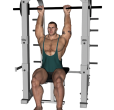 Shoulder Press - Smith Seated Rear Upright
Shoulder Press - Smith Seated Rear Upright
Benefits: The press is a highly effective compound upper-body exercise.
Purpose: The shoulder press is a good exercise for building up and strengthening the shoulder region.
Intermediate Shoulders Triceps Chest Strength Smith Machine Flat Bench Push Compound Gym
General Info: The Deltoids is a fan-shaped muscle. The Anterior (Front) Deltoid raises the arm toward the front of the body and rotates the arm inward. The Lateral (Side) Deltoid raises the arm to the side. The Posterior (Rear) Deltoid raises the arm toward the rear and rotates the arm outward.
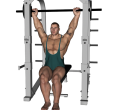 Shoulder Press - Smith Seated Rear Upright Wide
Shoulder Press - Smith Seated Rear Upright Wide
Benefits: The press is a highly effective compound upper-body exercise.
Purpose: The shoulder press is a good exercise for building up and strengthening the shoulder region.
Intermediate Shoulders Triceps Chest Strength Smith Machine Flat Bench Push Compound Gym
General Info: The Deltoids is a fan-shaped muscle. The Anterior (Front) Deltoid raises the arm toward the front of the body and rotates the arm inward. The Lateral (Side) Deltoid raises the arm to the side. The Posterior (Rear) Deltoid raises the arm toward the rear and rotates the arm outward.
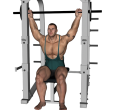 Shoulder Press - Smith Seated Rear Wide Grip
Shoulder Press - Smith Seated Rear Wide Grip
Benefits: The press is a highly effective compound upper-body exercise.
Purpose: The shoulder press is a good exercise for building up and strengthening the shoulder region.
Intermediate Shoulders Triceps Chest Strength Smith Machine Flat Bench Push Compound Gym
General Info: The Deltoids is a fan-shaped muscle. The Anterior (Front) Deltoid raises the arm toward the front of the body and rotates the arm inward. The Lateral (Side) Deltoid raises the arm to the side. The Posterior (Rear) Deltoid raises the arm toward the rear and rotates the arm outward.
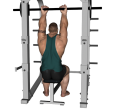 Shoulder Press - Smith Seated Reverse
Shoulder Press - Smith Seated Reverse
Benefits: The press is a highly effective compound upper-body exercise.
Purpose: The shoulder press is a good exercise for building up and strengthening the shoulder region.
Intermediate Shoulders Triceps Chest Strength Smith Machine Flat Bench Push Compound Gym
General Info: The Deltoids is a fan-shaped muscle. The Anterior (Front) Deltoid raises the arm toward the front of the body and rotates the arm inward. The Lateral (Side) Deltoid raises the arm to the side. The Posterior (Rear) Deltoid raises the arm toward the rear and rotates the arm outward.
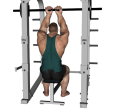 Shoulder Press - Smith Seated Reverse Close Grip
Shoulder Press - Smith Seated Reverse Close Grip
Benefits: The press is a highly effective compound upper-body exercise.
Purpose: The shoulder press is a good exercise for building up and strengthening the shoulder region.
Intermediate Shoulders Triceps Chest Strength Smith Machine Flat Bench Push Compound Gym
General Info: The Deltoids is a fan-shaped muscle. The Anterior (Front) Deltoid raises the arm toward the front of the body and rotates the arm inward. The Lateral (Side) Deltoid raises the arm to the side. The Posterior (Rear) Deltoid raises the arm toward the rear and rotates the arm outward.
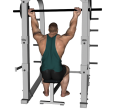 Shoulder Press - Smith Seated Reverse Wide
Shoulder Press - Smith Seated Reverse Wide
Benefits: The press is a highly effective compound upper-body exercise.
Purpose: The shoulder press is a good exercise for building up and strengthening the shoulder region.
Intermediate Shoulders Triceps Chest Strength Smith Machine Flat Bench Push Compound Gym
General Info: The Deltoids is a fan-shaped muscle. The Anterior (Front) Deltoid raises the arm toward the front of the body and rotates the arm inward. The Lateral (Side) Deltoid raises the arm to the side. The Posterior (Rear) Deltoid raises the arm toward the rear and rotates the arm outward.
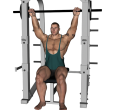 Shoulder Press - Smith Seated Upright Wide Grip
Shoulder Press - Smith Seated Upright Wide Grip
Benefits: The press is a highly effective compound upper-body exercise.
Purpose: The shoulder press is a good exercise for building up and strengthening the shoulder region.
Intermediate Shoulders Triceps Chest Strength Smith Machine Flat Bench Push Compound Gym
General Info: The Deltoids is a fan-shaped muscle. The Anterior (Front) Deltoid raises the arm toward the front of the body and rotates the arm inward. The Lateral (Side) Deltoid raises the arm to the side. The Posterior (Rear) Deltoid raises the arm toward the rear and rotates the arm outward.
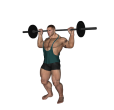 Shoulder Press - Standing Barbell Behind Neck
Shoulder Press - Standing Barbell Behind Neck
Benefits: The press is a highly effective compound upper-body exercise.
Purpose: The press is a good exercise for building up and strengthening the shoulder region.
Intermediate Shoulders Triceps Chest Strength Barbell Push Compound Gym
General Info: The Deltoids is a fan-shaped muscle. The Anterior (Front) Deltoid raises the arm toward the front of the body and rotates the arm inward. The Lateral (Side) Deltoid raises the arm to the side. The Posterior (Rear) Deltoid raises the arm toward the rear and rotates the arm outward.
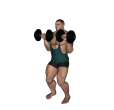 Shoulder Press - Standing Dumbbell
Shoulder Press - Standing Dumbbell
Benefits: The press is a highly effective compound upper-body exercise.
Purpose: The press is a good exercise for building up and strengthening the shoulder region.
Intermediate Shoulders Triceps Chest Strength Dumbbell Push Compound Gym
General Info: The Deltoids is a fan-shaped muscle. The Anterior (Front) Deltoid raises the arm toward the front of the body and rotates the arm inward. The Lateral (Side) Deltoid raises the arm to the side. The Posterior (Rear) Deltoid raises the arm toward the rear and rotates the arm outward.
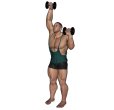 Shoulder Press - Standing Dumbbell Alternate
Shoulder Press - Standing Dumbbell Alternate
Benefits: The press is a highly effective compound upper-body exercise.
Purpose: The Military Press is a good exercise for building up and strengthening the shoulder region.
Intermediate Shoulders Triceps Chest Strength Dumbbell Push Compound Gym
General Info: The Deltoids is a fan-shaped muscle. The Anterior (Front) Deltoid raises the arm toward the front of the body and rotates the arm inward. The Lateral (Side) Deltoid raises the arm to the side. The Posterior (Rear) Deltoid raises the arm toward the rear and rotates the arm outward.
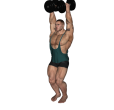 Shoulder Press - Standing Dumbbell Inwards Narrow
Shoulder Press - Standing Dumbbell Inwards Narrow
Benefits: The press is a highly effective compound upper-body exercise.
Purpose: The shoulder press is a good exercise for building up and strengthening the shoulder region.
Intermediate Shoulders Triceps Chest Strength Dumbbell Push Compound Gym
General Info: The Deltoids is a fan-shaped muscle. The Anterior (Front) Deltoid raises the arm toward the front of the body and rotates the arm inward. The Lateral (Side) Deltoid raises the arm to the side. The Posterior (Rear) Deltoid raises the arm toward the rear and rotates the arm outward.
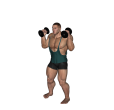 Shoulder Press - Standing Dumbbell Palms In
Shoulder Press - Standing Dumbbell Palms In
Benefits: The press is a highly effective compound upper-body exercise.
Purpose: The shoulder press is a good exercise for building up and strengthening the shoulder region.
Intermediate Shoulders Triceps Chest Strength Dumbbell Push Compound Gym
General Info: The Deltoids is a fan-shaped muscle. The Anterior (Front) Deltoid raises the arm toward the front of the body and rotates the arm inward. The Lateral (Side) Deltoid raises the arm to the side. The Posterior (Rear) Deltoid raises the arm toward the rear and rotates the arm outward.
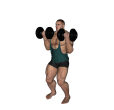 Shoulder Press - Standing Dumbbell Reverse
Shoulder Press - Standing Dumbbell Reverse
Benefits: The press is a highly effective compound upper-body exercise.
Purpose: The shoulder press is a good exercise for building up and strengthening the shoulder region.
Intermediate Shoulders Triceps Chest Strength Dumbbell Push Compound Gym
General Info: The Deltoids is a fan-shaped muscle. The Anterior (Front) Deltoid raises the arm toward the front of the body and rotates the arm inward. The Lateral (Side) Deltoid raises the arm to the side. The Posterior (Rear) Deltoid raises the arm toward the rear and rotates the arm outward.
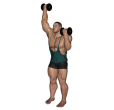 Shoulder Press - Standing Dumbbell Reverse Alternate
Shoulder Press - Standing Dumbbell Reverse Alternate
Benefits: The press is a highly effective compound upper-body exercise.
Purpose: The Military Press is a good exercise for building up and strengthening the shoulder region.
Intermediate Shoulders Triceps Chest Strength Dumbbell Push Compound Gym
General Info: The Deltoids is a fan-shaped muscle. The Anterior (Front) Deltoid raises the arm toward the front of the body and rotates the arm inward. The Lateral (Side) Deltoid raises the arm to the side. The Posterior (Rear) Deltoid raises the arm toward the rear and rotates the arm outward.
 Shoulder Press - Standing Dumbbell Single
Shoulder Press - Standing Dumbbell Single
Benefits: The press is a highly effective compound upper-body exercise.
Purpose: The Military Press is a good exercise for building up and strengthening the shoulder region.
Intermediate Shoulders Triceps Chest Strength Dumbbell Push Compound Gym
General Info: The Deltoids is a fan-shaped muscle. The Anterior (Front) Deltoid raises the arm toward the front of the body and rotates the arm inward. The Lateral (Side) Deltoid raises the arm to the side. The Posterior (Rear) Deltoid raises the arm toward the rear and rotates the arm outward.
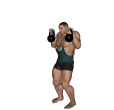 Shoulder Press - Standing Kettlebell
Shoulder Press - Standing Kettlebell
Benefits: The press is a highly effective compound upper-body exercise.
Purpose: The Military Press is a good exercise for building up and strengthening the shoulder region.
Shoulders Triceps Chest Strength Kettlebell Push Compound Gym
General Info: The Deltoids is a fan-shaped muscle. The Anterior (Front) Deltoid raises the arm toward the front of the body and rotates the arm inward. The Lateral (Side) Deltoid raises the arm to the side. The Posterior (Rear) Deltoid raises the arm toward the rear and rotates the arm outward.
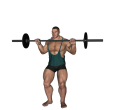 Shoulder Press - Standing Military
Shoulder Press - Standing Military
Benefits: The press is a highly effective compound upper-body exercise.
Purpose: The Military Press is a good exercise for building up and strengthening the shoulder region.
Intermediate Shoulders Triceps Chest Strength Barbell Push Compound Gym
General Info: The Deltoids is a fan-shaped muscle. The Anterior (Front) Deltoid raises the arm toward the front of the body and rotates the arm inward. The Lateral (Side) Deltoid raises the arm to the side. The Posterior (Rear) Deltoid raises the arm toward the rear and rotates the arm outward.
 Shoulder Press - Water Bottle
Shoulder Press - Water Bottle
Benefits: The press is a highly effective compound upper-body exercise.
Purpose: The Barbell Shoulder Press (sometimes called the Military Press) is a good exercise for building up and strengthening the shoulder region.
Beginner Shoulders Triceps Chest Strength Water Bottle Chair Push Compound Home
General Info: The Deltoids is a fan-shaped muscle. The Anterior (Front) Deltoid raises the arm toward the front of the body and rotates the arm inward. The Lateral (Side) Deltoid raises the arm to the side. The Posterior (Rear) Deltoid raises the arm toward the rear and rotates the arm outward.
 Shoulder Press - Water Bottle Single
Shoulder Press - Water Bottle Single
Benefits: The press is a highly effective compound upper-body exercise.
Purpose: The Barbell Shoulder Press (sometimes called the Military Press) is a good exercise for building up and strengthening the shoulder region.
Beginner Shoulders Triceps Chest Strength Water Bottle Chair Push Compound Home
General Info: The Deltoids is a fan-shaped muscle. The Anterior (Front) Deltoid raises the arm toward the front of the body and rotates the arm inward. The Lateral (Side) Deltoid raises the arm to the side. The Posterior (Rear) Deltoid raises the arm toward the rear and rotates the arm outward.
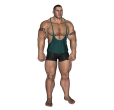 Shoulder Raise - Basic
Shoulder Raise - Basic
Benefits: This exercise tones and tightens your shoulders.
Purpose: This exercise focuses on working the entire shoulder joint and makes an excellent warm-up before any resistance or weigh training involving the shoulders.
Beginner Shoulders Lats Stretching Body Only Gym Home
General Info: Shoulder raises require little time, yet can give good benefits when done regularly. They can be done almost anywhere, without special equipment. The three heads of the deltoid muscles require regular movement to ensure their flexibility and mobility.
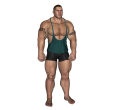 Shoulder Stretch - Basic
Shoulder Stretch - Basic
Benefits: This exercise tones and increases the flexibility of your shoulders.
Purpose: This exercise focuses on working the entire shoulder joint and makes an excellent warm-up before any resistance or weigh training involving the shoulders.
Beginner Shoulders Stretching Body Only Gym Home
General Info: Shoulder raises require little time, yet can give good benefits when done regularly. They can be done almost anywhere, without special equipment. The three heads of the deltoid muscles require regular movement to ensure their flexibility and mobility.
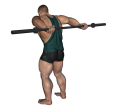 Shoulder Stretch - Round The World
Shoulder Stretch - Round The World
Benefits: This exercise tones and increases the flexibility of your shoulders.
Purpose: This exercise focuses on working the entire shoulder joint and makes an excellent warm-up before any resistance or weigh training involving the shoulders.
Beginner Shoulders Chest Stretching Body Only Gym Home
General Info: Shoulder raises require little time, yet can give good benefits when done regularly. They can be done almost anywhere, without special equipment. The three heads of the deltoid muscles require regular movement to ensure their flexibility and mobility.
 Sit Up - Press
Sit Up - Press
Benefits: Sit up exercises will give you a well-defined mid-section.
Purpose: Sit up exercises strengthen the upper abdominal and the shoulder muscles.
Abdominals Hip Flexors Shoulders Strength Barbell Abdominal Bench Gym Home
General Info: The abs can be divided into the abdominals themselves and the obliques. The obliques are the outer abs and are used in twisting movements. For the sake of exercising, the abdominals are sometimes divided into upper abs and lower abs (this is not a technical division but something for exercising). Both upper and lower abs are used in straight line ab exercises while the upper abs are also involved in twisting movements.
 Snatch - Balance
Snatch - Balance
Benefits: The press is a highly effective compound upper-body exercise.
Purpose: This exercise is a good exercise for building up and strengthening the shoulder region.
Intermediate Shoulders Triceps Traps Glutes Hamstrings Quads Strength Barbell Push Compound Gym
General Info: The Deltoids is a fan-shaped muscle. The Anterior (Front) Deltoid raises the arm toward the front of the body and rotates the arm inward. The Lateral (Side) Deltoid raises the arm to the side. The Posterior (Rear) Deltoid raises the arm toward the rear and rotates the arm outward.
 Snatch - Basic
Snatch - Basic
Benefits: The press is a highly effective compound upper-body exercise.
Purpose: This exercise is a good exercise for building up and strengthening the shoulder region.
Intermediate Shoulders Triceps Traps Strength Barbell Push Compound Gym
General Info: The Deltoids is a fan-shaped muscle. The Anterior (Front) Deltoid raises the arm toward the front of the body and rotates the arm inward. The Lateral (Side) Deltoid raises the arm to the side. The Posterior (Rear) Deltoid raises the arm toward the rear and rotates the arm outward.
 Snatch - From Blocks
Snatch - From Blocks
Benefits: The press is a highly effective compound upper-body exercise.
Purpose: This exercise is a good exercise for building up and strengthening the shoulder region.
Intermediate Shoulders Triceps Traps Strength Barbell Push Compound Gym
General Info: The Deltoids is a fan-shaped muscle. The Anterior (Front) Deltoid raises the arm toward the front of the body and rotates the arm inward. The Lateral (Side) Deltoid raises the arm to the side. The Posterior (Rear) Deltoid raises the arm toward the rear and rotates the arm outward.
 Snatch - Split
Snatch - Split
Benefits: The press is a highly effective compound upper-body exercise.
Purpose: This exercise is a good exercise for building up and strengthening the shoulder region.
Intermediate Shoulders Triceps Traps Strength Barbell Push Compound Gym
General Info: The Deltoids is a fan-shaped muscle. The Anterior (Front) Deltoid raises the arm toward the front of the body and rotates the arm inward. The Lateral (Side) Deltoid raises the arm to the side. The Posterior (Rear) Deltoid raises the arm toward the rear and rotates the arm outward.
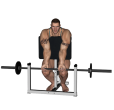 Spider Curl - Barbell Close Grip
Spider Curl - Barbell Close Grip
Benefits: Spider curls do a perfect job of placing maximum tension on the biceps in the fully contracted position. As an alternate, spider curls can be done with a barbell instead of dumbbells.
Purpose: This exercise works the biceps muscles but focuses also on the brachioradialis (a muscle that crosses the elbow joint and assists in rotating the forearm).
Beginner Biceps Forearms Shoulders Traps Strength Barbell Preacher Bench Pull Gym
General Info: The biceps muscle is a straight muscle with 2 heads. The long head crosses both the elbow and shoulder joints and bends the elbow and raises the arm forward at the shoulder. The short head of the biceps crosses the elbow joint and, in conjunction with the brachioradialis, supinates the hand.
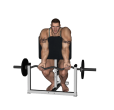 Spider Curl - Basic
Spider Curl - Basic
Benefits: Spider curls do a perfect job of placing maximum tension on the biceps in the fully contracted position. As an alternate, spider curls can be done with a barbell instead of dumbbells.
Purpose: This exercise works the biceps muscles but focuses also on the brachioradialis (a muscle that crosses the elbow joint and assists in rotating the forearm.
Beginner Biceps Forearms Shoulders Traps Strength EZ Bar Preacher Bench Pull Gym
General Info: The biceps muscle is a straight muscle with 2 heads. The long head crosses both the elbow and shoulder joints and bends the elbow and raises the arm forward at the shoulder. The short head of the biceps crosses the elbow joint and, in conjunction with the brachioradialis, supinates the hand.
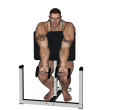 Spider Curl - Dumbbell
Spider Curl - Dumbbell
Benefits: Spider curls do a perfect job of placing maximum tension on the biceps in the fully contracted position. As an alternate, spider curls can be done with a barbell instead of dumbbells.
Purpose: This exercise works the biceps muscles but focuses also on the brachioradialis (a muscle that crosses the elbow joint and assists in rotating the forearm.
Beginner Biceps Forearms Shoulders Traps Strength Dumbbell Preacher Bench Pull Gym
General Info: The biceps muscle is a straight muscle with 2 heads. The long head crosses both the elbow and shoulder joints and bends the elbow and raises the arm forward at the shoulder. The short head of the biceps crosses the elbow joint and, in conjunction with the brachioradialis, supinates the hand.
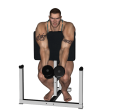 Spider Curl - Dumbbell Hammer
Spider Curl - Dumbbell Hammer
Benefits: Spider curls do a perfect job of placing maximum tension on the biceps in the fully contracted position. Using a hammer grip places the hands in a very strong position.
Purpose: This exercise works the biceps muscles but focuses also on the brachioradialis (a muscle that crosses the elbow joint and assists in rotating the forearm.
Beginner Biceps Forearms Shoulders Traps Strength Dumbbell Preacher Bench Pull Gym
General Info: The biceps muscle is a straight muscle with 2 heads. The long head crosses both the elbow and shoulder joints and bends the elbow and raises the arm forward at the shoulder. The short head of the biceps crosses the elbow joint and, in conjunction with the brachioradialis, supinates the hand.
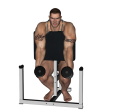 Spider Curl - Dumbbell Hammer Alternate
Spider Curl - Dumbbell Hammer Alternate
Benefits: This exercise isolates the biceps so that momentum does not come into play.
Purpose: This exercise strengthens the biceps.
Beginner Biceps Forearms Shoulders Traps Strength Dumbbell Preacher Bench Pull Gym
General Info: The biceps muscle is a straight muscle with 2 heads. The long head crosses both the elbow and shoulder joints and bends the elbow and raises the arm forward at the shoulder. The short head of the biceps crosses the elbow joint and, in conjunction with the brachioradialis, supinates the hand.
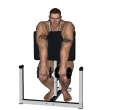 Spider Curl - Dumbbell Reverse
Spider Curl - Dumbbell Reverse
Benefits: Spider curls do a perfect job of placing maximum tension on the biceps in the fully contracted position. The reverse grip also makes the exercise more difficult.
Purpose: This exercise works the biceps muscles but focuses also on the brachioradialis (a muscle that crosses the elbow joint and assists in rotating the forearm.
Beginner Biceps Forearms Shoulders Traps Strength Dumbbell Preacher Bench Pull Gym
General Info: The biceps muscle is a straight muscle with 2 heads. The long head crosses both the elbow and shoulder joints and bends the elbow and raises the arm forward at the shoulder. The short head of the biceps crosses the elbow joint and, in conjunction with the brachioradialis, supinates the hand.
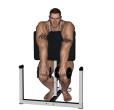 Spider Curl - Dumbbell Zottman
Spider Curl - Dumbbell Zottman
Benefits: Spider curls do a perfect job of placing maximum tension on the biceps in the fully contracted position. Rotating during this exercise also involves the forearms.
Purpose: This exercise works the biceps muscles but focuses also on the brachioradialis (a muscle that crosses the elbow joint and assists in rotating the forearm.
Beginner Biceps Forearms Shoulders Traps Strength Dumbbell Preacher Bench Pull Gym
General Info: The biceps muscle is a straight muscle with 2 heads. The long head crosses both the elbow and shoulder joints and bends the elbow and raises the arm forward at the shoulder. The short head of the biceps crosses the elbow joint and, in conjunction with the brachioradialis, supinates the hand.
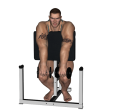 Spider Curl - Dumbbell Zottman Alternate
Spider Curl - Dumbbell Zottman Alternate
Benefits: Spider curls do a perfect job of placing maximum tension on the biceps in the fully contracted position. Rotating during this exercise also involves the forearms.
Purpose: This exercise works the biceps muscles but focuses also on the brachioradialis (a muscle that crosses the elbow joint and assists in rotating the forearm.
Beginner Biceps Forearms Shoulders Traps Strength Dumbbell Preacher Bench Pull Gym
General Info: The biceps muscle is a straight muscle with 2 heads. The long head crosses both the elbow and shoulder joints and bends the elbow and raises the arm forward at the shoulder. The short head of the biceps crosses the elbow joint and, in conjunction with the brachioradialis, supinates the hand.
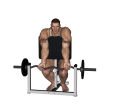 Spider Curl - EZ Bar
Spider Curl - EZ Bar
Benefits: Spider curls do a perfect job of placing maximum tension on the biceps in the fully contracted position.
Purpose: This exercise works the biceps muscles but focuses also on the brachioradialis (a muscle that crosses the elbow joint and assists in rotating the forearm.
Beginner Biceps Forearms Shoulders Traps Strength EZ Bar Preacher Bench Pull Gym
General Info: The biceps muscle is a straight muscle with 2 heads. The long head crosses both the elbow and shoulder joints and bends the elbow and raises the arm forward at the shoulder. The short head of the biceps crosses the elbow joint and, in conjunction with the brachioradialis, supinates the hand.
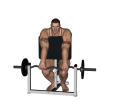 Spider Curl - EZ Bar Reverse
Spider Curl - EZ Bar Reverse
Benefits: Spider curls do a perfect job of placing maximum tension on the biceps in the fully contracted position. The reverse grip makes the exercise more difficult.
Purpose: This exercise works the biceps muscles but focuses also on the brachioradialis (a muscle that crosses the elbow joint and assists in rotating the forearm.
Beginner Biceps Forearms Shoulders Traps Strength EZ Bar Preacher Bench Pull Gym
General Info: The biceps muscle is a straight muscle with 2 heads. The long head crosses both the elbow and shoulder joints and bends the elbow and raises the arm forward at the shoulder. The short head of the biceps crosses the elbow joint and, in conjunction with the brachioradialis, supinates the hand.
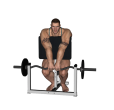 Spider Curl - EZ Bar Reverse Close Grip
Spider Curl - EZ Bar Reverse Close Grip
Benefits: Spider curls do a perfect job of placing maximum tension on the biceps in the fully contracted position. The reverse grip makes the exercise more difficult.
Purpose: This exercise works the biceps muscles but focuses also on the brachioradialis (a muscle that crosses the elbow joint and assists in rotating the forearm.
Beginner Biceps Forearms Shoulders Traps Strength EZ Bar Preacher Bench Pull Gym
General Info: The biceps muscle is a straight muscle with 2 heads. The long head crosses both the elbow and shoulder joints and bends the elbow and raises the arm forward at the shoulder. The short head of the biceps crosses the elbow joint and, in conjunction with the brachioradialis, supinates the hand.
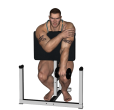 Spider Curl - Reverse Single Dumbbell
Spider Curl - Reverse Single Dumbbell
Benefits: Spider curls do a perfect job of placing maximum tension on the biceps in the fully contracted position. The reverse grip makes the exercise more difficult.
Purpose: This exercise works the biceps muscles but focuses also on the brachioradialis (a muscle that crosses the elbow joint and assists in rotating the forearm.
Beginner Biceps Forearms Shoulders Traps Strength Dumbbell Preacher Bench Pull Gym
General Info: The biceps muscle is a straight muscle with 2 heads. The long head crosses both the elbow and shoulder joints and bends the elbow and raises the arm forward at the shoulder. The short head of the biceps crosses the elbow joint and, in conjunction with the brachioradialis, supinates the hand.
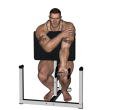 Spider Curl - Single Dumbbell
Spider Curl - Single Dumbbell
Benefits: Spider curls do a perfect job of placing maximum tension on the biceps in the fully contracted position.
Purpose: This exercise works the biceps muscles but focuses also on the brachioradialis (a muscle that crosses the elbow joint and assists in rotating the forearm.
Beginner Biceps Forearms Shoulders Traps Strength Dumbbell Preacher Bench Pull Gym
General Info: The biceps muscle is a straight muscle with 2 heads. The long head crosses both the elbow and shoulder joints and bends the elbow and raises the arm forward at the shoulder. The short head of the biceps crosses the elbow joint and, in conjunction with the brachioradialis, supinates the hand.
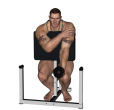 Spider Curl - Single Dumbbell Hammer
Spider Curl - Single Dumbbell Hammer
Benefits: Spider curls do a perfect job of placing maximum tension on the biceps in the fully contracted position.
Purpose: This exercise works the biceps muscles but focuses also on the brachioradialis (a muscle that crosses the elbow joint and assists in rotating the forearm.
Beginner Biceps Forearms Shoulders Traps Strength Dumbbell Preacher Bench Pull Gym
General Info: The biceps muscle is a straight muscle with 2 heads. The long head crosses both the elbow and shoulder joints and bends the elbow and raises the arm forward at the shoulder. The short head of the biceps crosses the elbow joint and, in conjunction with the brachioradialis, supinates the hand.
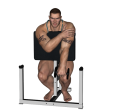 Spider Curl - Single Dumbbell Zottman
Spider Curl - Single Dumbbell Zottman
Benefits: Spider curls do a perfect job of placing maximum tension on the biceps in the fully contracted position.
Purpose: This exercise works the biceps muscles but focuses also on the brachioradialis (a muscle that crosses the elbow joint and assists in rotating the forearm.
Beginner Biceps Forearms Shoulders Traps Strength Dumbbell Preacher Bench Pull Gym
General Info: The biceps muscle is a straight muscle with 2 heads. The long head crosses both the elbow and shoulder joints and bends the elbow and raises the arm forward at the shoulder. The short head of the biceps crosses the elbow joint and, in conjunction with the brachioradialis, supinates the hand.
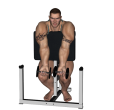 Spider Curl - Zottman Reverse
Spider Curl - Zottman Reverse
Benefits: Spider curls do a perfect job of placing maximum tension on the biceps in the fully contracted position. The reverse grip makes the exercise more difficult.
Purpose: This exercise works the biceps muscles but focuses also on the brachioradialis (a muscle that crosses the elbow joint and assists in rotating the forearm.
Beginner Biceps Forearms Shoulders Traps Strength Dumbbell Preacher Bench Pull Gym
General Info: The biceps muscle is a straight muscle with 2 heads. The long head crosses both the elbow and shoulder joints and bends the elbow and raises the arm forward at the shoulder. The short head of the biceps crosses the elbow joint and, in conjunction with the brachioradialis, supinates the hand.
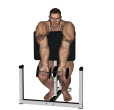 Spider Curl - Zottman Reverse Alternate
Spider Curl - Zottman Reverse Alternate
Benefits: Spider curls do a perfect job of placing maximum tension on the biceps in the fully contracted position. The reverse grip makes the exercise more difficult.
Purpose: This exercise works the biceps muscles but focuses also on the brachioradialis (a muscle that crosses the elbow joint and assists in rotating the forearm.
Beginner Biceps Forearms Shoulders Traps Strength Dumbbell Preacher Bench Pull Gym
General Info: The biceps muscle is a straight muscle with 2 heads. The long head crosses both the elbow and shoulder joints and bends the elbow and raises the arm forward at the shoulder. The short head of the biceps crosses the elbow joint and, in conjunction with the brachioradialis, supinates the hand.
 Stretch - Basic
Stretch - Basic
Benefits: This exercise works both heads of the biceps.
Purpose: This exercise is used to target the biceps muscle to develop flexibility.
Biceps Shoulders Stretching Body Only Gym Home
General Info: The biceps is a straight muscle with two heads. The long head of the biceps crosses both the elbow and the shoulder joint. It bends the elbow and raises the arm forward at the shoulder. The short head crosses the elbow joint and, in conjunction with the brachioradialis, supinates the hand.
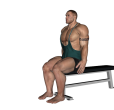 Stretch - Chair Upper Body
Stretch - Chair Upper Body
Benefits: This exercise will also work the traps and lats.
Purpose: This exercise stretches the lower back muscles.
Beginner Upper Back Shoulders Strength Flat Bench Gym Home
General Info: The muscles of the lower back straighten the spine. They work together with the abdominals to keep the spine upright. The spine plays a big role in overall health, so the lower back is one of the most important muscle groups in the body.
 Stretch - Chest Behind Head
Stretch - Chest Behind Head
Benefits: This exercise ensures that your chest muscles are ready for lifting exercises.
Purpose: This exercise loosens up and stretches the chest muscles.
Intermediate Chest Shoulders Stretching Body Only Gym
General Info: The Pecs play a big part, with the Biceps, when you lift any object, from shopping bags to dumbbells. These muscles are often injured during lifting exercises.
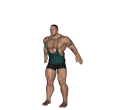 Stretch - Dynamic Back
Stretch - Dynamic Back
Benefits: This exercise isolates the upper back muscles.
Purpose: This exercise strengthens the upper back and shoulder areas.
Beginner Lats Shoulders Traps Strength Body Only Gym Home
General Info: The posterior (rear) deltoid or shoulder is one of the three distinct heads of the deltoid anatomy. It is typically used in tandem with the back muscles during upper body pulling exercises.
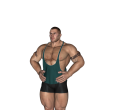 Stretch - Overhead
Stretch - Overhead
Benefits: This exercise is good after sitting at a desk or computer for any extended time. It is also good both before and after resistance exercising.
Purpose: This exercise loosens up and stretches the shoulder muscles. It also relieves tension in the chest and lats.
Intermediate Shoulders Chest Forearms Lats Triceps Stretching Body Only Gym Home
General Info: The shoulder muscles are a group of three muscles. The anterior (front) deltoid raises the arm toward the front and rotates the arm inward. The lateral (side) deltoid raises the arm to the side. The posterior (back) deltoid raises the arm toward the rear and rotates the arm outward.
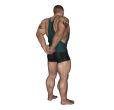 Stretch - Standing Biceps
Stretch - Standing Biceps
Benefits: This exercise helps to relax the biceps.
Purpose: This exercise focuses on working the biceps and makes an excellent warm-up before any resistance or weight training involving the upper arms.
Beginner Biceps Shoulders Stretching Body Only Gym Home
General Info: The standing biceps stretch require little time, yet can give good benefits when done regularly. It can be done almost anywhere, without special equipment. The two heads of the biceps muscles require regular movement to ensure their flexibility and mobility.
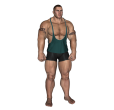 Stretch - Triceps Side
Stretch - Triceps Side
Benefits: This exercise helps to relax the triceps.
Purpose: This exercise focuses on stretching the three heads of the triceps and makes an excellent warm-up before any resistance or weight training involving the triceps.
Beginner Triceps Shoulders Stretching Body Only Gym Home
General Info: The triceps muscles are straight muscles with three heads. All three heads straighten the elbow while the long head, crossing the shoulder joint also adducts the shoulder (pulls it down from the side) and extends the shoulder (pulls it down from the front).
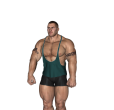 Stretch - Upward
Stretch - Upward
Benefits: This exercise tones and increases the flexibility of your shoulders.
Purpose: This exercise focuses on working the entire shoulder joint and makes an excellent warm-up before any resistance or weight training involving the shoulders.
Beginner Shoulders Lats Stretching Body Only Gym Home
General Info: Shoulder raises require little time, yet can give good benefits when done regularly. They can be done almost anywhere, without special equipment. The three heads of the deltoid muscles require regular movement to ensure their flexibility and mobility.
 Triceps Extension - Standing Low Pulley One Arm
Triceps Extension - Standing Low Pulley One Arm
Benefits: This exercise works all heads of the triceps.
Purpose: This exercise is used to target the triceps muscle to develop size, definition, strength, endurance and power.
Intermediate Triceps Shoulders Strength High Low Cable Machine Push Gym
General Info: The triceps muscle group are straight muscles with three heads. All three heads straighten the elbow while the long head, crossing the shoulder joint also adducts the shoulder (pulls it down from the side) and extends the shoulder (pulls it down from the front).
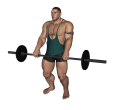 Upright Row - Barbell
Upright Row - Barbell
Benefits: The row is a highly effective compound upper-body exercise.
Purpose: The row is a good exercise for building up and strengthening the anterior (front) delts.
Intermediate Shoulders Traps Forearms Strength Barbell Pull Compound Gym
General Info: The Deltoids is a fan-shaped muscle. The Anterior (Front) Deltoid raises the arm toward the front of the body and rotates the arm inward. The Lateral (Side) Deltoid raises the arm to the side. The Posterior (Rear) Deltoid raises the arm toward the rear and rotates the arm outward.
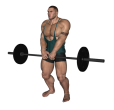 Upright Row - Barbell Close Grip
Upright Row - Barbell Close Grip
Benefits: The row is a highly effective compound upper-body exercise.
Purpose: The row is a good exercise for building up and strengthening the anterior (front) delts.
Intermediate Shoulders Traps Forearms Strength Barbell Pull Compound Gym
General Info: The Deltoids is a fan-shaped muscle. The Anterior (Front) Deltoid raises the arm toward the front of the body and rotates the arm inward. The Lateral (Side) Deltoid raises the arm to the side. The Posterior (Rear) Deltoid raises the arm toward the rear and rotates the arm outward.
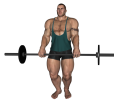 Upright Row - Barbell Narrow Stance
Upright Row - Barbell Narrow Stance
Benefits: The row is a highly effective compound upper-body exercise.
Purpose: The row is a good exercise for building up and strengthening the anterior (front) delts.
Intermediate Shoulders Traps Forearms Strength Barbell Pull Compound Gym
General Info: The Deltoids is a fan-shaped muscle. The Anterior (Front) Deltoid raises the arm toward the front of the body and rotates the arm inward. The Lateral (Side) Deltoid raises the arm to the side. The Posterior (Rear) Deltoid raises the arm toward the rear and rotates the arm outward.
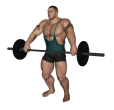 Upright Row - Barbell Wide Grip
Upright Row - Barbell Wide Grip
Benefits: The row is a highly effective compound upper-body exercise.
Purpose: The row is a good exercise for building up and strengthening the anterior (front) delts.
Intermediate Shoulders Traps Forearms Strength Barbell Pull Compound Gym
General Info: The Deltoids is a fan-shaped muscle. The Anterior (Front) Deltoid raises the arm toward the front of the body and rotates the arm inward. The Lateral (Side) Deltoid raises the arm to the side. The Posterior (Rear) Deltoid raises the arm toward the rear and rotates the arm outward.
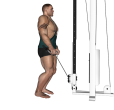 Upright Row - Cable
Upright Row - Cable
Benefits: The row is a highly effective compound upper-body exercise.
Purpose: The row is a good exercise for building up and strengthening the anterior (front) delts.
Intermediate Shoulders Traps Forearms Strength Cable Machine Pull Compound Gym
General Info: The Deltoids is a fan-shaped muscle. The Anterior (Front) Deltoid raises the arm toward the front of the body and rotates the arm inward. The Lateral (Side) Deltoid raises the arm to the side. The Posterior (Rear) Deltoid raises the arm toward the rear and rotates the arm outward.
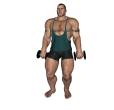 Upright Row - Dumbbell
Upright Row - Dumbbell
Benefits: The row is a highly effective compound upper-body exercise.
Purpose: The row is a good exercise for building up and strengthening the anterior (front) delts.
Intermediate Shoulders Traps Forearms Strength Dumbbell Pull Compound Gym
General Info: The Deltoids is a fan-shaped muscle. The Anterior (Front) Deltoid raises the arm toward the front of the body and rotates the arm inward. The Lateral (Side) Deltoid raises the arm to the side. The Posterior (Rear) Deltoid raises the arm toward the rear and rotates the arm outward.
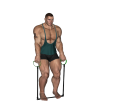 Upright Row - Exercise Band Standing
Upright Row - Exercise Band Standing
Benefits: The row is a highly effective compound upper-body exercise.
Purpose: The row is a good exercise for building up and strengthening the anterior (front) delts.
Intermediate Shoulders Traps Forearms Strength Band Pull Compound Gym
General Info: The Deltoids is a fan-shaped muscle. The Anterior (Front) Deltoid raises the arm toward the front of the body and rotates the arm inward. The Lateral (Side) Deltoid raises the arm to the side. The Posterior (Rear) Deltoid raises the arm toward the rear and rotates the arm outward.
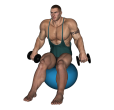 Upright Row - Fitness Ball Dumbbell
Upright Row - Fitness Ball Dumbbell
Benefits: The row is a highly effective compound upper-body exercise.
Purpose: The row is a good exercise for building up and strengthening the anterior (front) delts.
Intermediate Shoulders Traps Forearms Strength Dumbbell Fitness Ball Pull Compound Gym
General Info: The Deltoids is a fan-shaped muscle. The Anterior (Front) Deltoid raises the arm toward the front of the body and rotates the arm inward. The Lateral (Side) Deltoid raises the arm to the side. The Posterior (Rear) Deltoid raises the arm toward the rear and rotates the arm outward.
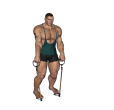 Upright Row - Resistance Tube Standing
Upright Row - Resistance Tube Standing
Benefits: The row is a highly effective compound upper-body exercise.
Purpose: The row is a good exercise for building up and strengthening the anterior (front) delts.
Intermediate Shoulders Traps Forearms Strength Resistance Tube Pull Compound Gym
General Info: The Deltoids is a fan-shaped muscle. The Anterior (Front) Deltoid raises the arm toward the front of the body and rotates the arm inward. The Lateral (Side) Deltoid raises the arm to the side. The Posterior (Rear) Deltoid raises the arm toward the rear and rotates the arm outward.
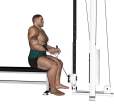 Upright Row - Seated Cable
Upright Row - Seated Cable
Benefits: The row is a highly effective compound upper-body exercise.
Purpose: The row is a good exercise for building up and strengthening the anterior (front) delts.
Intermediate Shoulders Traps Forearms Strength Cable Machine Flat Bench Pull Compound Gym
General Info: The Deltoids is a fan-shaped muscle. The Anterior (Front) Deltoid raises the arm toward the front of the body and rotates the arm inward. The Lateral (Side) Deltoid raises the arm to the side. The Posterior (Rear) Deltoid raises the arm toward the rear and rotates the arm outward.
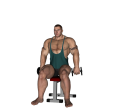 Upright Row - Seated Dumbbell
Upright Row - Seated Dumbbell
Benefits: The row is a highly effective compound upper-body exercise.
Purpose: The row is a good exercise for building up and strengthening the anterior (front) delts.
Intermediate Shoulders Traps Forearms Strength Dumbbell Flat Bench Pull Compound Gym
General Info: The Deltoids is a fan-shaped muscle. The Anterior (Front) Deltoid raises the arm toward the front of the body and rotates the arm inward. The Lateral (Side) Deltoid raises the arm to the side. The Posterior (Rear) Deltoid raises the arm toward the rear and rotates the arm outward.
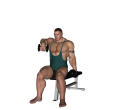 Upright Row - Seated Dumbbell Alternate
Upright Row - Seated Dumbbell Alternate
Benefits: The row is a highly effective compound upper-body exercise.
Purpose: The row is a good exercise for building up and strengthening the anterior (front) delts.
Intermediate Shoulders Traps Forearms Strength Dumbbell Flat Bench Pull Compound Gym
General Info: The Deltoids is a fan-shaped muscle. The Anterior (Front) Deltoid raises the arm toward the front of the body and rotates the arm inward. The Lateral (Side) Deltoid raises the arm to the side. The Posterior (Rear) Deltoid raises the arm toward the rear and rotates the arm outward.
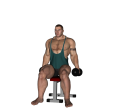 Upright Row - Seated Dumbbell Narrow Stance
Upright Row - Seated Dumbbell Narrow Stance
Benefits: The row is a highly effective compound upper-body exercise.
Purpose: The row is a good exercise for building up and strengthening the anterior (front) delts.
Intermediate Shoulders Traps Forearms Strength Dumbbell Flat Bench Pull Compound Gym
General Info: The Deltoids is a fan-shaped muscle. The Anterior (Front) Deltoid raises the arm toward the front of the body and rotates the arm inward. The Lateral (Side) Deltoid raises the arm to the side. The Posterior (Rear) Deltoid raises the arm toward the rear and rotates the arm outward.
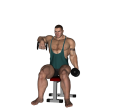 Upright Row - Seated Dumbbell Narrow Stance Alternate
Upright Row - Seated Dumbbell Narrow Stance Alternate
Benefits: The row is a highly effective compound upper-body exercise.
Purpose: The row is a good exercise for building up and strengthening the anterior (front) delts.
Intermediate Shoulders Traps Forearms Strength Dumbbell Flat Bench Pull Compound Gym
General Info: The Deltoids is a fan-shaped muscle. The Anterior (Front) Deltoid raises the arm toward the front of the body and rotates the arm inward. The Lateral (Side) Deltoid raises the arm to the side. The Posterior (Rear) Deltoid raises the arm toward the rear and rotates the arm outward.
 Upright Row - Seated Single Narrow Stance Alternate
Upright Row - Seated Single Narrow Stance Alternate
Benefits: The row is a highly effective compound upper-body exercise.
Purpose: The row is a good exercise for building up and strengthening the anterior (front) delts.
Intermediate Shoulders Traps Forearms Strength Dumbbell Flat Bench Pull Compound Gym
General Info: The Deltoids is a fan-shaped muscle. The Anterior (Front) Deltoid raises the arm toward the front of the body and rotates the arm inward. The Lateral (Side) Deltoid raises the arm to the side. The Posterior (Rear) Deltoid raises the arm toward the rear and rotates the arm outward.
 Upright Row - Seated Water Bottle
Upright Row - Seated Water Bottle
Benefits: The row is a highly effective compound upper-body exercise.
Purpose: The row is a good exercise for building up and strengthening the anterior (front) delts.
Intermediate Shoulders Traps Forearms Strength Water Bottle Chair Pull Compound Home
General Info: The Deltoids is a fan-shaped muscle. The Anterior (Front) Deltoid raises the arm toward the front of the body and rotates the arm inward. The Lateral (Side) Deltoid raises the arm to the side. The Posterior (Rear) Deltoid raises the arm toward the rear and rotates the arm outward.
 Upright Row - Seated Water Bottle Alternate
Upright Row - Seated Water Bottle Alternate
Benefits: The row is a highly effective compound upper-body exercise.
Purpose: The row is a good exercise for building up and strengthening the anterior (front) delts.
Intermediate Shoulders Traps Forearms Strength Water Bottle Chair Pull Compound Home
General Info: The Deltoids is a fan-shaped muscle. The Anterior (Front) Deltoid raises the arm toward the front of the body and rotates the arm inward. The Lateral (Side) Deltoid raises the arm to the side. The Posterior (Rear) Deltoid raises the arm toward the rear and rotates the arm outward.
 Upright Row - Seated Water Bottle Narrow
Upright Row - Seated Water Bottle Narrow
Benefits: The row is a highly effective compound upper-body exercise.
Purpose: The row is a good exercise for building up and strengthening the anterior (front) delts.
Intermediate Shoulders Traps Forearms Strength Water Bottle Chair Pull Compound Home
General Info: The Deltoids is a fan-shaped muscle. The Anterior (Front) Deltoid raises the arm toward the front of the body and rotates the arm inward. The Lateral (Side) Deltoid raises the arm to the side. The Posterior (Rear) Deltoid raises the arm toward the rear and rotates the arm outward.
 Upright Row - Seated Water Bottle Narrow Alternate
Upright Row - Seated Water Bottle Narrow Alternate
Benefits: The row is a highly effective compound upper-body exercise.
Purpose: The row is a good exercise for building up and strengthening the anterior (front) delts.
Intermediate Shoulders Traps Forearms Strength Water Bottle Chair Pull Compound Home
General Info: The Deltoids is a fan-shaped muscle. The Anterior (Front) Deltoid raises the arm toward the front of the body and rotates the arm inward. The Lateral (Side) Deltoid raises the arm to the side. The Posterior (Rear) Deltoid raises the arm toward the rear and rotates the arm outward.
 Upright Row - Single Dumbbell
Upright Row - Single Dumbbell
Benefits: The row is a highly effective compound upper-body exercise.
Purpose: The row is a good exercise for building up and strengthening the anterior (front) delts.
Intermediate Shoulders Traps Forearms Strength Dumbbell Pull Compound Gym
General Info: The Deltoids is a fan-shaped muscle. The Anterior (Front) Deltoid raises the arm toward the front of the body and rotates the arm inward. The Lateral (Side) Deltoid raises the arm to the side. The Posterior (Rear) Deltoid raises the arm toward the rear and rotates the arm outward.
 Upright Row - Single Seated Dumbbell
Upright Row - Single Seated Dumbbell
Benefits: The row is a highly effective compound upper-body exercise.
Purpose: The row is a good exercise for building up and strengthening the anterior (front) delts.
Intermediate Shoulders Traps Forearms Strength Dumbbell Flat Bench Pull Compound Gym
General Info: The Deltoids is a fan-shaped muscle. The Anterior (Front) Deltoid raises the arm toward the front of the body and rotates the arm inward. The Lateral (Side) Deltoid raises the arm to the side. The Posterior (Rear) Deltoid raises the arm toward the rear and rotates the arm outward.
 Upright Row - Single Seated Water Bottle
Upright Row - Single Seated Water Bottle
Benefits: The row is a highly effective compound upper-body exercise.
Purpose: The row is a good exercise for building up and strengthening the anterior (front) delts.
Intermediate Shoulders Traps Forearms Strength Water Bottle Chair Pull Compound Home
General Info: The Deltoids is a fan-shaped muscle. The Anterior (Front) Deltoid raises the arm toward the front of the body and rotates the arm inward. The Lateral (Side) Deltoid raises the arm to the side. The Posterior (Rear) Deltoid raises the arm toward the rear and rotates the arm outward.
 Upright Row - Single Water Bottle
Upright Row - Single Water Bottle
Benefits: The row is a highly effective compound upper-body exercise.
Purpose: The row is a good exercise for building up and strengthening the anterior (front) delts.
Intermediate Shoulders Traps Forearms Strength Water Bottle Pull Compound Home
General Info: The Deltoids is a fan-shaped muscle. The Anterior (Front) Deltoid raises the arm toward the front of the body and rotates the arm inward. The Lateral (Side) Deltoid raises the arm to the side. The Posterior (Rear) Deltoid raises the arm toward the rear and rotates the arm outward.
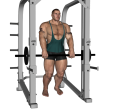 Upright Row - Smith Machine
Upright Row - Smith Machine
Benefits: The row is a highly effective compound upper-body exercise.
Purpose: The row is a good exercise for building up and strengthening the anterior (front) delts.
Intermediate Shoulders Traps Forearms Strength Smith Machine Pull Compound Gym
General Info: The Deltoids is a fan-shaped muscle. The Anterior (Front) Deltoid raises the arm toward the front of the body and rotates the arm inward. The Lateral (Side) Deltoid raises the arm to the side. The Posterior (Rear) Deltoid raises the arm toward the rear and rotates the arm outward.
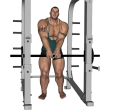 Upright Row - Smith Machine Close Grip
Upright Row - Smith Machine Close Grip
Benefits: The row is a highly effective compound upper-body exercise.
Purpose: The row is a good exercise for building up and strengthening the anterior (front) delts.
Intermediate Shoulders Traps Forearms Strength Smith Machine Pull Compound Gym
General Info: The Deltoids is a fan-shaped muscle. The Anterior (Front) Deltoid raises the arm toward the front of the body and rotates the arm inward. The Lateral (Side) Deltoid raises the arm to the side. The Posterior (Rear) Deltoid raises the arm toward the rear and rotates the arm outward.
 Upright Row - Smith Machine Close Grip Kneeling
Upright Row - Smith Machine Close Grip Kneeling
Benefits: The row is a highly effective compound upper-body exercise.
Purpose: The row is a good exercise for building up and strengthening the anterior (front) delts.
Intermediate Shoulders Traps Forearms Strength Smith Machine Pull Compound Gym
General Info: The Deltoids is a fan-shaped muscle. The Anterior (Front) Deltoid raises the arm toward the front of the body and rotates the arm inward. The Lateral (Side) Deltoid raises the arm to the side. The Posterior (Rear) Deltoid raises the arm toward the rear and rotates the arm outward.
 Upright Row - Smith Machine Kneeling Upright
Upright Row - Smith Machine Kneeling Upright
Benefits: The row is a highly effective compound upper-body exercise.
Purpose: The row is a good exercise for building up and strengthening the anterior (front) delts.
Intermediate Shoulders Traps Forearms Strength Smith Machine Pull Compound Gym
General Info: The Deltoids is a fan-shaped muscle. The Anterior (Front) Deltoid raises the arm toward the front of the body and rotates the arm inward. The Lateral (Side) Deltoid raises the arm to the side. The Posterior (Rear) Deltoid raises the arm toward the rear and rotates the arm outward.
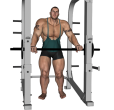 Upright Row - Smith Machine Wide Grip
Upright Row - Smith Machine Wide Grip
Benefits: The row is a highly effective compound upper-body exercise.
Purpose: The row is a good exercise for building up and strengthening the anterior (front) delts.
Intermediate Shoulders Traps Forearms Strength Smith Machine Pull Compound Gym
General Info: The Deltoids is a fan-shaped muscle. The Anterior (Front) Deltoid raises the arm toward the front of the body and rotates the arm inward. The Lateral (Side) Deltoid raises the arm to the side. The Posterior (Rear) Deltoid raises the arm toward the rear and rotates the arm outward.
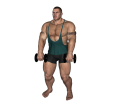 Upright Row - Standing Dumbbell
Upright Row - Standing Dumbbell
Benefits: The row is a highly effective compound upper-body exercise.
Purpose: The row is a good exercise for building up and strengthening the anterior (front) delts.
Intermediate Shoulders Traps Forearms Strength Dumbbell Pull Compound Gym
General Info: The Deltoids is a fan-shaped muscle. The Anterior (Front) Deltoid raises the arm toward the front of the body and rotates the arm inward. The Lateral (Side) Deltoid raises the arm to the side. The Posterior (Rear) Deltoid raises the arm toward the rear and rotates the arm outward.
 Upright Row - Water Bottle
Upright Row - Water Bottle
Benefits: The row is a highly effective compound upper-body exercise.
Purpose: The row is a good exercise for building up and strengthening the anterior (front) delts.
Intermediate Shoulders Traps Forearms Strength Water Bottle Pull Compound Home
General Info: The Deltoids is a fan-shaped muscle. The Anterior (Front) Deltoid raises the arm toward the front of the body and rotates the arm inward. The Lateral (Side) Deltoid raises the arm to the side. The Posterior (Rear) Deltoid raises the arm toward the rear and rotates the arm outward.
 Upright Row - With Chains
Upright Row - With Chains
Benefits: This exercise is done with the addition of chains. The primary function of chains is to accommodate resistance. Chains are also a great means of weight loading (adding more weight to an exercise). Chains are also a great way for working the stabilizers.
Purpose: Benefits The row is a highly effective compound upper-body exercise.
Intermediate Shoulders Traps Forearms Strength Chains Pull Compound Gym
General Info: The Deltoids is a fan-shaped muscle. The Anterior (Front) Deltoid raises the arm toward the front of the body and rotates the arm inward. The Lateral (Side) Deltoid raises the arm to the side. The Posterior (Rear) Deltoid raises the arm toward the rear and rotates the arm outward.
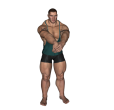 Wrist Pull - Side
Wrist Pull - Side
Benefits: This exercise helps to relax the shoulder.
Purpose: This exercise focuses on working the front shoulder joint and makes an excellent warm-up before any resistance or weigh training involving the shoulders.
Beginner Shoulders Lats Stretching Body Only Gym Home
General Info: The side wrist pull require little time, yet can give good benefits when done regularly. It can be done almost anywhere, without special equipment. The three heads of the deltoid muscles require regular movement to ensure their flexibility and mobility.
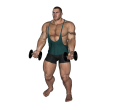 Zottman Curl - Basic
Zottman Curl - Basic
Benefits: This exercise works both heads of the biceps as well as muscles involved in rotating the forearm.
Purpose: This exercise is used to target the biceps muscle to develop size, definition, strength, endurance and power.
Beginner Biceps Forearms Shoulders Strength Dumbbell Pull Gym
General Info: The biceps is a straight muscle with two heads. The long head of the biceps crosses both the elbow and the shoulder joint. It bends the elbow and raises the arm forward at the shoulder. The short head crosses the elbow joint and, in conjunction with the brachioradialis, supinates the hand.
 Zottman Curl - Basic Water Bottle
Zottman Curl - Basic Water Bottle
Benefits: This exercise works both heads of the biceps with a heavier weight than can typically be done with dumbbells.
Purpose: This exercise is used to target the biceps muscle to develop size, definition, strength, endurance and power.
Beginner Biceps Forearms Shoulders Strength Water Bottle Pull Home
General Info: The biceps is a straight muscle with two heads. The long head of the biceps crosses both the elbow and the shoulder joint. It bends the elbow and raises the arm forward at the shoulder. The short head crosses the elbow joint and, in conjunction with the brachioradialis, supinates the hand.
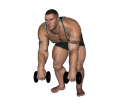 Zottman Curl - Bent Over Dumbbell
Zottman Curl - Bent Over Dumbbell
Benefits: This exercise does a good job of placing maximum tension on the biceps in the fully contracted position and also supinates the forearm.
Purpose: This exercise works the biceps muscles but focuses also on the brachioradialis (a muscle that crosses the elbow joint and assists in rotating the forearm).
Beginner Biceps Forearms Shoulders Strength Dumbbell Pull Gym
General Info: The biceps is a straight muscle which has two heads. The long head crosses both the elbow and the shoulder joints. It bends the arm at the elbow and raises the arm forward at the shoulder. The short head crosses the elbow joint and, in conjunction with the brachioradialis, supinates the hand.
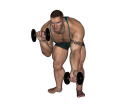 Zottman Curl - Bent Over Dumbbell Alternate
Zottman Curl - Bent Over Dumbbell Alternate
Benefits: This exercise does a good job of placing maximum tension on the biceps in the fully contracted position and also supinates the forearm.
Purpose: This exercise works the biceps muscles but focuses also on the brachioradialis (a muscle that crosses the elbow joint and assists in rotating the forearm).
Beginner Biceps Forearms Shoulders Strength Dumbbell Pull Gym
General Info: The biceps is a straight muscle which has two heads. The long head crosses both the elbow and the shoulder joints. It bends the arm at the elbow and raises the arm forward at the shoulder. The short head crosses the elbow joint and, in conjunction with the brachioradialis, supinates the hand.
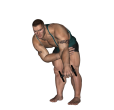 Zottman Curl - Bent Over Dumbbell Single
Zottman Curl - Bent Over Dumbbell Single
Benefits: This exercise does a good job of placing maximum tension on the biceps in the fully contracted position and also supinates the forearm.
Purpose: This exercise works the biceps muscles but focuses also on the brachioradialis (a muscle that crosses the elbow joint and assists in rotating the forearm).
Beginner Biceps Forearms Shoulders Strength Dumbbell Pull Gym
General Info: The biceps is a straight muscle which has two heads. The long head crosses both the elbow and the shoulder joints. It bends the arm at the elbow and raises the arm forward at the shoulder. The short head crosses the elbow joint and, in conjunction with the brachioradialis, supinates the hand.
 Zottman Curl - Bent Over Water Bottle
Zottman Curl - Bent Over Water Bottle
Benefits: This exercise does a good job of placing maximum tension on the biceps in the fully contracted position and also supinates the forearm..
Purpose: This exercise works the biceps muscles but focuses also on the brachioradialis (a muscle that crosses the elbow joint and assists in rotating the forearm).
Beginner Biceps Forearms Shoulders Strength Water Bottle Pull Home
General Info: The biceps is a straight muscle which has two heads. The long head crosses both the elbow and the shoulder joints. It bends the arm at the elbow and raises the arm forward at the shoulder. The short head crosses the elbow joint and, in conjunction with the brachioradialis, supinates the hand.
 Zottman Curl - Bent Over Water Bottle Alternate
Zottman Curl - Bent Over Water Bottle Alternate
Benefits: This exercise does a good job of placing maximum tension on the biceps in the fully contracted position and also supinates the forearm..
Purpose: This exercise works the biceps muscles but focuses also on the brachioradialis (a muscle that crosses the elbow joint and assists in rotating the forearm).
Beginner Biceps Forearms Shoulders Strength Water Bottle Pull Home
General Info: The biceps is a straight muscle which has two heads. The long head crosses both the elbow and the shoulder joints. It bends the arm at the elbow and raises the arm forward at the shoulder. The short head crosses the elbow joint and, in conjunction with the brachioradialis, supinates the hand.
 Zottman Curl - Bent Over Water Bottle Single
Zottman Curl - Bent Over Water Bottle Single
Benefits: This exercise does a good job of placing maximum tension on the biceps in the fully contracted position and also supinates the forearm..
Purpose: This exercise works the biceps muscles but focuses also on the brachioradialis (a muscle that crosses the elbow joint and assists in rotating the forearm).
Beginner Biceps Forearms Shoulders Strength Water Bottle Pull Home
General Info: The biceps is a straight muscle which has two heads. The long head crosses both the elbow and the shoulder joints. It bends the arm at the elbow and raises the arm forward at the shoulder. The short head crosses the elbow joint and, in conjunction with the brachioradialis, supinates the hand.
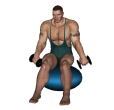 Zottman Curl - Fitness Ball
Zottman Curl - Fitness Ball
Benefits: This exercise isolates the biceps so that momentum does not come into play. The rotation in this exercise works the forearm muscles.
Purpose: This exercise strengthens the biceps.
Beginner Biceps Forearms Shoulders Traps Strength Dumbbell Fitness Ball Pull Gym
General Info: The biceps muscle is a straight muscle with 2 heads. The long head crosses both the elbow and shoulder joints and bends the elbow and raises the arm forward at the shoulder. The short head of the biceps crosses the elbow joint and, in conjunction with the brachioradialis, supinates the hand.
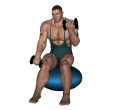 Zottman Curl - Fitness Ball Dumbbell Alternate
Zottman Curl - Fitness Ball Dumbbell Alternate
Benefits: This exercise works both heads of the biceps. The rotation in this exercise works the forearm muscles.
Purpose: This exercise is used to target the biceps muscle to develop size, definition, strength, endurance and power.
Beginner Biceps Forearms Shoulders Strength Dumbbell Fitness Ball Pull Gym
General Info: The biceps is a straight muscle with two heads. The long head of the biceps crosses both the elbow and the shoulder joint. It bends the elbow and raises the arm forward at the shoulder. The short head crosses the elbow joint and, in conjunction with the brachioradialis, supinates the hand.
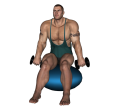 Zottman Curl - Fitness Ball Dumbbell Narrow
Zottman Curl - Fitness Ball Dumbbell Narrow
Benefits: This exercise isolates the biceps so that momentum does not come into play.
Purpose: This exercise strengthens the biceps.
Beginner Biceps Forearms Shoulders Traps Strength Dumbbell Fitness Ball Pull Gym
General Info: The biceps muscle is a straight muscle with 2 heads. The long head crosses both the elbow and shoulder joints and bends the elbow and raises the arm forward at the shoulder. The short head of the biceps crosses the elbow joint and, in conjunction with the brachioradialis, supinates the hand.
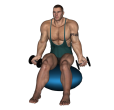 Zottman Curl - Fitness Ball Dumbbell Reverse
Zottman Curl - Fitness Ball Dumbbell Reverse
Benefits: This exercise isolates the biceps so that momentum does not come into play. The rotation in this exercise works the forearm muscles.
Purpose: This exercise strengthens the biceps.
Beginner Biceps Forearms Shoulders Traps Strength Dumbbell Fitness Ball Pull Gym
General Info: The biceps muscle is a straight muscle with 2 heads. The long head crosses both the elbow and shoulder joints and bends the elbow and raises the arm forward at the shoulder. The short head of the biceps crosses the elbow joint and, in conjunction with the brachioradialis, supinates the hand..
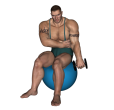 Zottman Curl - Fitness Ball Single
Zottman Curl - Fitness Ball Single
Benefits: This exercise works both heads of the biceps with a heavier weight than can typically be done with dumbbells.
Purpose: This exercise is used to target the biceps muscle to develop size, definition, strength, endurance and power.
Beginner Biceps Forearms Shoulders Strength Dumbbell Fitness Ball Pull Gym
General Info: The biceps is a straight muscle with two heads. The long head of the biceps crosses both the elbow and the shoulder joint. It bends the elbow and raises the arm forward at the shoulder. The short head crosses the elbow joint and, in conjunction with the brachioradialis, supinates the hand.
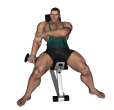 Zottman Curl - Incline Single
Zottman Curl - Incline Single
Benefits: This exercise works both heads of the biceps along with the brachioradialis muscle.
Purpose: This exercise is used to target the biceps muscle to develop size, definition, strength, endurance and power.
Beginner Biceps Forearms Shoulders Strength Dumbbell Pull Gym
General Info: The biceps is a straight muscle with two heads. The long head of the biceps crosses both the elbow and the shoulder joint. It bends the elbow and raises the arm forward at the shoulder. The short head crosses the elbow joint and, in conjunction with the brachioradialis, supinates the hand.
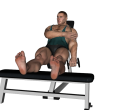 Zottman Curl - Incline Single Feet Up
Zottman Curl - Incline Single Feet Up
Benefits: This exercise works both heads of the biceps along with the brachioradialis muscle.
Purpose: This exercise is used to target the biceps muscle to develop size, definition, strength, endurance and power.
Beginner Biceps Forearms Shoulders Strength Dumbbell Incline Bench Flat Bench Pull Gym
General Info: The biceps is a straight muscle with two heads. The long head of the biceps crosses both the elbow and the shoulder joint. It bends the elbow and raises the arm forward at the shoulder. The short head crosses the elbow joint and, in conjunction with the brachioradialis, supinates the hand.
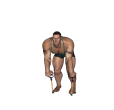 Zottman Curl - Resistance Bent Over Alternate
Zottman Curl - Resistance Bent Over Alternate
Benefits: This exercise does a good job of placing maximum tension on the biceps in the fully contracted position and also supinates the forearm.
Purpose: This exercise works the biceps muscles but focuses also on the brachioradialis (a muscle that crosses the elbow joint and assists in rotating the forearm).
Beginner Biceps Forearms Shoulders Strength Resistance Tube Pull Gym
General Info: The biceps is a straight muscle which has two heads. The long head crosses both the elbow and the shoulder joints. It bends the arm at the elbow and raises the arm forward at the shoulder. The short head crosses the elbow joint and, in conjunction with the brachioradialis, supinates the hand.
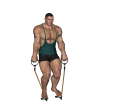 Zottman Curl - Resistance Standing Alternate
Zottman Curl - Resistance Standing Alternate
Benefits: This exercise does a good job of placing maximum tension on the biceps in the fully contracted position and also supinates the forearm.
Purpose: This exercise works the biceps muscles but focuses also on the brachioradialis (a muscle that crosses the elbow joint and assists in rotating the forearm).
Beginner Biceps Forearms Shoulders Strength Resistance Tube Pull Gym
General Info: The biceps is a straight muscle with two heads. The long head of the biceps crosses both the elbow and the shoulder joint. It bends the elbow and raises the arm forward at the shoulder. The short head crosses the elbow joint and, in conjunction with the brachioradialis, supinates the hand.
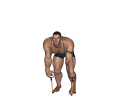 Zottman Curl - Resistance Tube Bent Over
Zottman Curl - Resistance Tube Bent Over
Benefits: This exercise does a good job of placing maximum tension on the biceps in the fully contracted position and also supinates the forearm.
Purpose: This exercise works the biceps muscles but focuses also on the brachioradialis (a muscle that crosses the elbow joint and assists in rotating the forearm).
Beginner Biceps Forearms Shoulders Strength Resistance Tube Pull Gym
General Info: The biceps is a straight muscle which has two heads. The long head crosses both the elbow and the shoulder joints. It bends the arm at the elbow and raises the arm forward at the shoulder. The short head crosses the elbow joint and, in conjunction with the brachioradialis, supinates the hand.
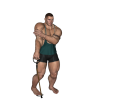 Zottman Curl - Resistance Tube Single
Zottman Curl - Resistance Tube Single
Benefits: This exercise does a good job of placing maximum tension on the biceps in the fully contracted position and also supinates the forearm.
Purpose: This exercise works the biceps muscles but focuses also on the brachioradialis (a muscle that crosses the elbow joint and assists in rotating the forearm).
Beginner Biceps Forearms Shoulders Strength Resistance Tube Pull Gym
General Info: The biceps is a straight muscle with two heads. The long head of the biceps crosses both the elbow and the shoulder joint. It bends the elbow and raises the arm forward at the shoulder. The short head crosses the elbow joint and, in conjunction with the brachioradialis, supinates the hand.
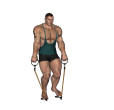 Zottman Curl - Resistance Tube Standing
Zottman Curl - Resistance Tube Standing
Benefits: This exercise does a good job of placing maximum tension on the biceps in the fully contracted position and also supinates the forearm.
Purpose: This exercise works the biceps muscles but focuses also on the brachioradialis (a muscle that crosses the elbow joint and assists in rotating the forearm).
Beginner Biceps Forearms Shoulders Strength Resistance Tube Pull Gym
General Info: The biceps is a straight muscle with two heads. The long head of the biceps crosses both the elbow and the shoulder joint. It bends the elbow and raises the arm forward at the shoulder. The short head crosses the elbow joint and, in conjunction with the brachioradialis, supinates the hand.
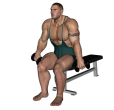 Zottman Curl - Seated Dumbbell
Zottman Curl - Seated Dumbbell
Benefits: This exercise works both heads of the biceps as well as muscles involved in rotating the forearm.
Purpose: This exercise strengthens the biceps.
Beginner Biceps Forearms Shoulders Traps Strength Dumbbell Flat Bench Pull Gym
General Info: The biceps muscle is a straight muscle with 2 heads. The long head crosses both the elbow and shoulder joints and bends the elbow and raises the arm forward at the shoulder. The short head of the biceps crosses the elbow joint and, in conjunction with the brachioradialis, supinates the hand.
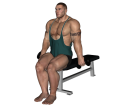 Zottman Curl - Seated Dumbbell Narrow Stance
Zottman Curl - Seated Dumbbell Narrow Stance
Benefits: This exercise does a good job of placing maximum tension on the biceps in the fully contracted position and also supinates the forearm.
Purpose: This exercise works the biceps muscles but focuses also on the brachioradialis (a muscle that crosses the elbow joint and assists in rotating the forearm).
Beginner Biceps Forearms Shoulders Traps Strength Dumbbell Flat Bench Pull Gym
General Info: The biceps muscle is a straight muscle with 2 heads. The long head crosses both the elbow and shoulder joints and bends the elbow and raises the arm forward at the shoulder. The short head of the biceps crosses the elbow joint and, in conjunction with the brachioradialis, supinates the hand.
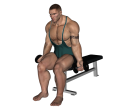 Zottman Curl - Seated Dumbbell Reverse
Zottman Curl - Seated Dumbbell Reverse
Benefits: This exercise does a good job of placing maximum tension on the biceps in the fully contracted position and also supinates the forearm.
Purpose: This exercise works the biceps muscles but focuses also on the brachioradialis (a muscle that crosses the elbow joint and assists in rotating the forearm).
Beginner Biceps Forearms Shoulders Traps Strength Dumbbell Flat Bench Pull Gym
General Info: The biceps muscle is a straight muscle with 2 heads. The long head crosses both the elbow and shoulder joints and bends the elbow and raises the arm forward at the shoulder. The short head of the biceps crosses the elbow joint and, in conjunction with the brachioradialis, supinates the hand.
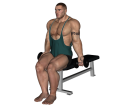 Zottman Curl - Seated Dumbbell Reverse Narrow
Zottman Curl - Seated Dumbbell Reverse Narrow
Benefits: This exercise works both heads of the biceps as well as muscles involved in rotating the forearm.
Purpose: This exercise strengthens the biceps.
Beginner Biceps Forearms Shoulders Traps Strength Dumbbell Flat Bench Pull Gym
General Info: The biceps muscle is a straight muscle with 2 heads. The long head crosses both the elbow and shoulder joints and bends the elbow and raises the arm forward at the shoulder. The short head of the biceps crosses the elbow joint and, in conjunction with the brachioradialis, supinates the hand..
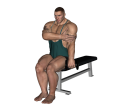 Zottman Curl - Seated Dumbbell Single Narrow
Zottman Curl - Seated Dumbbell Single Narrow
Benefits: This exercise does a good job of placing maximum tension on the biceps in the fully contracted position and also supinates the forearm.
Purpose: This exercise works the biceps muscles but focuses also on the brachioradialis (a muscle that crosses the elbow joint and assists in rotating the forearm).
Beginner Biceps Forearms Shoulders Strength Dumbbell Flat Bench Pull Gym
General Info: The biceps is a straight muscle with two heads. The long head of the biceps crosses both the elbow and the shoulder joint. It bends the elbow and raises the arm forward at the shoulder. The short head crosses the elbow joint and, in conjunction with the brachioradialis, supinates the hand.
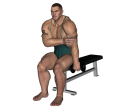 Zottman Curl - Seated Single Dumbbell
Zottman Curl - Seated Single Dumbbell
Benefits: This exercise does a good job of placing maximum tension on the biceps in the fully contracted position and also supinates the forearm.
Purpose: This exercise works the biceps muscles but focuses also on the brachioradialis (a muscle that crosses the elbow joint and assists in rotating the forearm).
Beginner Biceps Forearms Shoulders Strength Dumbbell Flat Bench Pull Gym
General Info: The biceps is a straight muscle with two heads. The long head of the biceps crosses both the elbow and the shoulder joint. It bends the elbow and raises the arm forward at the shoulder. The short head crosses the elbow joint and, in conjunction with the brachioradialis, supinates the hand.
 Zottman Curl - Seated Water Bottle
Zottman Curl - Seated Water Bottle
Benefits: This exercise isolates the biceps so that momentum does not come into play.
Purpose: This exercise strengthens the biceps.
Beginner Biceps Forearms Shoulders Traps Strength Water Bottle Chair Pull Home
General Info: The biceps muscle is a straight muscle with 2 heads. The long head crosses both the elbow and shoulder joints and bends the elbow and raises the arm forward at the shoulder. The short head of the biceps crosses the elbow joint and, in conjunction with the brachioradialis, supinates the hand.
 Zottman Curl - Seated Water Bottle Narrow Stance
Zottman Curl - Seated Water Bottle Narrow Stance
Benefits: This exercise isolates the biceps so that momentum does not come into play.
Purpose: This exercise strengthens the biceps.
Beginner Biceps Forearms Shoulders Traps Strength Water Bottle Chair Pull Home
General Info: The biceps muscle is a straight muscle with 2 heads. The long head crosses both the elbow and shoulder joints and bends the elbow and raises the arm forward at the shoulder. The short head of the biceps crosses the elbow joint and, in conjunction with the brachioradialis, supinates the hand.
 Zottman Curl - Seated Water Bottle Reverse
Zottman Curl - Seated Water Bottle Reverse
Benefits: This exercise isolates the biceps so that momentum does not come into play.
Purpose: This exercise strengthens the biceps.
Beginner Biceps Forearms Shoulders Traps Strength Water Bottle Chair Pull Home
General Info: The biceps muscle is a straight muscle with 2 heads. The long head crosses both the elbow and shoulder joints and bends the elbow and raises the arm forward at the shoulder. The short head of the biceps crosses the elbow joint and, in conjunction with the brachioradialis, supinates the hand.
 Zottman Curl - Seated Water Bottle Reverse Narrow
Zottman Curl - Seated Water Bottle Reverse Narrow
Benefits: This exercise isolates the biceps so that momentum does not come into play.
Purpose: This exercise strengthens the biceps.
Beginner Biceps Forearms Shoulders Traps Strength Water Bottle Chair Pull Home
General Info: The biceps muscle is a straight muscle with 2 heads. The long head crosses both the elbow and shoulder joints and bends the elbow and raises the arm forward at the shoulder. The short head of the biceps crosses the elbow joint and, in conjunction with the brachioradialis, supinates the hand.
 Zottman Curl - Seated Water Bottle Single Narrow
Zottman Curl - Seated Water Bottle Single Narrow
Benefits: This exercise works both heads of the biceps with a heavier weight than can typically be done with dumbbells.
Purpose: This exercise is used to target the biceps muscle to develop size, definition, strength, endurance and power.
Beginner Biceps Forearms Shoulders Strength Water Bottle Chair Pull Home
General Info: The biceps is a straight muscle with two heads. The long head of the biceps crosses both the elbow and the shoulder joint. It bends the elbow and raises the arm forward at the shoulder. The short head crosses the elbow joint and, in conjunction with the brachioradialis, supinates the hand.
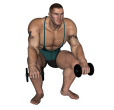 Zottman Curl - Squat Dumbbell
Zottman Curl - Squat Dumbbell
Benefits: This exercise isolates the biceps so that momentum does not come into play.
Purpose: This exercise strengthens the biceps.
Beginner Biceps Forearms Shoulders Traps Strength Dumbbell Pull Gym
General Info: The biceps muscle is a straight muscle with 2 heads. The long head crosses both the elbow and shoulder joints and bends the elbow and raises the arm forward at the shoulder. The short head of the biceps crosses the elbow joint and, in conjunction with the brachioradialis, supinates the hand.
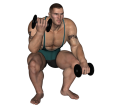 Zottman Curl - Squat Dumbbell Alternate
Zottman Curl - Squat Dumbbell Alternate
Benefits: This exercise isolates the biceps so that momentum does not come into play.
Purpose: This exercise strengthens the biceps.
Beginner Biceps Forearms Shoulders Traps Strength Dumbbell Pull Gym
General Info: The biceps muscle is a straight muscle with 2 heads. The long head crosses both the elbow and shoulder joints and bends the elbow and raises the arm forward at the shoulder. The short head of the biceps crosses the elbow joint and, in conjunction with the brachioradialis, supinates the hand.
 Zottman Curl - Squat Dumbbell Single
Zottman Curl - Squat Dumbbell Single
Benefits: This exercise isolates the biceps so that momentum does not come into play.
Purpose: This exercise strengthens the biceps.
Beginner Biceps Forearms Shoulders Traps Strength Dumbbell Pull Gym
General Info: The biceps muscle is a straight muscle with 2 heads. The long head crosses both the elbow and shoulder joints and bends the elbow and raises the arm forward at the shoulder. The short head of the biceps crosses the elbow joint and, in conjunction with the brachioradialis, supinates the hand.
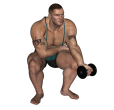 Zottman Curl - Squat Dumbbell Single Variation
Zottman Curl - Squat Dumbbell Single Variation
Benefits: This exercise isolates the biceps so that momentum does not come into play.
Purpose: This exercise strengthens the biceps.
Beginner Biceps Forearms Shoulders Traps Strength Dumbbell Pull Gym
General Info: The biceps muscle is a straight muscle with 2 heads. The long head crosses both the elbow and shoulder joints and bends the elbow and raises the arm forward at the shoulder. The short head of the biceps crosses the elbow joint and, in conjunction with the brachioradialis, supinates the hand.
 Zottman Curl - Squat Water Bottle
Zottman Curl - Squat Water Bottle
Benefits: This exercise isolates the biceps so that momentum does not come into play.
Purpose: This exercise strengthens the biceps.
Beginner Biceps Forearms Shoulders Traps Strength Water Bottle Pull Home
General Info: The biceps muscle is a straight muscle with 2 heads. The long head crosses both the elbow and shoulder joints and bends the elbow and raises the arm forward at the shoulder. The short head of the biceps crosses the elbow joint and, in conjunction with the brachioradialis, supinates the hand.
 Zottman Curl - Squat Water Bottle Alternate
Zottman Curl - Squat Water Bottle Alternate
Benefits: This exercise isolates the biceps so that momentum does not come into play.
Purpose: This exercise strengthens the biceps.
Beginner Biceps Forearms Shoulders Traps Strength Water Bottle Pull Home
General Info: The biceps muscle is a straight muscle with 2 heads. The long head crosses both the elbow and shoulder joints and bends the elbow and raises the arm forward at the shoulder. The short head of the biceps crosses the elbow joint and, in conjunction with the brachioradialis, supinates the hand.
 Zottman Curl - Squat Water Bottle Single
Zottman Curl - Squat Water Bottle Single
Benefits: This exercise isolates the biceps so that momentum does not come into play.
Purpose: This exercise strengthens the biceps.
Beginner Biceps Forearms Shoulders Traps Strength Water Bottle Pull Home
General Info: The biceps muscle is a straight muscle with 2 heads. The long head crosses both the elbow and shoulder joints and bends the elbow and raises the arm forward at the shoulder. The short head of the biceps crosses the elbow joint and, in conjunction with the brachioradialis, supinates the hand.
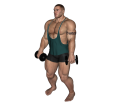 Zottman Curl - Standing Dumbbell
Zottman Curl - Standing Dumbbell
Benefits: This exercise does a good job of placing maximum tension on the biceps in the fully contracted position and also supinates the forearm.
Purpose: This exercise works the biceps muscles but focuses also on the brachioradialis (a muscle that crosses the elbow joint and assists in rotating the forearm).
Beginner Biceps Forearms Shoulders Strength Dumbbell Pull Gym
General Info: The biceps is a straight muscle with two heads. The long head of the biceps crosses both the elbow and the shoulder joint. It bends the elbow and raises the arm forward at the shoulder. The short head crosses the elbow joint and, in conjunction with the brachioradialis, supinates the hand.
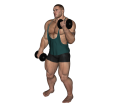 Zottman Curl - Standing Dumbbell Alternate
Zottman Curl - Standing Dumbbell Alternate
Benefits: This exercise does a good job of placing maximum tension on the biceps in the fully contracted position and also supinates the forearm.
Purpose: This exercise works the biceps muscles but focuses also on the brachioradialis (a muscle that crosses the elbow joint and assists in rotating the forearm).
Beginner Biceps Forearms Shoulders Strength Dumbbell Pull Gym
General Info: The biceps is a straight muscle with two heads. The long head of the biceps crosses both the elbow and the shoulder joint. It bends the elbow and raises the arm forward at the shoulder. The short head crosses the elbow joint and, in conjunction with the brachioradialis, supinates the hand.
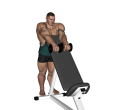 Zottman Curl - Standing Incline
Zottman Curl - Standing Incline
Benefits: This exercise works both heads of the biceps with a heavier weight than can typically be done with dumbbells.
Purpose: This exercise is used to target the biceps muscle to develop size, definition, strength, endurance and power.
Beginner Biceps Forearms Shoulders Strength Dumbbell Incline Bench Pull Gym
General Info: The biceps is a straight muscle with two heads. The long head of the biceps crosses both the elbow and the shoulder joint. It bends the elbow and raises the arm forward at the shoulder. The short head crosses the elbow joint and, in conjunction with the brachioradialis, supinates the hand.
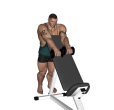 Zottman Curl - Standing Incline Alternate
Zottman Curl - Standing Incline Alternate
Benefits: This exercise does a good job of placing maximum tension on the biceps in the fully contracted position and also supinates the forearm.
Purpose: This exercise works the biceps muscles but focuses also on the brachioradialis (a muscle that crosses the elbow joint and assists in rotating the forearm).
Beginner Biceps Forearms Shoulders Strength Dumbbell Incline Bench Pull Gym
General Info: The biceps is a straight muscle with two heads. The long head of the biceps crosses both the elbow and the shoulder joint. It bends the elbow and raises the arm forward at the shoulder. The short head crosses the elbow joint and, in conjunction with the brachioradialis, supinates the hand.
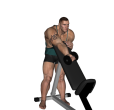 Zottman Curl - Standing Incline Single
Zottman Curl - Standing Incline Single
Benefits: This exercise does a good job of placing maximum tension on the biceps in the fully contracted position and also supinates the forearm.
Purpose: This exercise works the biceps muscles but focuses also on the brachioradialis (a muscle that crosses the elbow joint and assists in rotating the forearm).
Beginner Biceps Forearms Shoulders Strength Dumbbell Incline Bench Pull Gym
General Info: The biceps is a straight muscle with two heads. The long head of the biceps crosses both the elbow and the shoulder joint. It bends the elbow and raises the arm forward at the shoulder. The short head crosses the elbow joint and, in conjunction with the brachioradialis, supinates the hand.
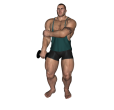 Zottman Curl - Standing Single Dumbbell
Zottman Curl - Standing Single Dumbbell
Benefits: This exercise does a good job of placing maximum tension on the biceps in the fully contracted position and also supinates the forearm.
Purpose: This exercise works the biceps muscles but focuses also on the brachioradialis (a muscle that crosses the elbow joint and assists in rotating the forearm).
Beginner Biceps Forearms Shoulders Strength Dumbbell Pull Gym
General Info: The biceps is a straight muscle with two heads. The long head of the biceps crosses both the elbow and the shoulder joint. It bends the elbow and raises the arm forward at the shoulder. The short head crosses the elbow joint and, in conjunction with the brachioradialis, supinates the hand.
 Zottman Curl - Standing Single Water Bottle
Zottman Curl - Standing Single Water Bottle
Benefits: This exercise works both heads of the biceps with a heavier weight than can typically be done with dumbbells.
Purpose: This exercise is used to target the biceps muscle to develop size, definition, strength, endurance and power.
Beginner Biceps Forearms Shoulders Strength Water Bottle Pull Home
General Info: The biceps is a straight muscle with two heads. The long head of the biceps crosses both the elbow and the shoulder joint. It bends the elbow and raises the arm forward at the shoulder. The short head crosses the elbow joint and, in conjunction with the brachioradialis, supinates the hand.
 Zottman Curl - Standing Water Bottle
Zottman Curl - Standing Water Bottle
Benefits: This exercise works both heads of the biceps with a heavier weight than can typically be done with dumbbells.
Purpose: This exercise is used to target the biceps muscle to develop size, definition, strength, endurance and power.
Beginner Biceps Forearms Shoulders Strength Water Bottle Pull Home
General Info: The biceps is a straight muscle with two heads. The long head of the biceps crosses both the elbow and the shoulder joint. It bends the elbow and raises the arm forward at the shoulder. The short head crosses the elbow joint and, in conjunction with the brachioradialis, supinates the hand.
 Zottman Curl - Standing Water Bottle Alternate
Zottman Curl - Standing Water Bottle Alternate
Benefits: This exercise works both heads of the biceps with a heavier weight than can typically be done with dumbbells.
Purpose: This exercise is used to target the biceps muscle to develop size, definition, strength, endurance and power.
Beginner Biceps Forearms Shoulders Strength Water Bottle Pull Home
General Info: The biceps is a straight muscle with two heads. The long head of the biceps crosses both the elbow and the shoulder joint. It bends the elbow and raises the arm forward at the shoulder. The short head crosses the elbow joint and, in conjunction with the brachioradialis, supinates the hand.
Could not find your favorite exercise in the list? Please start a discussion and post the name and the list of steps. We will try to add it as soon as we can.